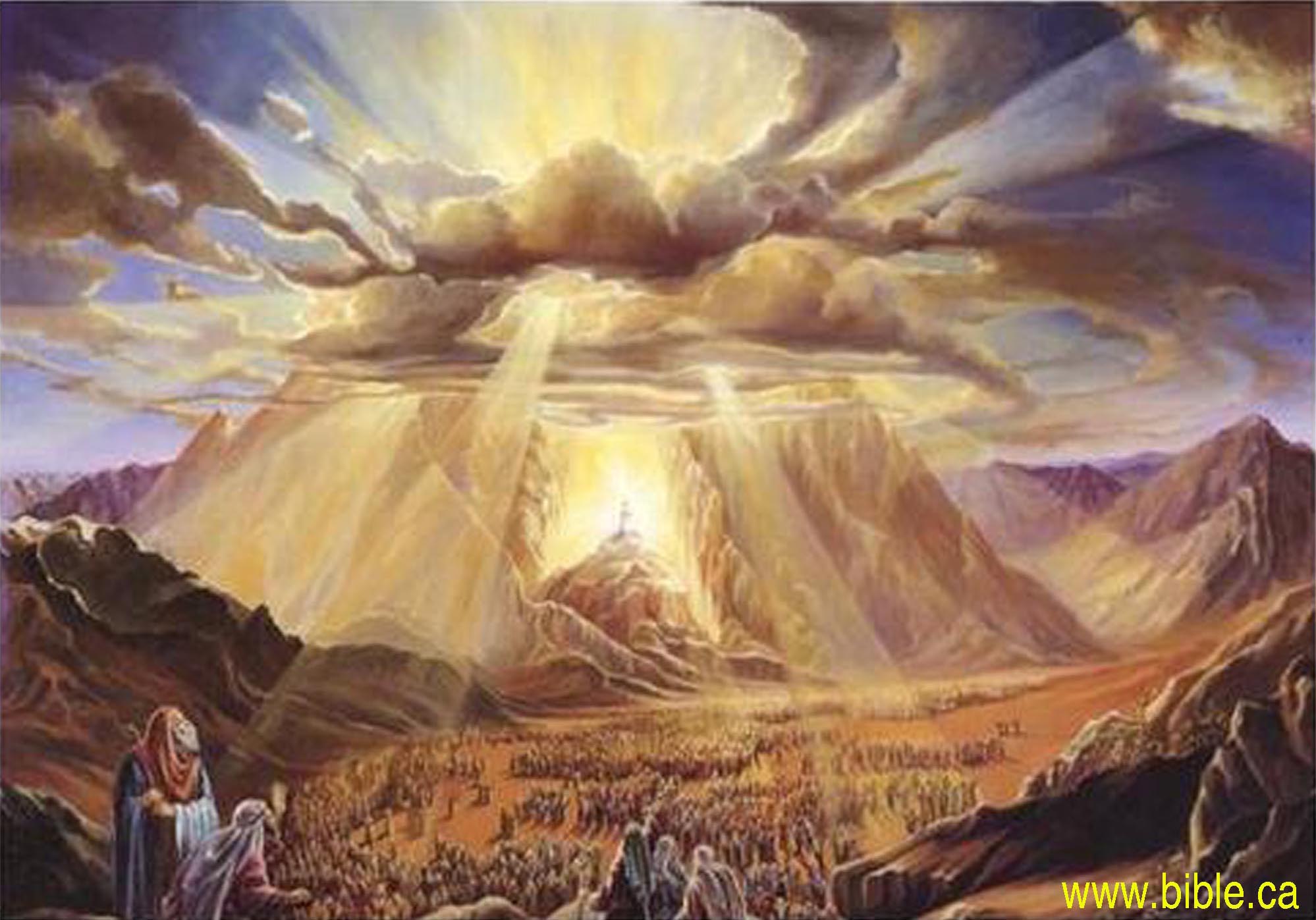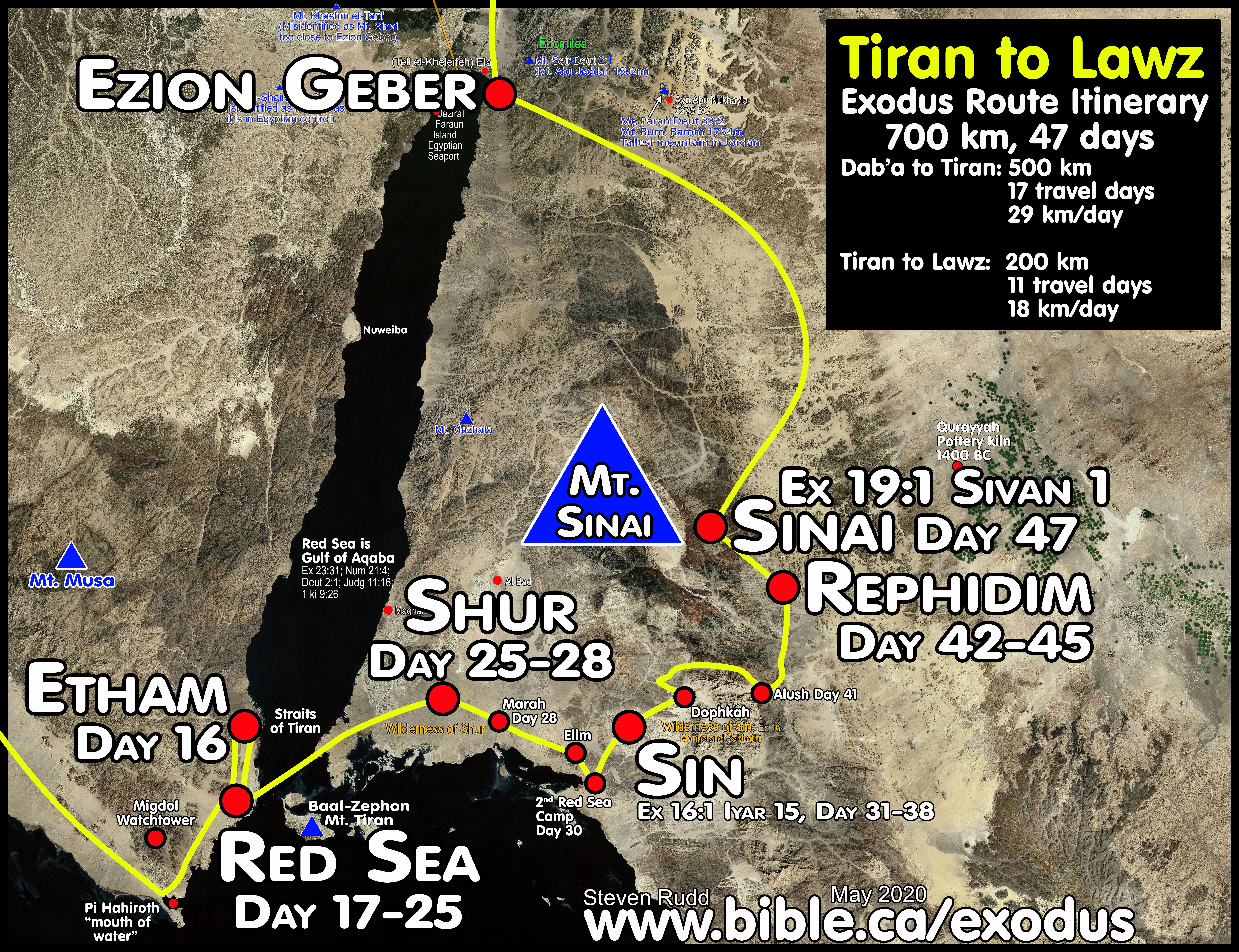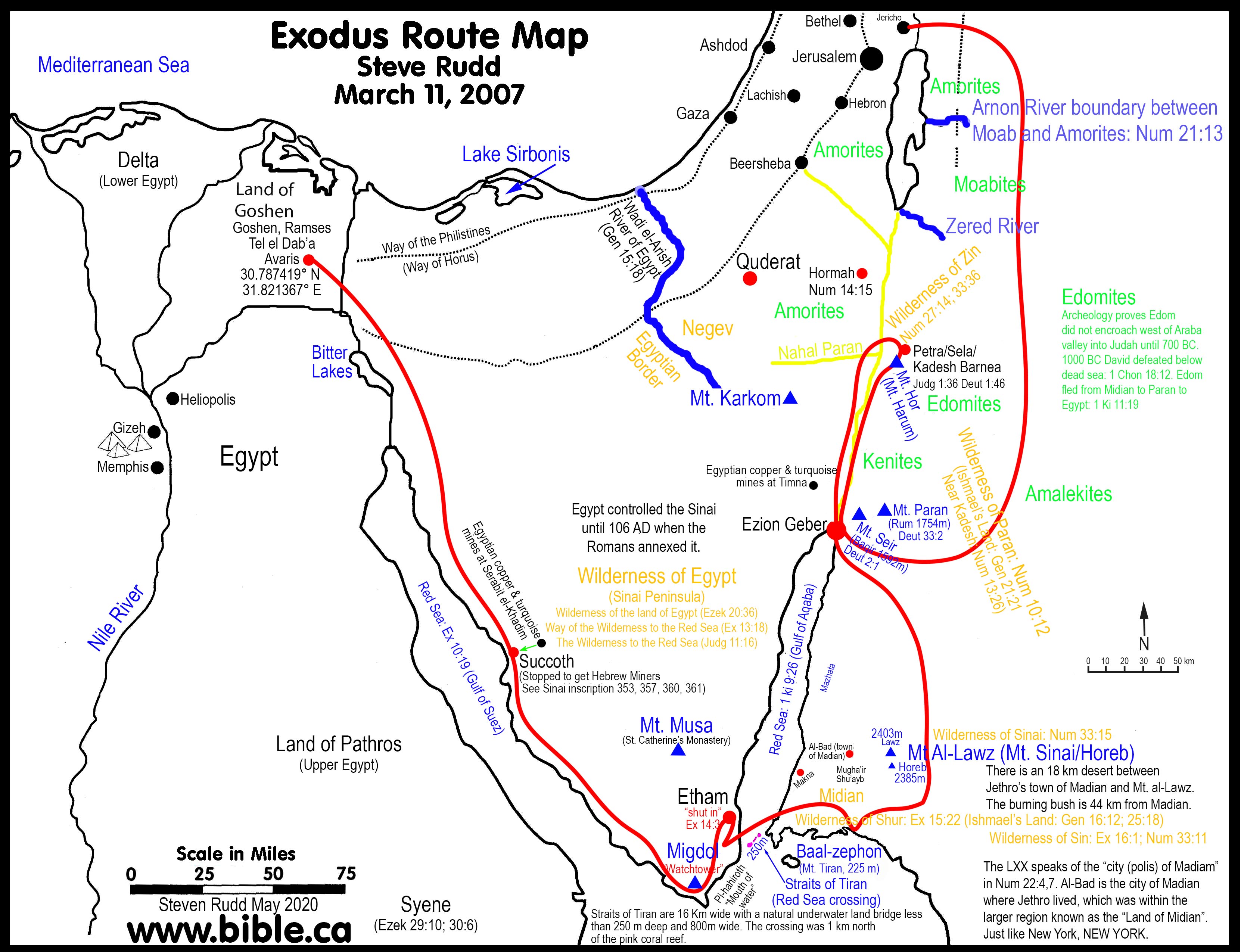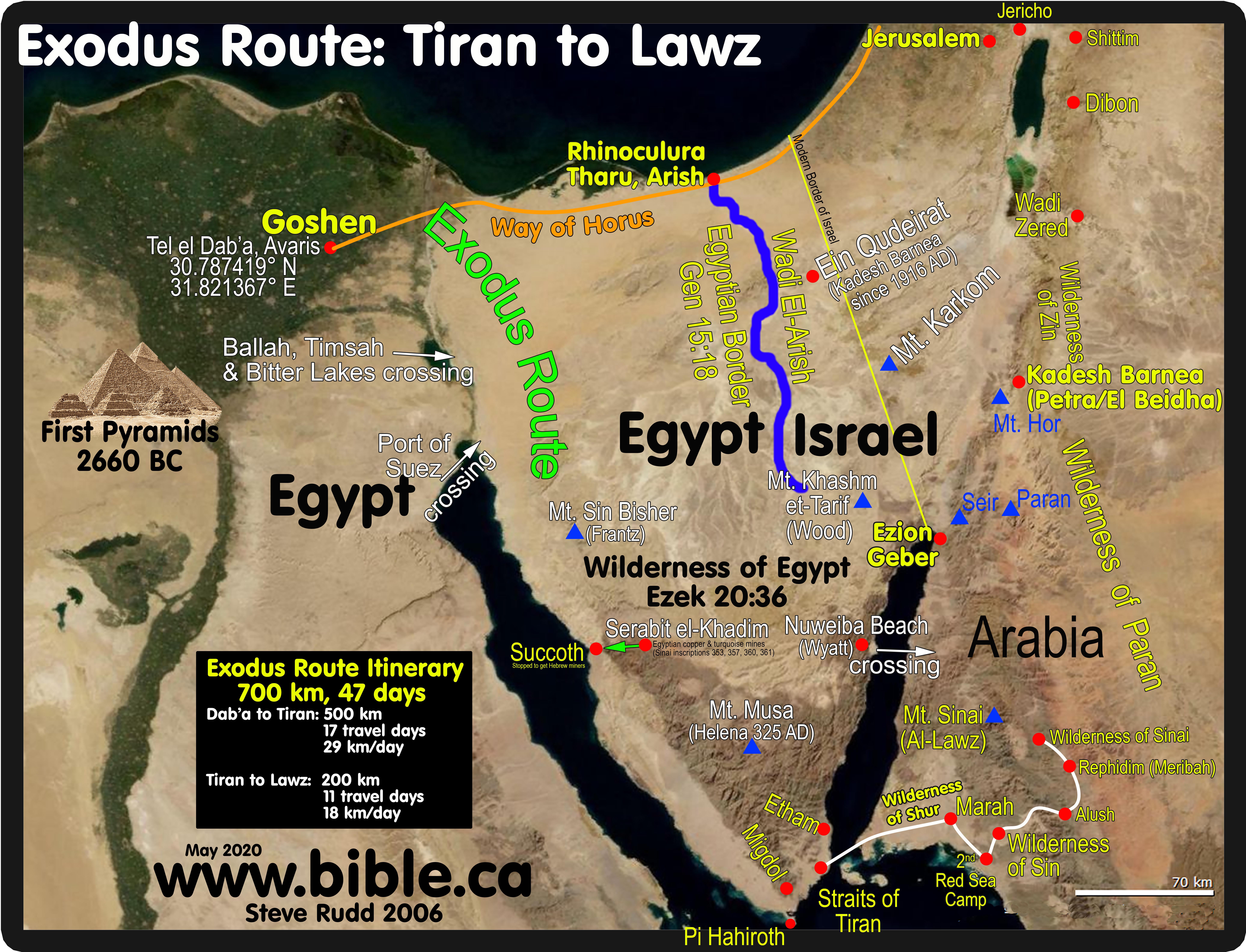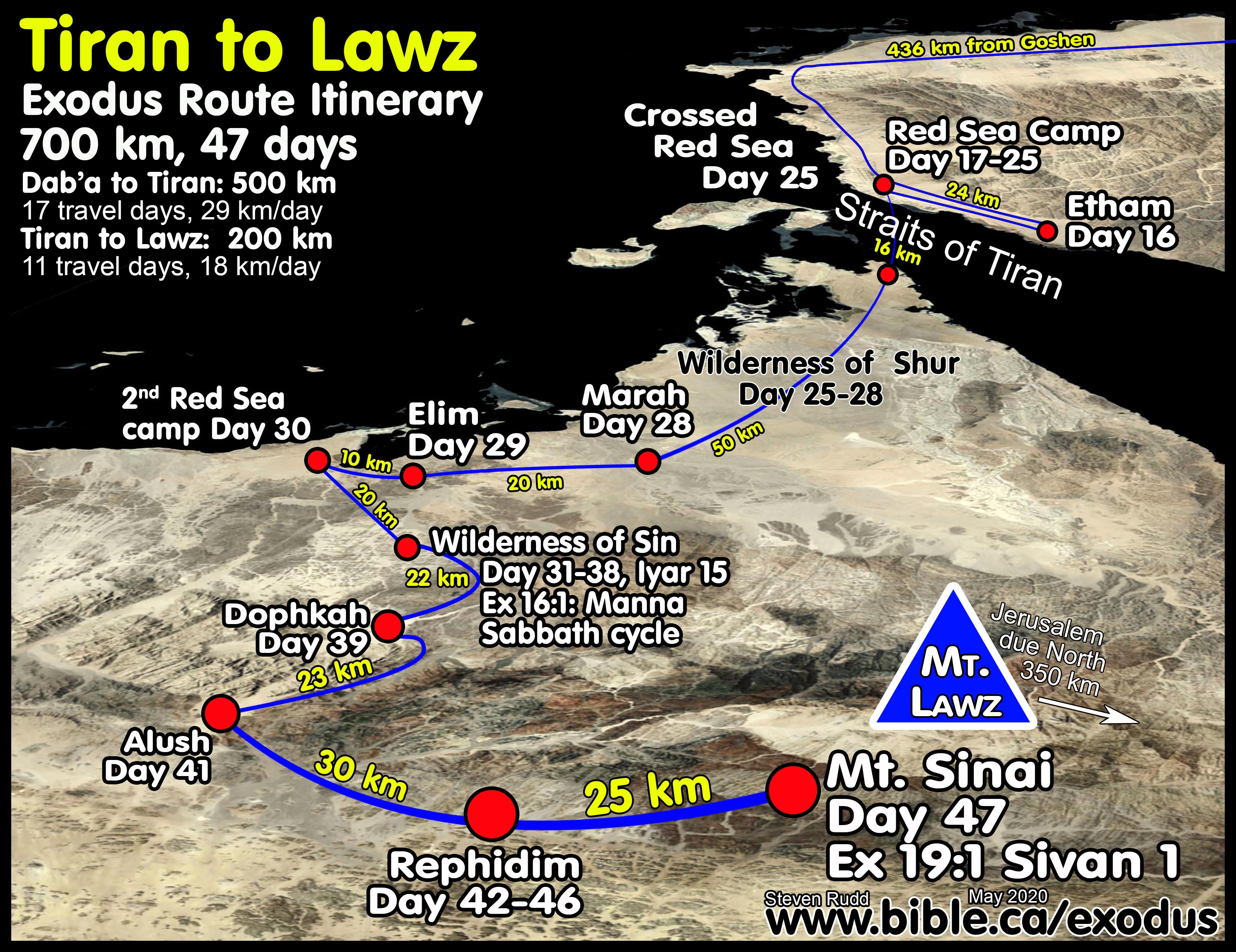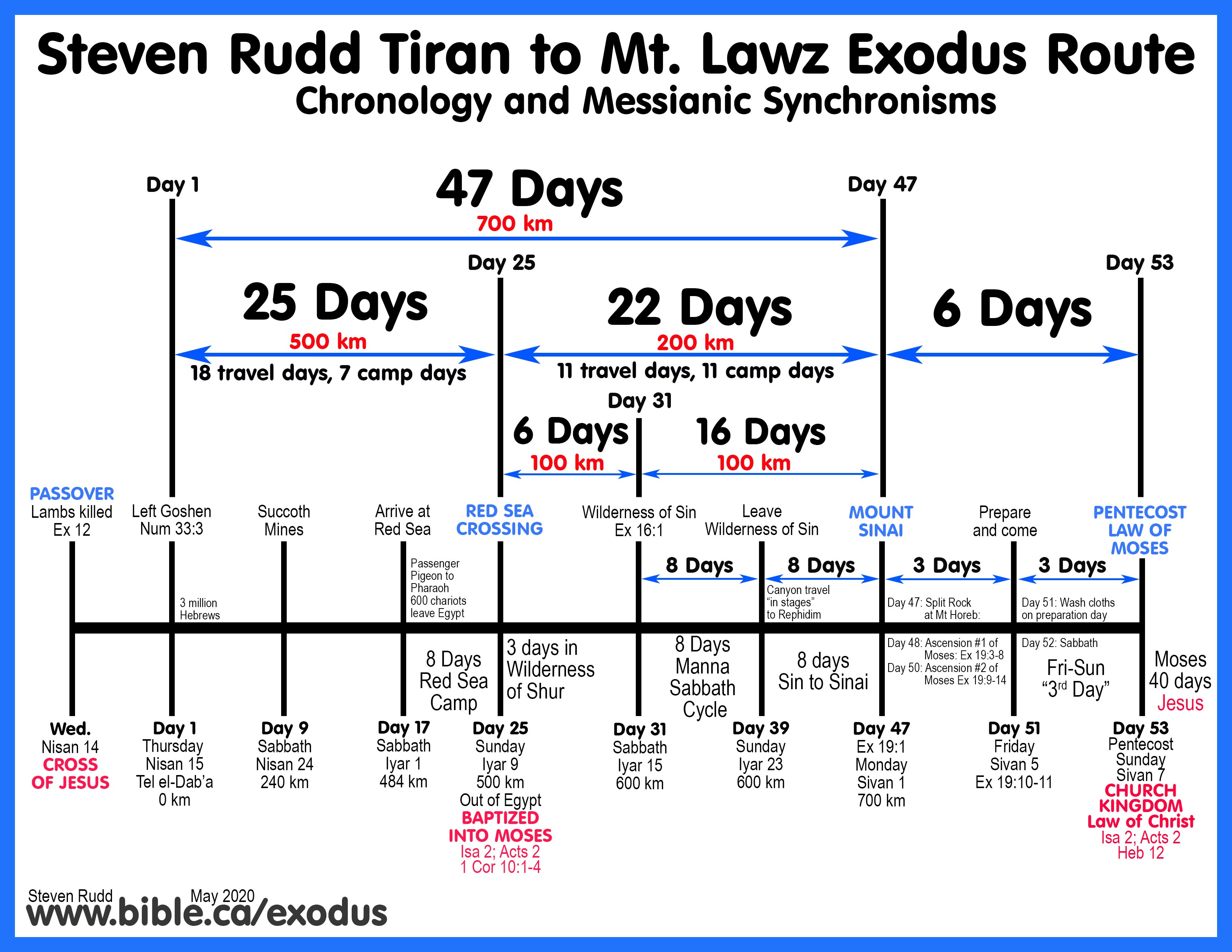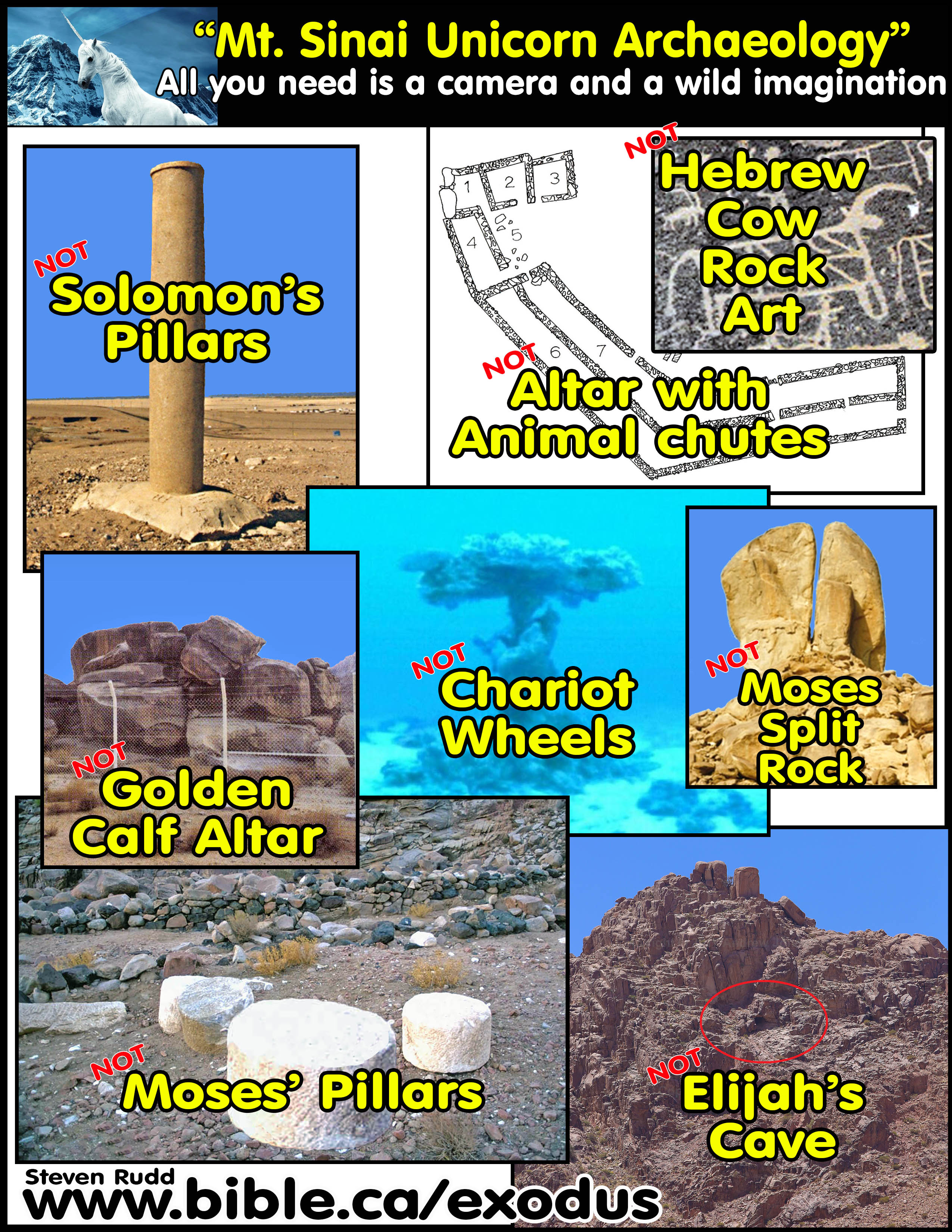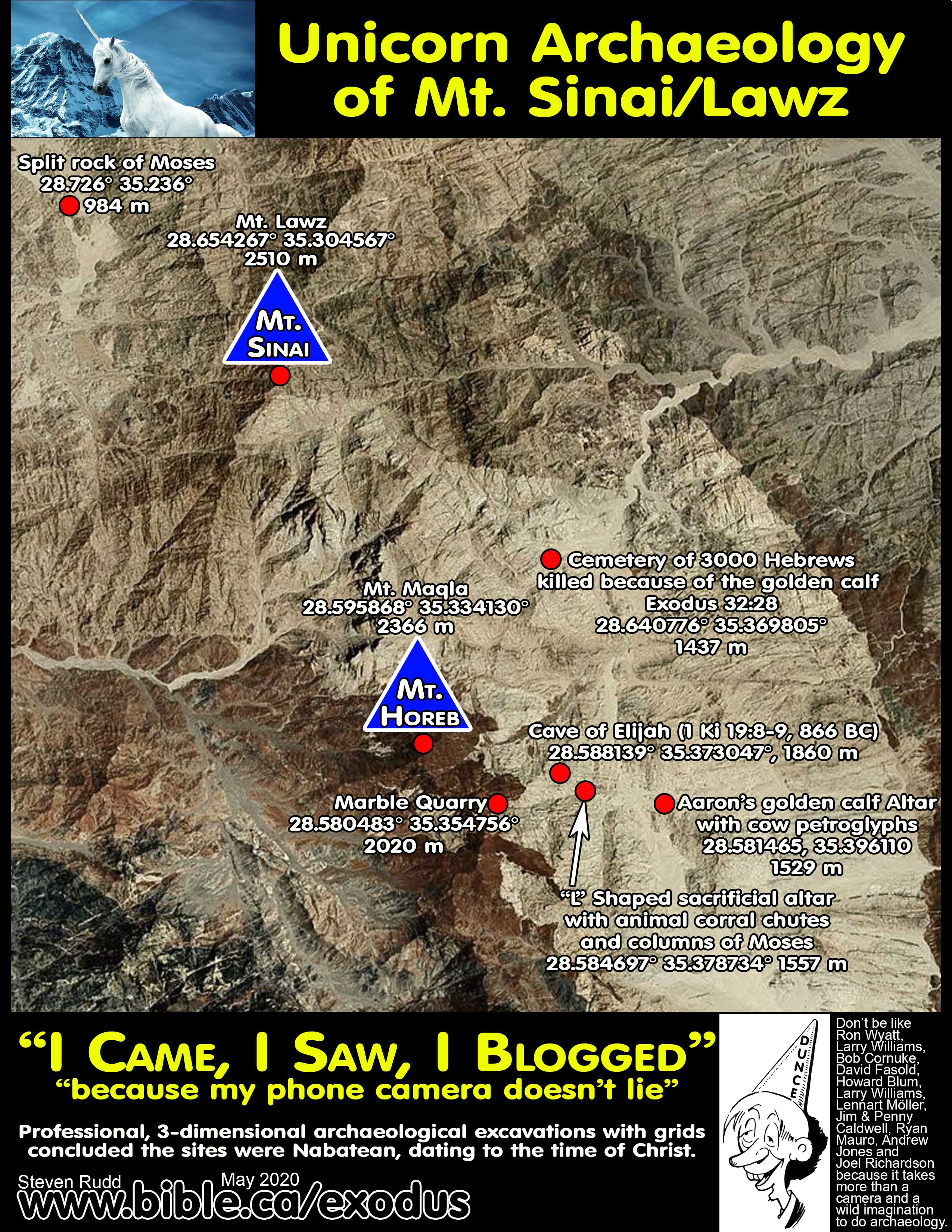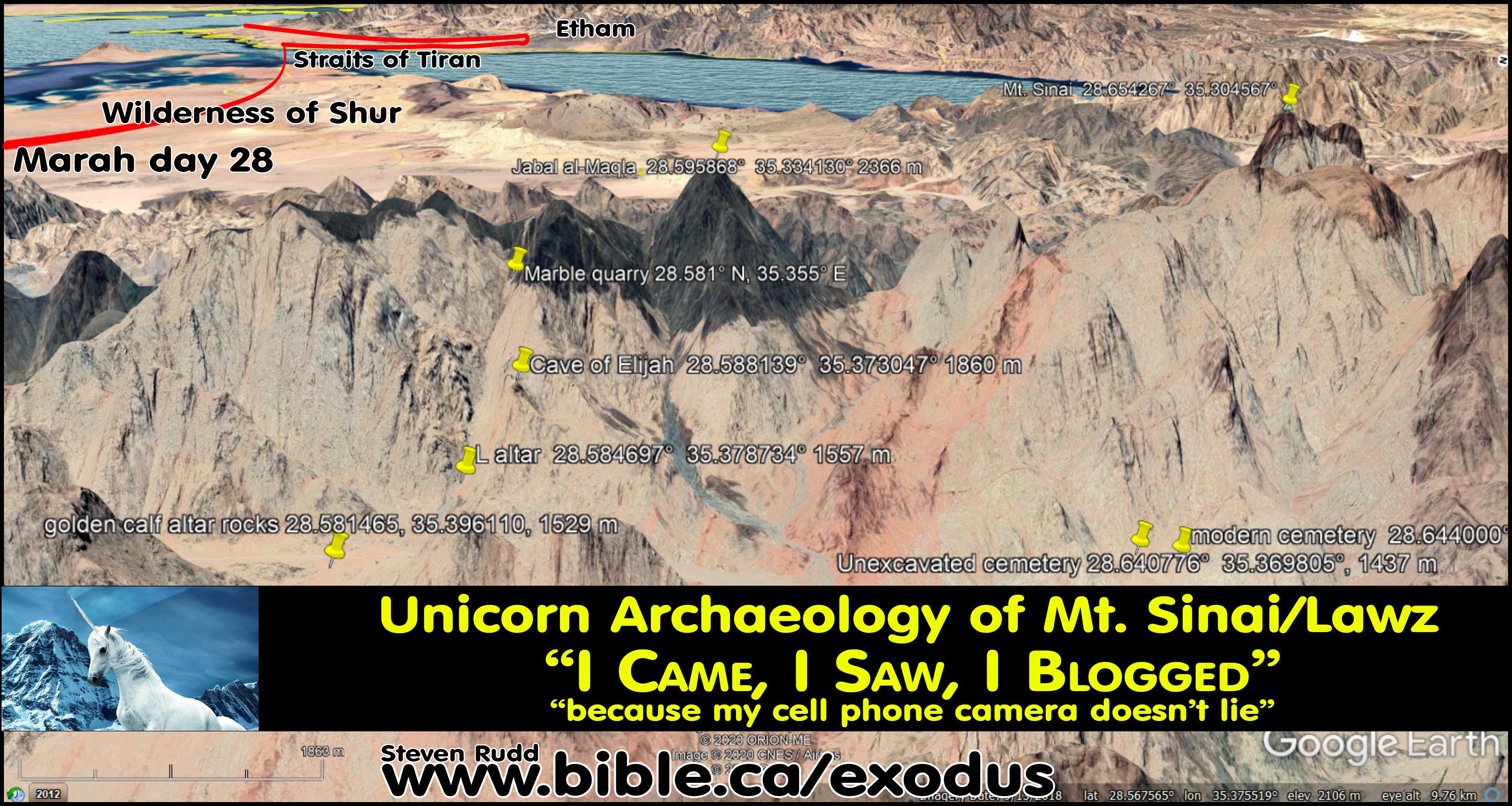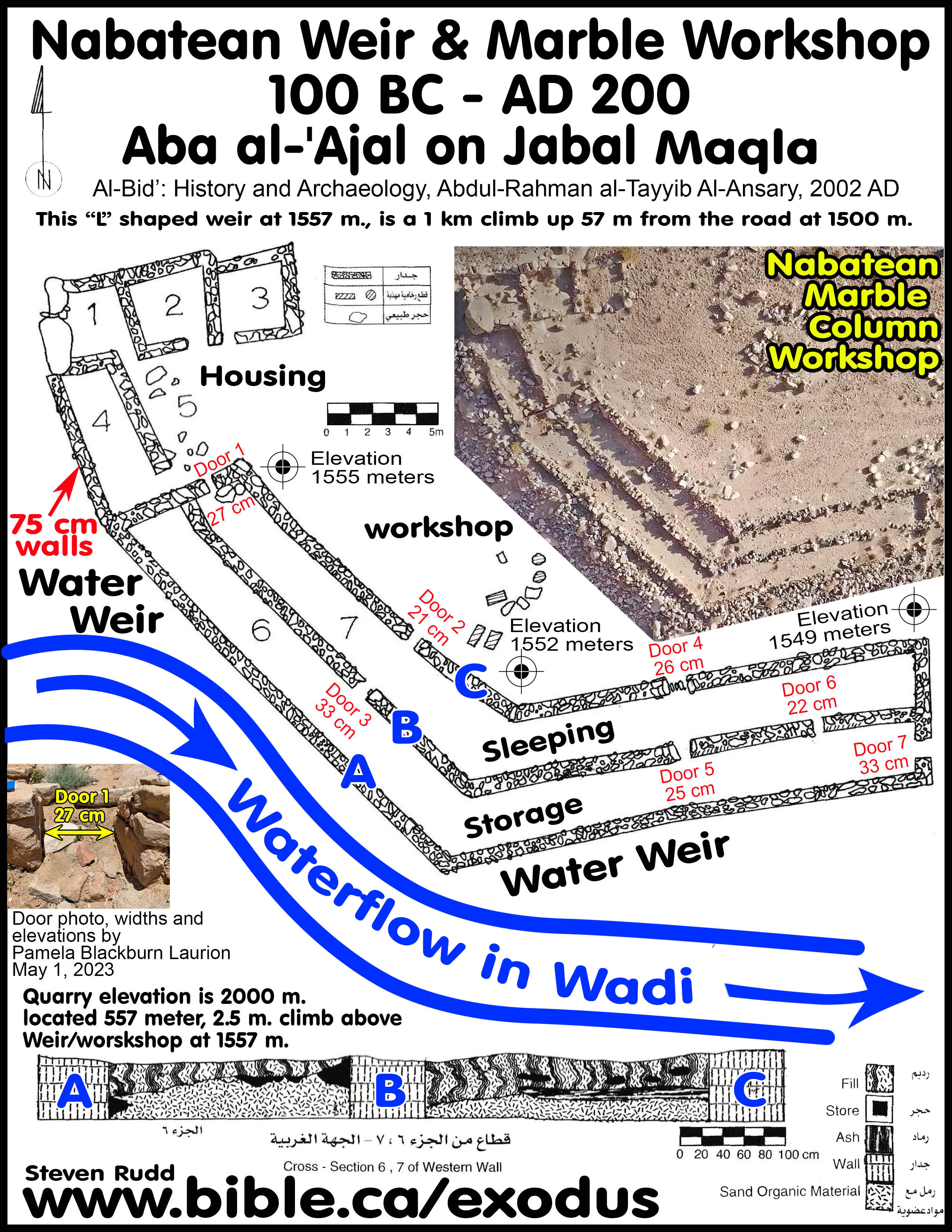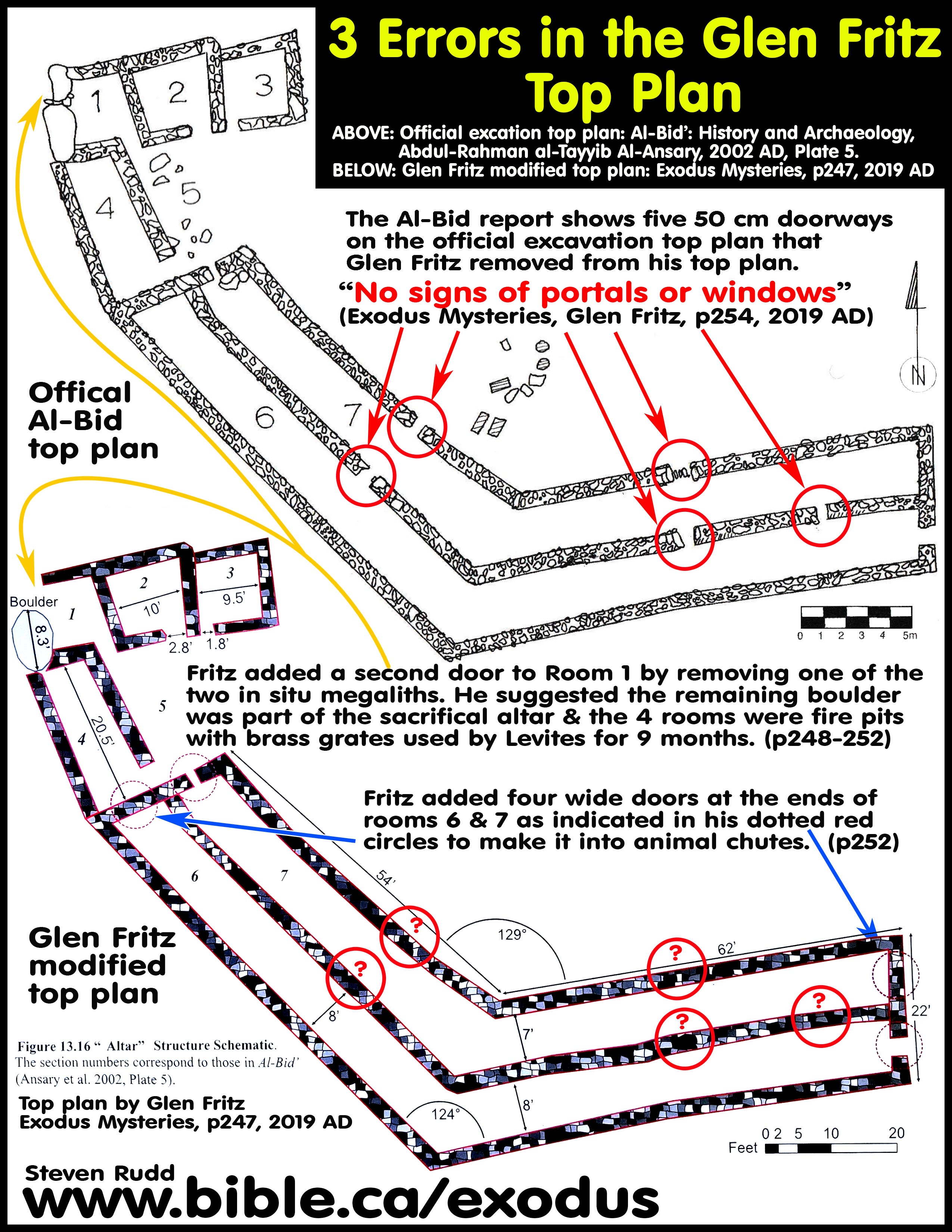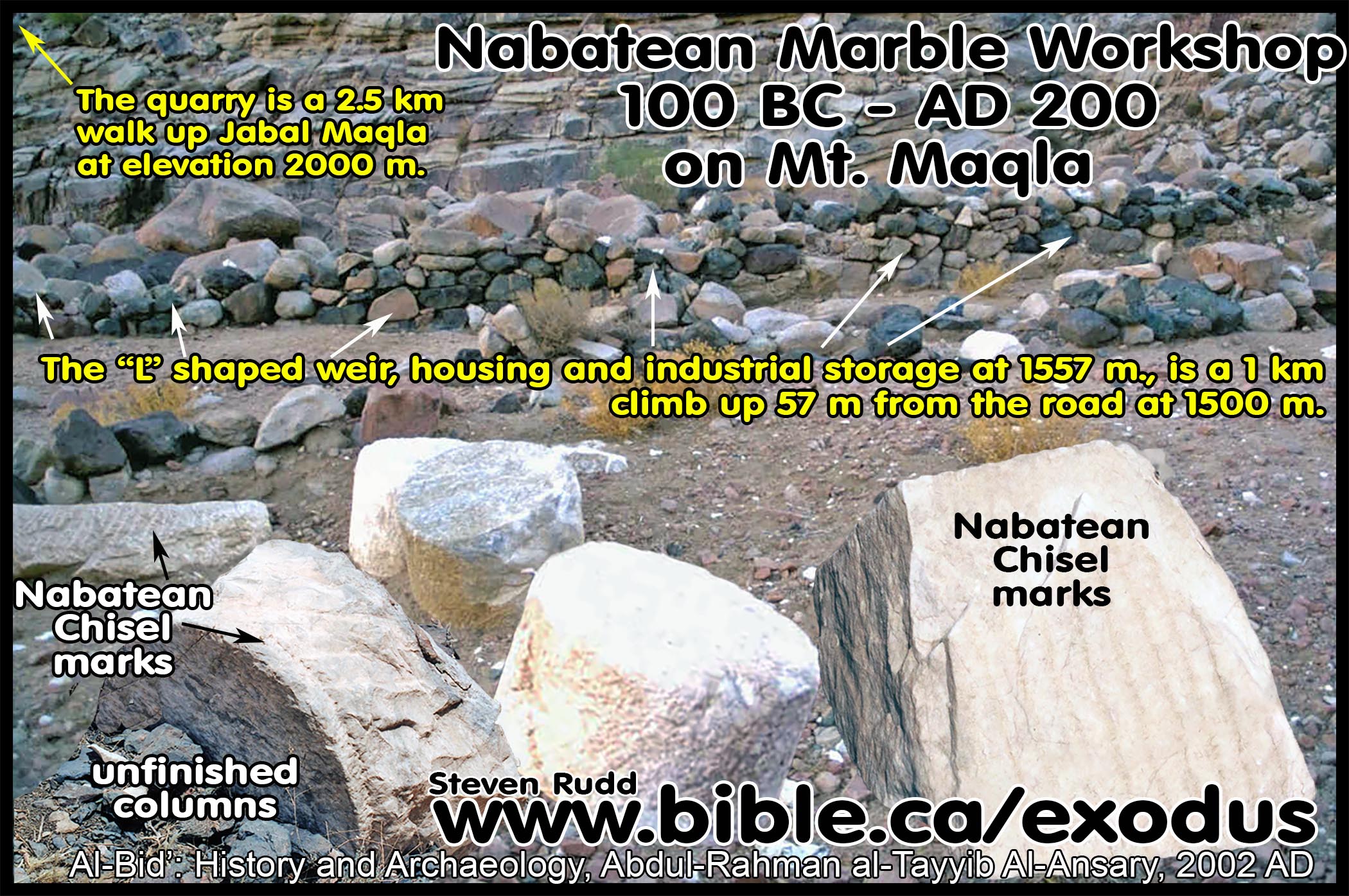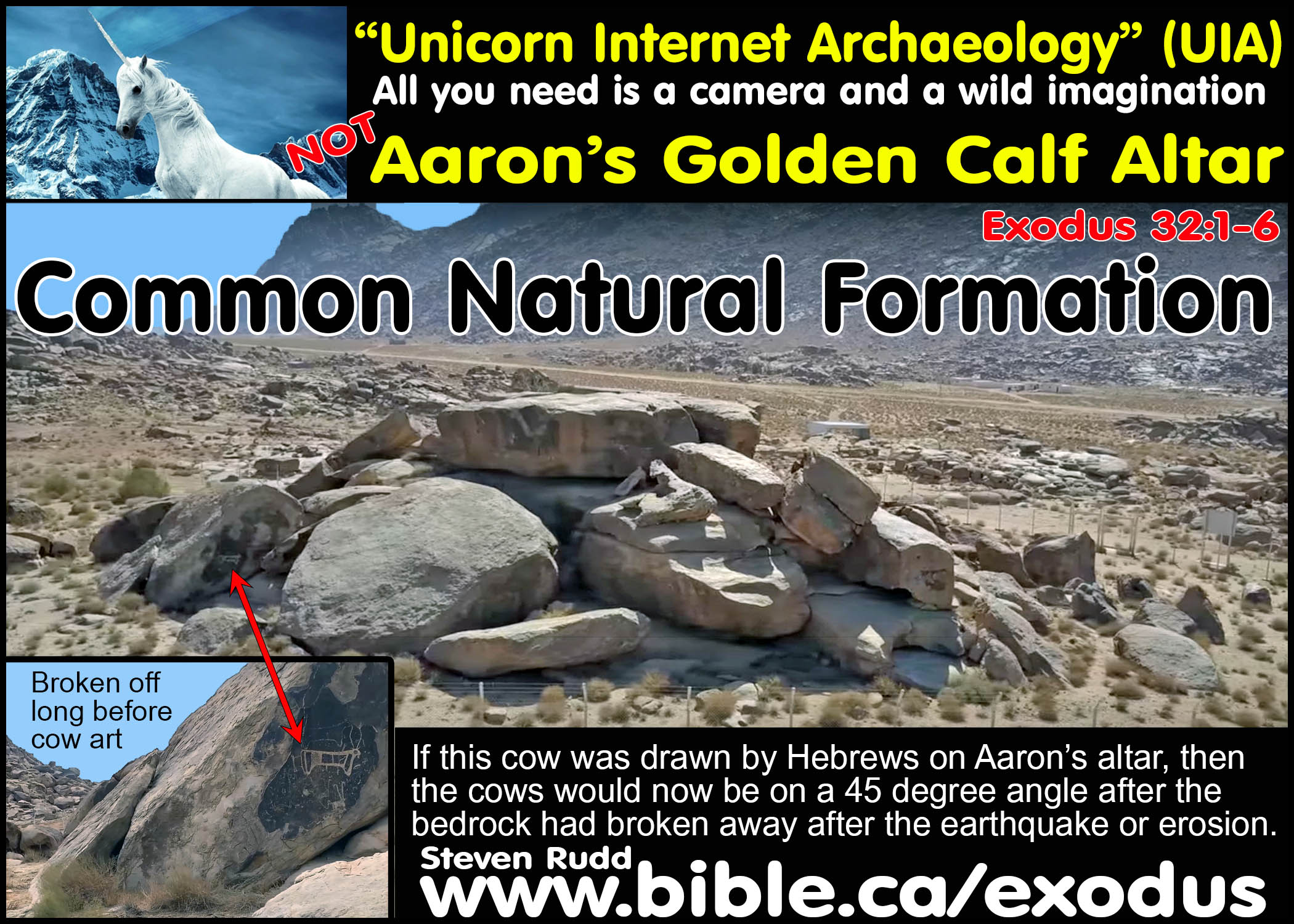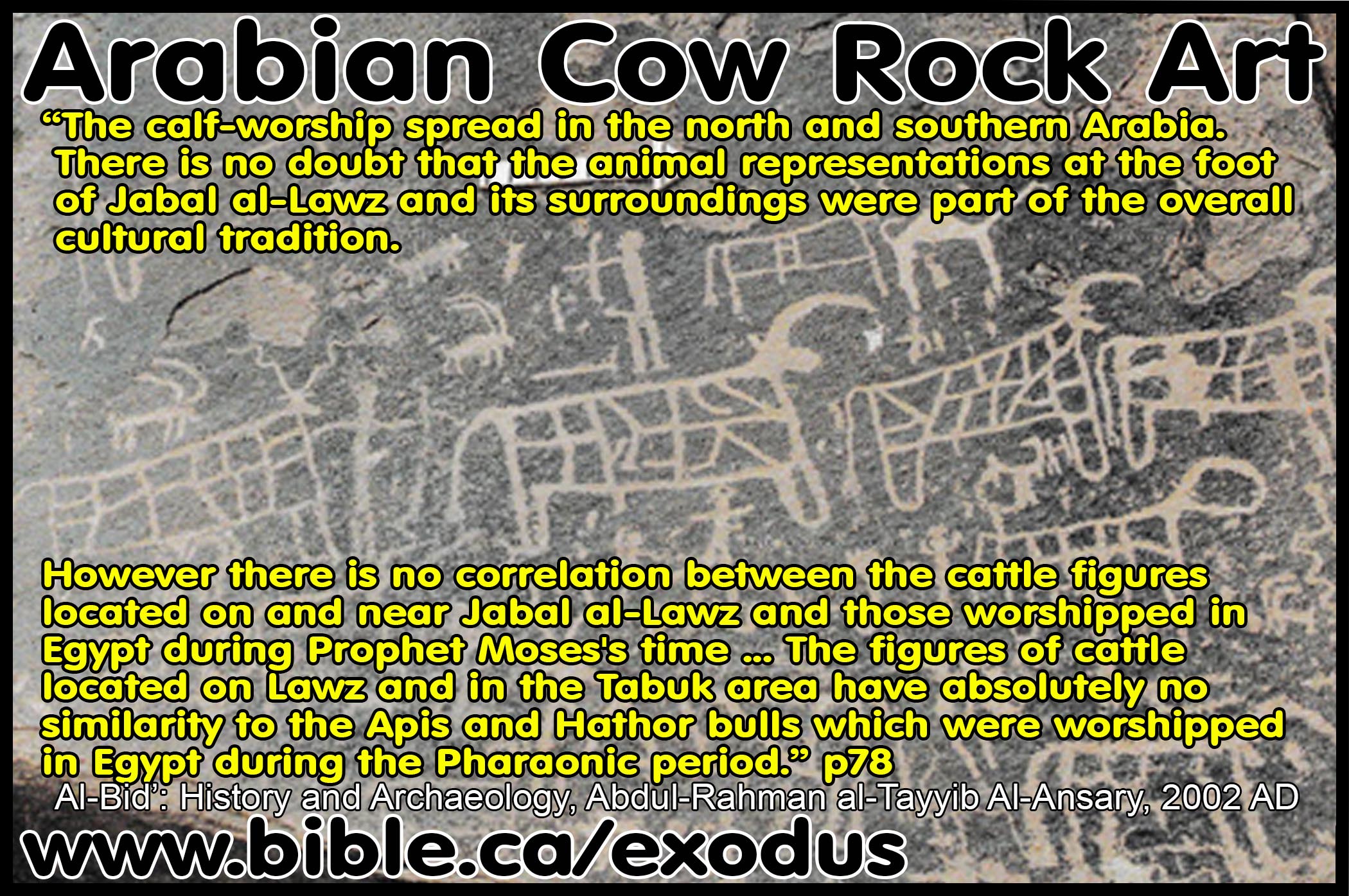Exodus Route: The Archaeology of Mt. Lawz, Maqla as Mt. Sinai, Horeb
|
|
The Archaeology of Jebel Lawz as Mt. Sinai and Jebel Maqla as Horeb
|
|
Exodus locations:
|
Introduction:
1. We can prove from the Bible alone that Mt. Sinai is in Arabia, not the Sinai Peninsula or the Negev.
a. The timing of the journey shows Israel crossed the Red Sea on about day 25 from Goshen.
b. The association of Mt. Sinai with Ishmael whose homeland was Midian.
2. We propose Jebel al-Lawz (Mt. Lawz) as Mt. Sinai. At 2,580 meters, Lawz is the tallest mountain in northern Arabia. There are two reasons why we chose Mt. Lawz as Mt. Sinai.
a. First, it is in Arabia.
b. Second, Josephus said Mt. Sinai was the tallest mountain in the region near Midian.
3. Arguments against Al-Lawz, refuted:
- False argument: "Mt. al-Lawz was not Jethro's own county, although only 18 Km away. This proves Moses was near the traditional Mt. Sinai at Mt. Musa."
- Why would the Amalekites attack in Midian? Explained The Amalekites lived Transjordan and not in the wilderness of Egypt (Sinai Peninsula)
4.
The Hebrew camp was about 10 km due east from the foot of the mountain.
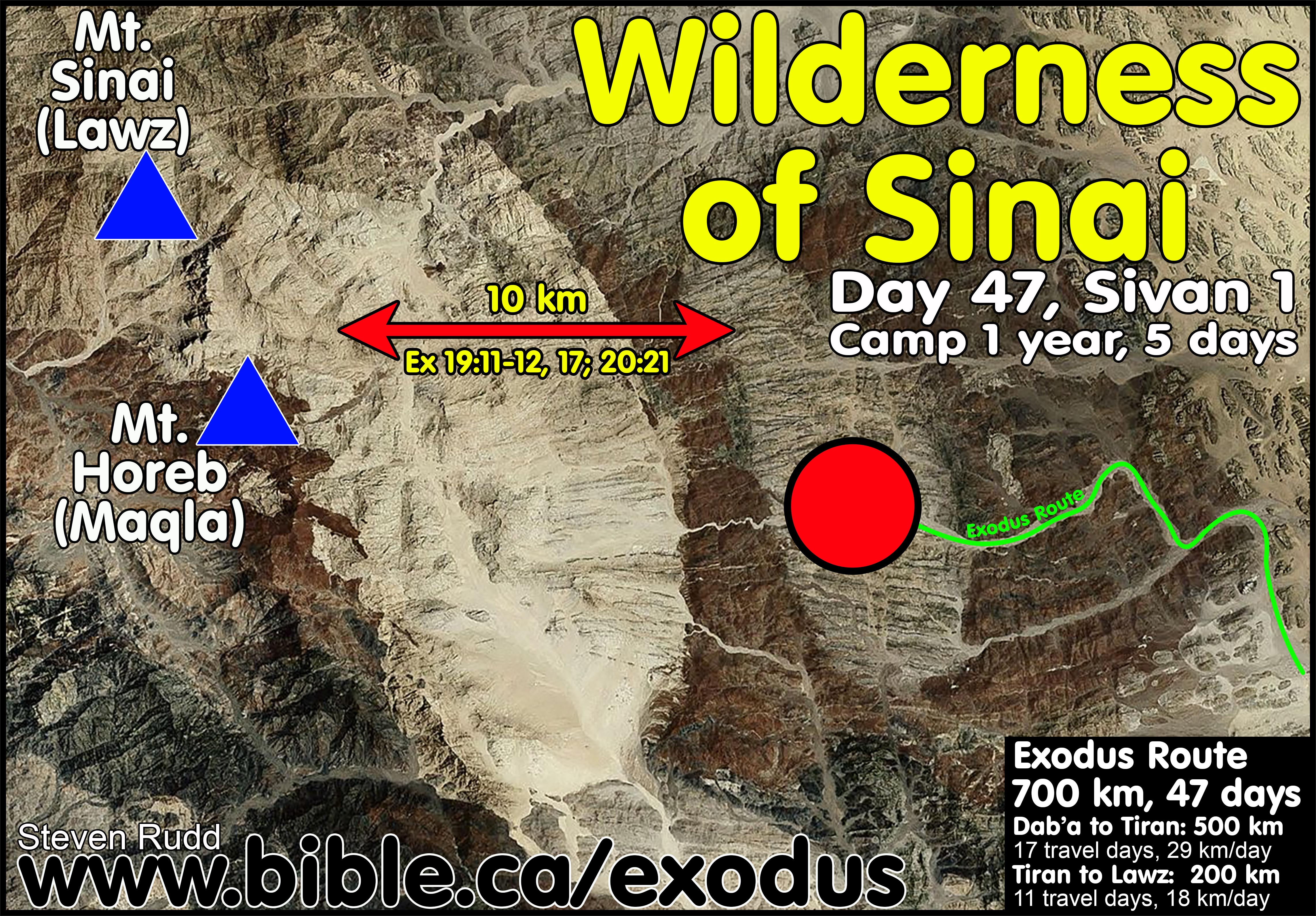
a. "let them be ready for the third day, for on the third day the Lord will come down on Mount Sinai in the sight of all the people. You shall set bounds for the people all around, saying, 'Beware that you do not go up on the mountain or touch the border of it; whoever touches the mountain shall surely be put to death." Exodus 19:11-12
b. Moses went into the wilderness of Sinai and the people journeyed to the foot of Mt. Sinai: "And Moses brought the people out of the camp to meet God, and they stood at the foot of the mountain." Exodus 19:17
c. Even at the foot of the mountain they were still some distance from the edge of the mountain: "So the people stood at a distance, while Moses approached the thick cloud where God was." Exodus 20:21
d. All this leads us believe that the Hebrew camp in the wilderness of Sinai was likely 10 km due east from the foot of the mountain.
5.
The Wilderness of Sinai is identical to the location of the 11-month
camp at Mt. Sinai:
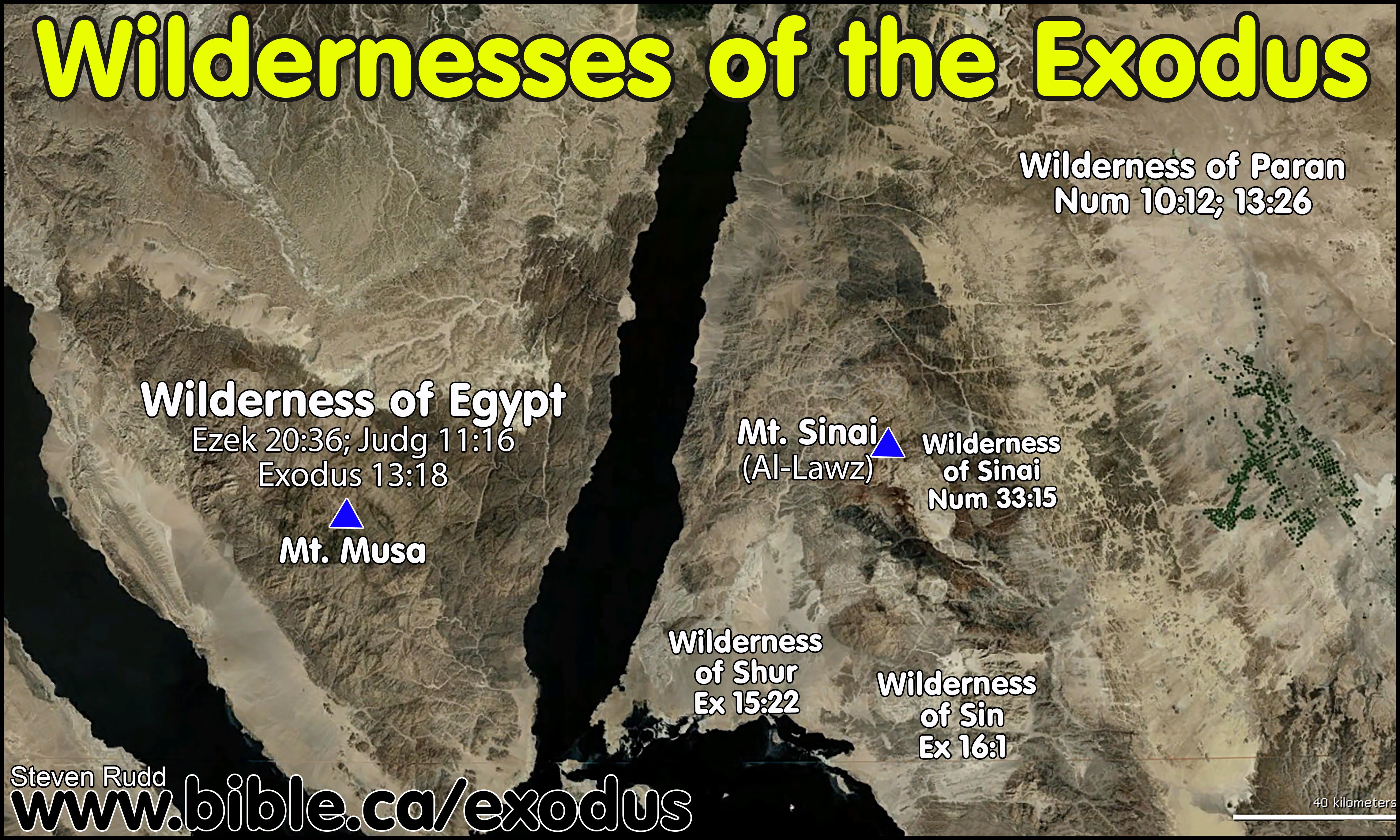
a.
It was a 47-day journey from Goshen to Mt. Sinai: Ex 19:1. The
Wilderness of Sinai was the last stop of the Exodus where Israel camped for 11
months and 5 days:
Scripture never says Israel camped in the Wilderness of Sinai then journeyed to
the foot of Mt. Sinai.
b. Instead scripture equates the wilderness of Sinai as being equal to the final camp in front of Mt. Sinai.
c. "In the third month after the sons of Israel had gone out of the land of Egypt, on that very day they came into the wilderness of Sinai. When they set out from Rephidim, they came to the wilderness of Sinai and camped in the wilderness; and there Israel camped in front of the mountain." (Exodus 19:1–2)
d. In the Numbers 33 itinerary, the Wilderness of Sinai was the final camp spot for 11 months at Mt. Sinai: "They journeyed from Rephidim and camped in the wilderness of Sinai. [11 months, 5 days pass] They journeyed from the wilderness of Sinai and camped at Kibroth-hattaavah." (Numbers 33:15–16)
e. Moses saw the burning bush in the wilderness of Sinai. The burning bush probably marked the spot where Israel would camp several month later after Moses returns with the Hebrews. “After forty years had passed, an angel appeared to him in the wilderness of Mount Sinai, in the flame of a burning thorn bush." (Acts 7:30)
f. The west side of the Wilderness of Sinai was at the foot of Mt. Horeb: "Now Moses was pasturing the flock of Jethro his father-in-law, the priest of Midian; and he led the flock to the west side of the wilderness and came to Horeb, the mountain of God. The angel of the LORD appeared to him in a blazing fire from the midst of a bush; and he looked, and behold, the bush was burning with fire, yet the bush was not consumed." (Exodus 3:1–2)
g. The 11-month camp at Mt. Sinai was identical to the camp in the Wilderness of Sin.
6. Glen Fritz makes five critical chronological errors in his Nuweiba crossing exodus route:
a. Fritz miscalculates the entire journey as 61 days instead of the correct 47 days as per Ex 19:1. It is 47 days from Nisan 15 to Sivan 1 but Fritz misinterprets it as a 61 day journey to Sivan 15. Ex 19:1 speaks of the first siting of the new moon marking the first day of the third month, not the 15th day of the third month. All ancient literary sources, including Josephus, are unanimous in confirming a 47-day period from Goshen to Sinai.
b. Fritz misinterprets the chronological marker in Ex 19:1 as being at a geographic location that 3 days short of final camp spot at Mt. Sinai. Fritz marks 61 days from Goshen to the Wilderness of Sinai, then 3-4 more days to reach the final camp at in front of Mt. Sinai. Scripture never says Israel camped in the Wilderness of Sinai then journeyed to the foot of Mt. Sinai. Instead scripture equates the wilderness of Sinai as being equal to the final camp in front of Mt. Sinai. "In the third month after the sons of Israel had gone out of the land of Egypt, on that very day they came into the wilderness of Sinai. When they set out from Rephidim, they came to the wilderness of Sinai and camped in the wilderness; and there Israel camped in front of the mountain." (Exodus 19:1–2) In the Numbers 33 itinerary, the Wilderness of Sinai was the final camp spot for 11 months at Mt. Sinai: "They journeyed from Rephidim and camped in the wilderness of Sinai. [11 months, 5 days pass] They journeyed from the wilderness of Sinai and camped at Kibroth-hattaavah." (Numbers 33:15–16) It is unclear why Fritz would fabricate an extra stop in his itinerary not found in scripture. At 888 km, the Fritz Nuweiba route is so long, perhaps he knew he needed the additional 3 days to make it viable to reach Sinai by day 64 at the latest.
c. Fritz ignores the 7-day camp on the Nuweiba beech waiting for pharaoh. Although Fritz is correct that Israel arrived at the Nuweiba beech on day 17, he has Israel cross the Red Sea on day 18. Fitz not only ignored the time it would take for a messenger to be sent to Egypt after Etham (Day 15), he also ignores the time for Pharaoh to read the message and travel to the Nuweiba beech. In Fritz’s flawed formulation, Israel has already left the wilderness of Sin about the time pharaoh arrives at the Nuweiba beech.
d. Fritz has Israel arriving at the Wilderness of Sin on day 30 after leaving Goshen, apparently unaware that Nisan 15 to Iyar 15 calculates to 31 days in a 30-day lunar calendar. According to Ex 16:1, Israel arrived in the Wilderness of Sin on day 31 from Goshen. A 30-day Hebrew month is confirmed by Josephus in Antiquities 2.316 when he says Israel had 30 days of food, meaning they ran out on the 31st day when they entered the Wilderness of Sin. It is also possible to have up to 4 consecutive 30-day lunar months. Although Fritz transposed the two numbers 30 and 31, his route is still 61 days total, but it is 31 days from Goshen to the Wilderness of Sin in Ex 16:1 (Nisan 15 to Iyar 15) and 30 days more days to the wilderness of Sinai in Ex 19:1 (Iyar 16 to Sivan 1).
e. Fritz ignores the 8-day camp at the Wilderness of Sin as a vehicle to learn the Sabbath/Manna cycle. He has Israel leaving the day after they arrive. Ex 17:1 say that only after all the events of Ex 16 had happened, including the first Sabbath after 6 days of Manna, did Israel leave the Wilderness of Sin.
7. Ignore Unicorn Internet Archaeologists (UIA):
a. Ignore 100% of archaeological claims made by any of these “Unicorn Archaeologists”: Ron Wyatt, Larry Williams, Bob Cornuke, David Fasold, Howard Blum, Larry Williams, Lennart Möller, Jim Caldwell, Penny Caldwell, Ryan Mauro, Andrew Jones, Joel Richardson.
b. It takes more than a pocket camera and a wild imagination to do professional archeology. The sites are first century BC Nabatean
c. The internet is filled with their ridiculous and false archeological claims at Mt. Lawz and Mt. Maqla and all of it should be ignored.
d. This author is a professional staff archeologist at Shiloh, Israel and these men have done incredible damage to truth and made a mockery of Christianity and the Bible.
|
Part 1: Biblical, geographical, chronological details of Mt. Sinai at Mt. Lawz: |
A. Biblical and ancient literary sources confirm a 47-day journey from Goshen to Sinai:
1. Exodus 19:1 tells us they ended the trip when they reached the Wilderness of Sinai on the 1st day of the third month (Sivan 1) "In the third month (Sivan 1) after the sons of Israel had gone out of the land of Egypt, on that very day [i.e. new moon] they came into the wilderness of Sinai." Exodus 19:1
2. The Bible tells us that it was a 47-day journey from Goshen to Sinai. They left Goshen on Passover (15th day of the first month) and arrived at the Wilderness of Sin on the 15th day of the second month and arrived at the Wilderness of Sinai on the 1st day of the third month. This equals 47 days with two consecutive lunar months.
a. Since the Law of Moses was given on Pentecost, this means that they arrived on the first day of the third month, not the 15th day of the third month.
b. “On that very day (19:1b) points emphatically to the day of the new moon, the first day of the new lunar month, and not the whole first month (as NIV has it). This expression also recalls the time designations on this very day (12:17) and that very day (12:51), expressions almost identical to the one here.” (Believers Church Bible Commentary, Waldemar Janzen, Exodus 19:1, 2000 AD)
c. “On the third new moon the closer definition “on that very day” shows that Hebrew ḥodesh, usually “month,” is here used in its original sense of “new moon.”” (Exodus, Jewish Publication Society, Nahum M. Sarna, Ex 19:1, 1991 AD)
3. A 30-day Hebrew month is confirmed by Josephus in Antiquities 2.316 when he say they had 30 days of food, meaning they ran out on the 31st day when they entered the Wilderness of Sin (Ex 16:1).
a. “The lunar calendar measured time by lunations; a lunation is the interval of time, expressed in days, between two successive new moons. Each lunar month, beginning when the thin crescent of the new moon first becomes visible at dusk, averages just over 29½ days. The moon actually orbits the earth in about 27⅓ days; because the earth is meanwhile moving around the sun, it takes the moon 2 extra days to come to the same position between the sun and earth and produce a “new moon.”” (Baker Encyclopedia of the Bible, Calendars, p 400)
b. It is also possible to have up to 4 consecutive 30 day lunar months:
i. Nisan, Iyar and Sivan were 30 day lunar months: “the lunar year is divided into twelve months: 1–3, 7–9 have 30 days; 4–6, 10–12 have 29” (AYBD, Calendars, vol 1, p 818)
ii. “Now, I want to assume that every month thereafter is 30 days long. (That is what we are looking for – can there be 5, consecutive, 30-day months?) So looking at the data, we see everything is fine – as annotated by “OK” in the far-right column till we see that the 5th consecutive 30-day month has added up to 150 days, yet the “real” moon has added up only to 148.753 days (that is, the real months can be no more than 149 days when rounded to whole days for calendar purposes), so our calendar is 1 day ahead if we insist on a 30-day month that last lunation (the red one – 30 days). But what we see is that that last calendar month must instead be 29 days so our calendar total is 149 to match the “real” moon of 148.753 days (rounded to 149) in 5 months. This illustrates that it is possible only to have 4 consecutive 30-day months and the calendar still works. … The conclusion: That no, five, consecutive lunations can exceed 148.88 days. So if the month you stared with was itself a 30-day month, then the 5th lunation including that starting 30-day month, will end up no greater than 148.88 days long, thus, you’d find that only 3 months after the 30-day month in which you began, you’d be forced to follow it with a 29 day, 5th month, to keep the calendar in-sync with the real moon.” (On the possibility of 5 consecutive 30-day months, William J. Welker, 2015 AD)
4. The 47-day journey predated Christianity by 200 years and is not a “late Rabbinic tradition” as Fritz and other commentators commonly suggest:
a. “The biblical timing of Pentecost 50 days after Passover is not being disputed here. What is disputable is the late rabbinic tradition that Pentecost also commemorated "the giving of the law”. … It must be recalled that the 2nd century AD development of Rabbinic Judaism occurred after the AD 70 destruction of the Jewish temple in Jerusalem, which caused the rabbis to face the reality of a Judaism without sacrificial worship. This situation catalyzed an emphasis on the oral traditions of the Torah, which were recorded in the Mishnah ca. AD 200, and subsequently expanded in the Gemara." (Exodus Mysteries, Glen Fritz, p450, 2019 AD)
b. For Fritz to call oral traditions that were recorded in the Mishna in AD 200 a “late tradition” is puzzling since the Mishna represents one of the earliest written Jewish traditions extant today. Although the Babylonian Talmud could be considered a later tradition must of its content merely echoes the Mishna (AD 200) and the Tosefta (AD 250) and other traditions that predate Christianity by hundreds of years.
c. It is well documented that the oral traditions in the Mishna predate Christianity by hundreds of years.
d. The correct scholarly approach would be to say the earliest known written Jewish sources all unanimously confirm the 47-day journey where the Law was given on Pentecost and none of them provide any evidence for a 61-day journey. The correct scholarly approach would be to say that the 61-day exodus itinerary is without any confirmation from the earliest literary sources or traditions. The correct scholarly approach would be to say that the 61-day exodus itinerary is in fact a very late tradition.
e. If Moses arrived on the 15th day of the third month, they arrived after Pentecost, missing an important messianic synchronism of where both the Law of Moses and the Law of Christ were revealed on Pentecost Sunday (Isa 2:2-5; Acts 2)
f. While the Tiran Red Sea crossing has time to spare in arriving at Sinai well in advance of Pentecost on day 47, the Nuweiba crossing forces them to arrive after Pentecost in a full 61-day journey from Goshen. The Tiran route is a perfect fit for God giving the Law on Pentecost and the Nuweiba route is a total fail.
5. 170 BC: book of Jubilees: Ex 24:12-18, Moses’ 6th ascension
a. “In the first year of the Exodus of the children of Israel from Egypt, in the third month on the sixteenth day of that month (Sivan 16) , the LORD spoke to Moses, saying, “Come up to me on the mountain, and I shall give you two stone tablets of the Law and the commandment, which I have written, so that you may teach them. (Ex 24:12-18)” (Book of Jubilees 1:1, 170 BC)
b. The book of Jubilees confirms arrival before Pentecost: Day 60 was Moses 6th Ascension: Ex 24:12-18
c. The Book of Jubilees is referring to the 6th ascension of Moses when he physically got the stone tablets. Moses orally heard the Ten Commandments on his third ascension but did not get the two tablets of stone until his 6th ascension.
d. Some misread the Book of Jubilees to say that Israel arrived on day 60 (14th day of 3rd month, Sivan 14) and then three days later, on day 62 (16th day of 3rd month, Sivan 16) God ascended Mt. Sinai with trumpet blasts, fire and thunder and gave the Law to Moses.
e. The Jubilees specifies that the two tablets of stone were given on Moses’ 6th Ascension up Mt. Sinai not his 1st ascension: Ex 24:12-18
i. Sivan 1: Israel arrives at Sinai. (Ex 19:1)
ii. Sivan 2: On Moses’ 1st ascension he returned to the camp with an oath for people: Ex 19:3-8.
iii. Sivan 4: On Moses’ 2nd ascension God said to get ready for the third day: Ex 19:8-14.
iv. Sivan 7: On Pentecost Moses’ made his 3rd ascension and the mountain exploded with trumpet blasts, fire and thunder and gave orally the Law to Moses: Ex 19:18-25, 20:1-26.
v. Sivan 14: It was Moses’ 6th (sixth) ascension that God gave the two tablets of stone of the Ten Commandments during Moses’ 40 days at the summit: Law to Moses: Ex 24:12-18
f. The book of Jubilees proves a 47-day journey not 60 days because it says that Moses got the tablets of stone on Sivan 16 which would be day 63. Although we time the events of Ex 24:12-18 to Sunday Sivan 14, it doesn’t make any difference. We could easily shift the 6th ascension to Sivan 16 (day 62) and it would make no difference because in either case, it would be impossible for Israel to arrive on day 60, have Moses ascend the mountain 5 times in two days before Moses Got the two tables of stone on the 6th ascension as per Ex 24:12-18.
6. AD 70: Josephus: Three months: 90 days or three inclusive months
a. “And going gradually on, he came to Mount Sinai, in three months’ time after they were removed out of Egypt” (Josephus Antiquities 3.62)
b. Jewish inclusive counting is well documented in the three days (Friday to Sunday) in both the triumphal entry and the crucifixion and resurrection of Christ (Luke 13:32). Several other examples of three day periods being less than 72 hours are Queen Esther (Esther 4:16 + 5:1), faithless Jews: (Matthew 27:63-64), starving servant: (1 Samuel 30:12-13). Most notably is the fact that 72 literal hours (three days and three nights) was called four days by Cornelius (Acts 10:3+9+23+24+30).
c. In non-inclusive counting, three months means 90 days, which contradicts both those who say the journey took 60 days. Using this reasoning, if Josephus wanted to say 60 days, he would have said two months. So either Josephus was wrong or he was using inclusive counting.
d. Josephus used standard inclusive counting because the exodus spanned parts of three months but literally 47 days, the same way Jesus was in the tomb parts of three days but literally 38 hours.
e. The three months of Josephus are counted as 47 days: Nisan 15-30 (15 days); Iyar 1-30 (30 days); Sivan 1 (1 days).
f. Josephus therefore actually confirms the earliest written Jewish traditions.
g. Anybody who objects that Josephus confirms the 47-day exodus itinerary are forced to say Josephus actually recorded a 90-day journey, which contradicts their own 60-day exodus itinerary.
h. The only two options in interpreting Josephus’ “three months” are to reject the 90 days as an error he made or confirmation of the 47-day itinerary.
i. Josephus’ statement therefore agrees with all the other earliest literary sources that all confirm a 47-day exodus journey.
7. AD 160: Seder Olam Rabbah: Ten commandments given day 47 on Pentecost: Sivan 6
a. “For the next five days Moses ascended the mountain, descended, told the people the words of the Omnipresent, and returned their answer to the Omnipresent. In the Third month, on the Sixth of the month, the Ten Commandments were given to them on a Sabbath day.” (Seder Olam Rabbah 5:31, Rabbi Yose ben Halafta, 160 AD)
b. In a stunning confirmation of our exodus calendar, Sivan 6 falls on a Sabbath in both our chronology and Sedar Olam Rabbah’s chronology confirming a 47-day journey.
c. Seder Olam dates Pentecost to Sabbath Sivan 6 (day 52) and we date Pentecost to Sunday Sivan 7 (day 53). This proves they arrived in Sivan 1 not Sivan 15.
d. Rabbi Yose ben Halafta follows the first century tradition that Pentecost fell on different days as opposed to the Sadducees Moses and the New Testament that teaches Pentecost always fell on a Sunday. Seder Olam therefore is in error by saying Pentecost occurred on a Sabbath rather than a Sunday. This is just another in series of revisions where Jews in AD 160 at Zippori changed Masoretic Text and key chronological events in the Old Testament to disconnect Jesus Christ as the Messiah. In truth, Pentecost always fell on a Sunday and although they could not break the well-known synchronism between the Law of Moses and Christian Pentecost in Acts 2, they wanted to disconnect the day of the week for both event falling on the day Jesus rose from the dead.
8. AD 400: Augustine: Calculates a 47-day journey and the synchronism of both laws given on Pentecost:
a. In a stunning confirmation of our exodus Chronology, Augustine specifically states that the journey between Goshen and Sinai was 47 days.
b. Augustine emphasized the direct messianic connection between both the Law of Moses and the Law Christ were given on Pentecost. This proves the journey was 47 days.
c. “The Pentecost too we observe, that is, the fiftieth day from the passion and resurrection of the Lord, for on that day he sent to us the Holy Paraclete whom he had promised. This was prefigured in the Jewish Passover, for on the fiftieth day after the slaying of the lamb, Moses on the mount received the law written with the finger of God.” (Augustine, Against Faustus the Manichaean 32.12, 400 AD)
d. “But, the fifty-day period is also praised in Scripture, not only in the Gospel, because the Holy Spirit came on the fiftieth day, but even in the Old Testament. Therein, fifty days are numbered from the celebration of the pasch by the killing of a lamb, to the day on which the law was given on Mount Sinai to the servant of God, Moses.’ This law was ‘written with the finger of God,’ and this finger of God the New Testament explicitly identifies with the Holy Spirit. For, when one Evangelist has: ‘By the finger of God, I cast out devils,’ another says this same thing thus: ‘By the spirit of God, I cast out devils.’ Who would not have this joy in the divine mysteries, when the redemptive doctrine shines with so clear a light, rather than all the powers of this world though they be infused with unwonted peace and happiness? Do not the Seraphim cry to each other, singing the praises of the Most High: ‘Holy, holy, holy, the Lord God of hosts’? Thus the two Testaments agree faithfully in proclaiming the sacred truth. A lamb is slain, the pasch is celebrated, and after fifty days the law, written with the finger of God, is given in fear: Christ is slain, who was led ‘as a sheep to the slaughter,’ as the Prophet Isaias testifies, the true pasch is celebrated, and after fifty days the Holy Spirit, who is the finger of God, is given in love.” (Augustine to Januarius, Book 2, Letter 55, 400 AD)
e. “The law was given on the day of Pentecost, and the Holy Spirit came on the day of Pentecost. But I said I was going to prove that the Jews received the law on the fiftieth day from the Passover, or Pasch, which we both celebrate. You have it that they were commanded to kill the lamb on the fourteenth day of the first month, and to celebrate the Passover. Of that month there are seventeen days left, if you include the fourteenth day itself, on which the Passover begins. We come now to the desert, where the law was given, and this is what scripture says: But in the third month from when the people was brought out of Egypt (Ex 19:1) the Lord spoke to Moses that those who were going to receive the law should purify themselves in readiness for the third day, on which the law was to be given. So, at the beginning of the third month a purification is commanded in readiness for the third day. And Passover begins ... —Pay close attention, please, or the numbers may set your heads spinning, and bring a fog down upon your understanding. I am opening the thing up as best I can, with the Lord's approval. If you help me with your attention, you will soon grasp what is being said; but if that's lacking, whatever I say will remain obscure, even if it is said ever so plainly ... — So the Passover is announced for the fourteenth day of the month; and a purification is ordered, so that the law may be given on the mountain, written by the finger of God; and the finger of God is the Holy Spirit. Remember, we proved this from the gospel. So a purification is proclaimed, in readiness for the third day of the third month. So from the first month deduct thirteen, and seventeen are left, as you begin from the fourteenth. Add the whole second month; it makes forty-seven days; from that day of purification to the third day, it makes fifty days. Nothing could be plainer, nothing more obvious, than that the Jews received the law on the day of Pentecost.” (Augustine Sermon 272B, On the Day of Pentecost, 417 AD)
9. AD 500: Babylonian Talmud: Moses received the Torah on Pentecost proves a 47-day journey:
a. “Said R. Eleazar, “All concur with respect to Pentecost that we do require ‘for you’ as well. How come? It is the day on which the Torah was given.” (Babylonian Talmud, Pesahim 68A, 500 AD)
10. AD 1735: Midrash, Tanḥuma: Moses received the Torah on Pentecost proves a 47-day journey:
a. “And in the same manner, the holiday of Pentecost (Shavuot) for the giving of the Torah” (Midrash, Tanḥuma C, Derech Hashem, Part Four, On Divine Service and the Calendar, Manuscript C, 1735 AD)
11. The 47-day exodus itinerary (Ex 19:1) alone refutes the Nuweiba exodus route of Glen Fritz because even he admits his 555-mile (888 km) route cannot be travelled in less than 52 days. Fritz calculates Israel arrived at Mt. Sinai on day 63-64 and he added 12 “arbitrary” filler days to delay the arrival from day 52 to day 64. In either case, Fritz has Israel arriving long after day 47.
B. Why Mt. Sinai is at Mt. Lawz:
1.
Since almost every geographer from AD 1000-1700 had no concept of the
Gulf of Aqaba or the Sinai Peninsula, this forced the idea that they crossed
the red sea at the northern tip of the Gulf of Suez.
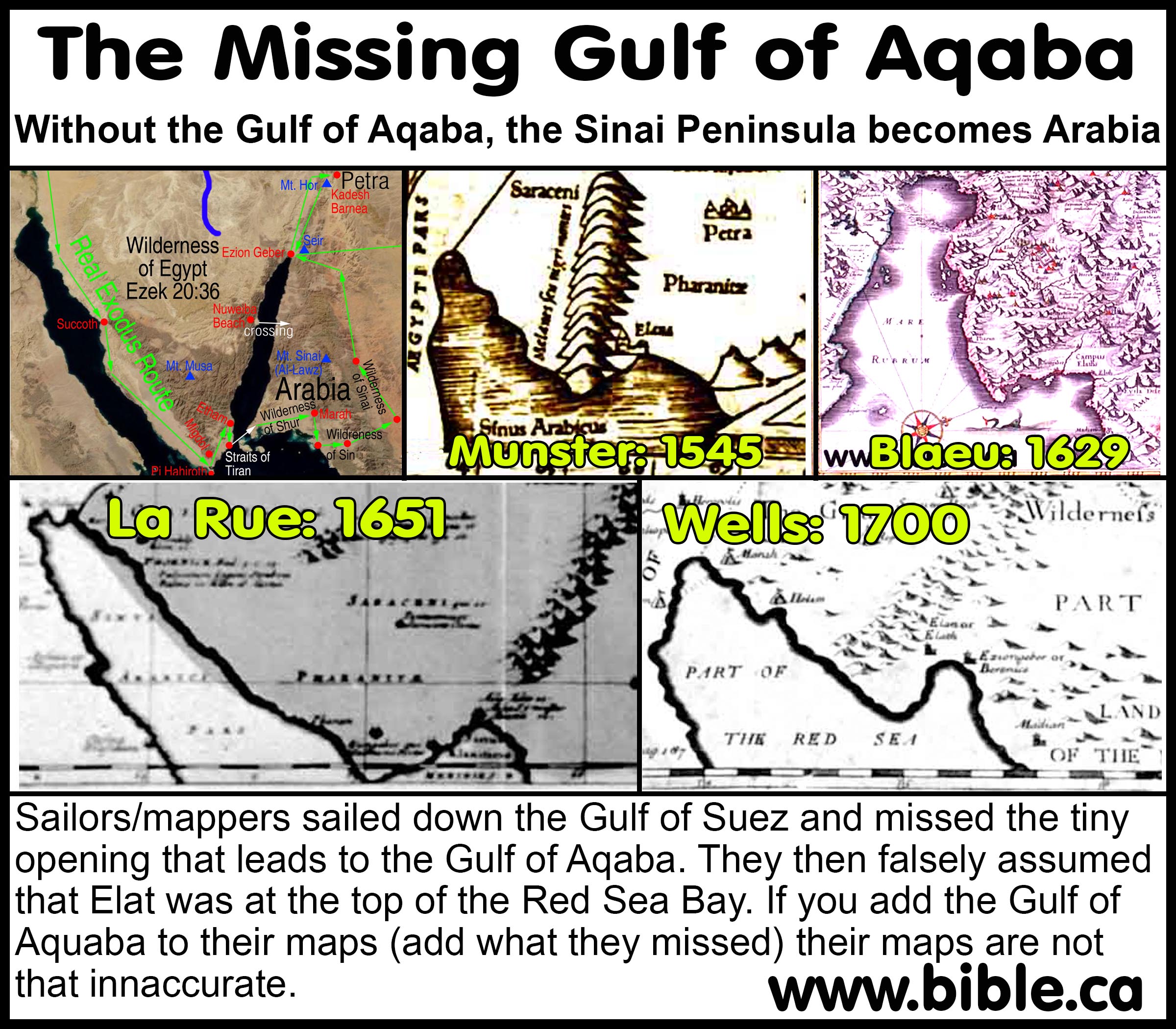
2. Josephus said that the tribe of Simeon bordered with both Arabia and Egypt (Ant. 5:82).
a. This provides another line of evidence that the Sinai Peninsula in either 1406 or AD 70 and the time of Paul, was NOT considered to be Arabia.
b. “So Joshua took both Eleazar and the senate, and with them the heads of the tribes, and distributed the land to the nine tribes, and to the half tribe of Manasseh, appointing the dimensions to be according to the largeness of each tribe. (81) So when he had cast lots, Judah had assigned him by lot the upper part of Judea reaching as far as Jerusalem, and its breadth extended to the Lake of Sodom. Now in the lot of this tribe there were the cities of Askelon and Gaza. (82) The lot of Simeon, which was the second, included that part of Idumea which bordered upon Egypt and Arabia. As to the Benjamites, their lot fell so, that its length reached from the river Jordan to the sea; but in breadth it was bounded by Jerusalem and Bethel; and this lot was the narrowest of all, by reason of the goodness of the land; for it included Jericho and the city of Jerusalem.” (Josephus Antiquities 5.80-82)
3. Apostle Paul taught that Mt. Sinai was located in Arabia in Gal 4:25, where Ishmael lived.
a. In AD 54, when Apostle Paul wrote Gal 4:25, the wilderness of Egypt (Sinai Peninsula) was never called Arabia.
b. In AD 50, the Nabataeans (Nabateans) never referred to the Sinai Peninsula as "Arabia" and it was not until the Roman's annexed the Wilderness of Egypt from the Egyptians in 106 AD that it was first called "Arabia".
c. The Nabateans never occupied any part of the Sinai Peninsula.
d.
At the time of Apostle Paul, the Sinai Peninsula was Egyptian/Ptolemaic
not Arabian.
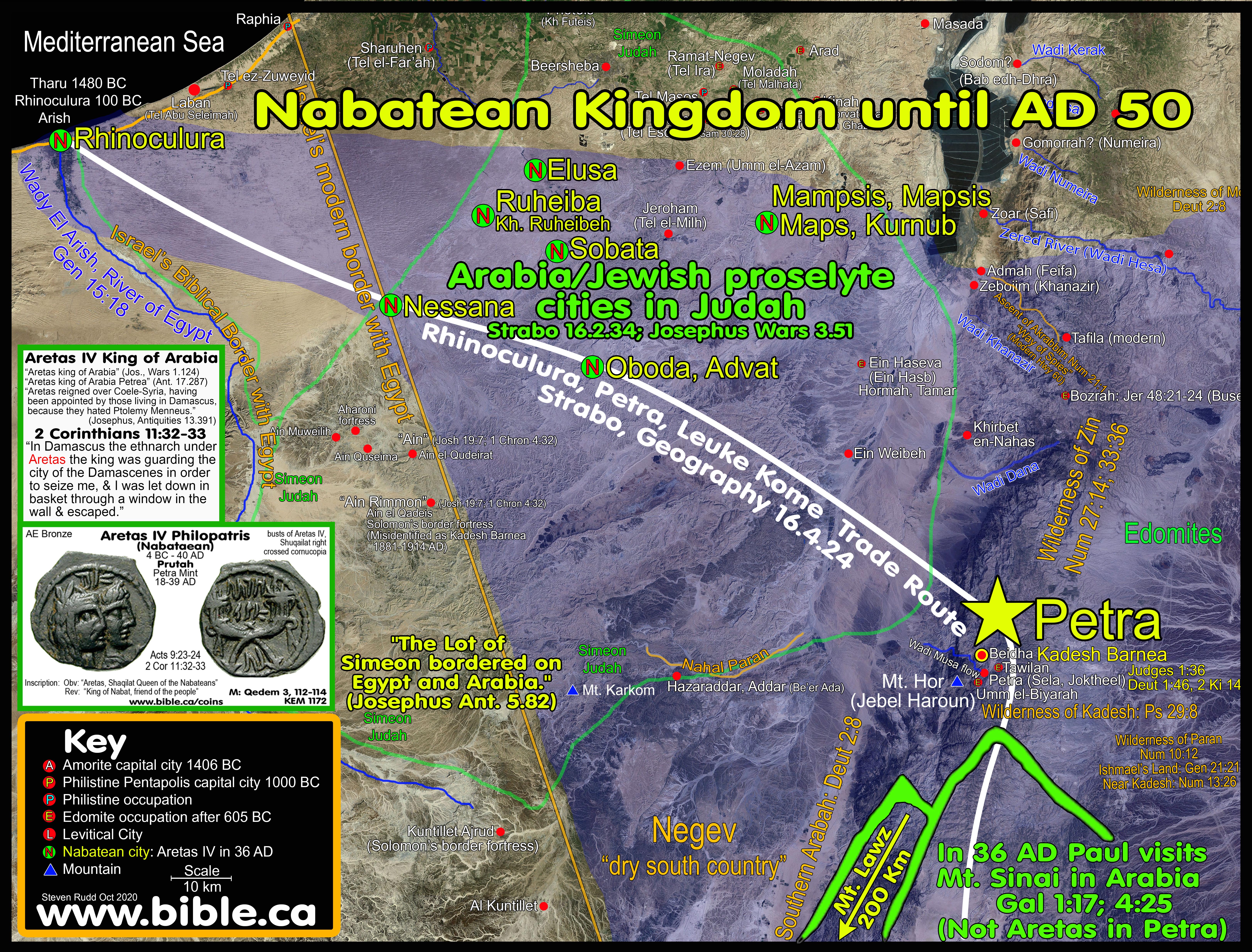
4.
Find Ishmael, find Mt. Sinai: Gal 4:25

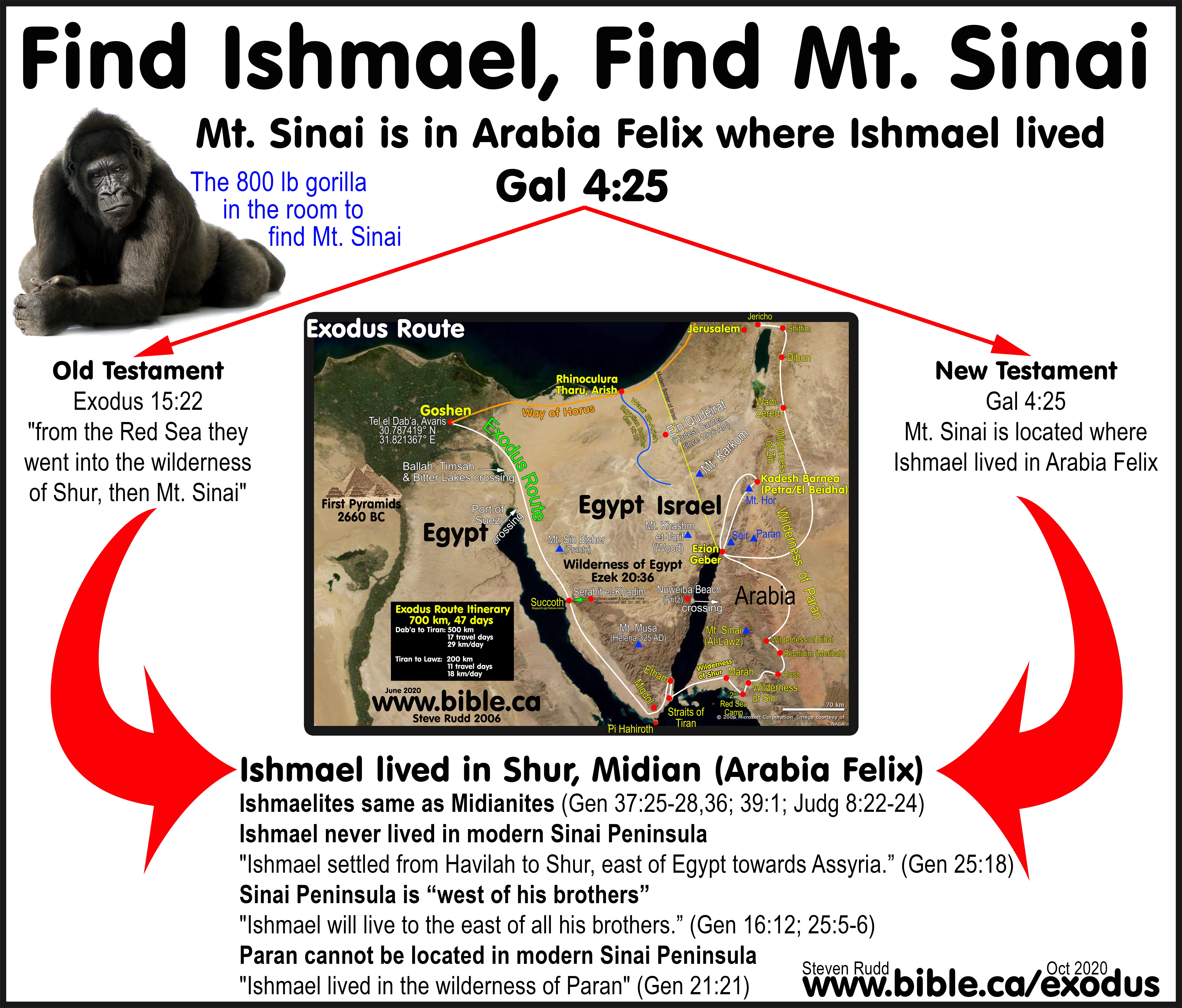
a. Apostle Paul gave us the key in to locate Mt. Sinai: Mt. Sinai is where Ishmael lived!
b. Forget looking for Arabia, find Ishmael and you find Mt. Sinai!
c. Ishmael lived “east of his brothers” at Shur then intermarried to become one tribe with the Midianites at the time of Joseph.
d. Notice when Joseph was sold by his brothers in Genesis 37, the narration switches between describing the byers as Ishmaelites (v27), then Midianites (v28), then Ishmaelites (v28), then Midianites (v36).
e. This proves that Ishmael lived in Midian, which is where Apostle Paul said Mt. Sinai is located.
f. This is how you use the Bible to prove Mt. Sinai is in Saudi Arabia!
5. Mt. Sinai is located near the Amalekites and Midianites:
a. In 1446 BC the Edomites, Midianites, Ishmaelites and Amalekites were Transjordan nations “of the east” and did not live in the Wilderness of Egypt (Sinai Peninsula) or the Judean Negev.
b. At the time of the Exodus in 1446 BC, neither Edom, the Midianites or the Ishmaelites or the Amalekites controlled the Wilderness of Egypt (Sinai Peninsula). It was Egypt's land and they controlled it.
c.
The Amalekites attacked Moses near Mt. Sinai at Rephidim. Notice the
Midianites and the Amalekites worked together in Judges 6:3,33; 7:12 to oppress
Israel shortly after the death of Deborah in 1144 BC.

6. In 1446 BC, Egypt controlled mining in the Wilderness of Egypt (Sinai Peninsula) at the time of the Exodus:
a. Copper mines include those at Timna and Serabit el-Khadim in the Sinai.
b. The traditional exodus route to Mt. Musa, takes Israel right past the copper mines Serabit el-Khadim that was active in 1446 BC. Moses only made one stop between Goshen and Etham at Succoth in order to collect the Hebrew slaves working in the mines. Succoth was located directly beside the mines on the Gulf of Aqaba.
c.
Several ancient Hebrew inscriptions found in these mines have been
translated include the “Moses” inscription.
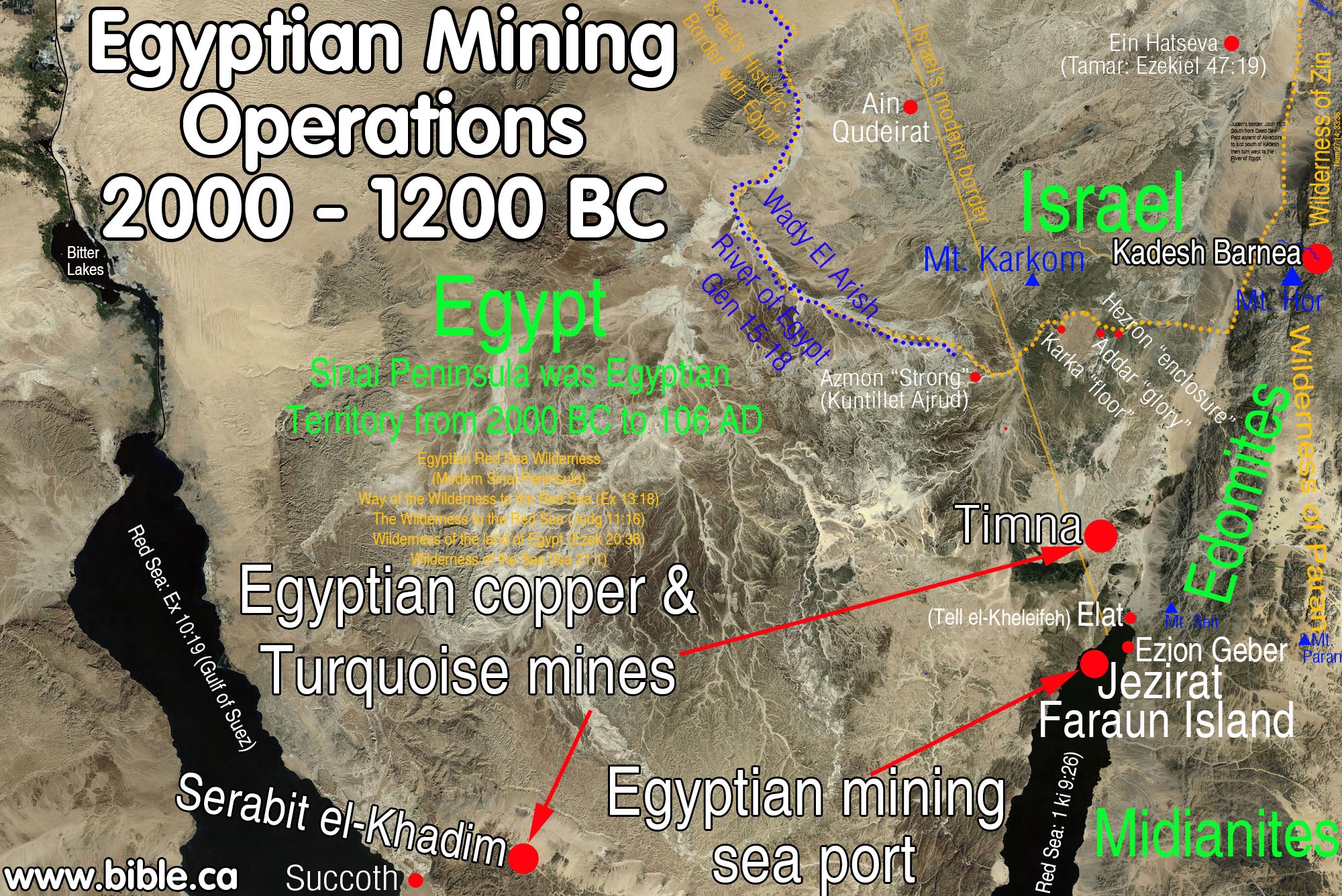
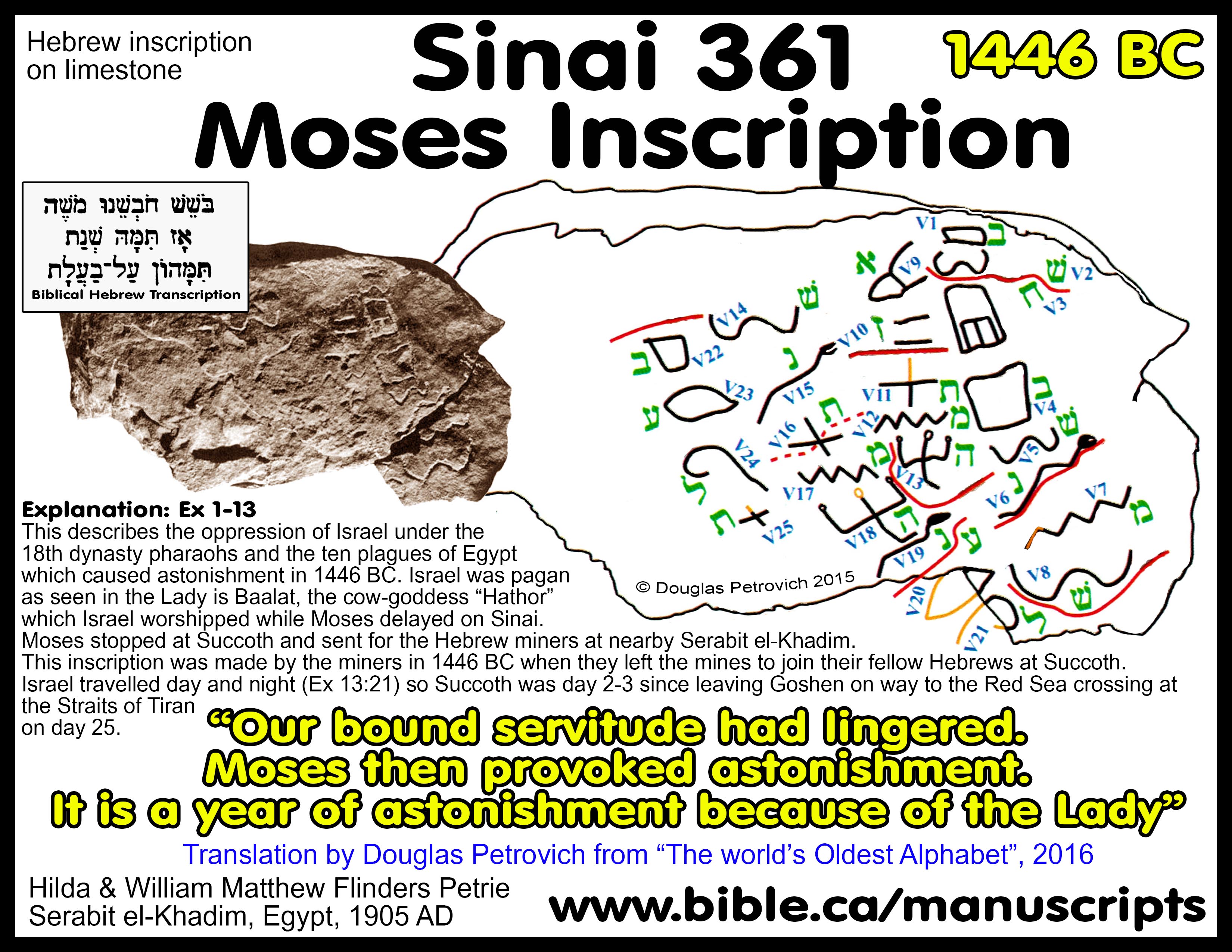
7. Mt. Sinai is due south of Edom: Dawning from the North
a. This spectacular hidden gem of information has been missed by most Gospel preachers.
b.
On Pentecost 1446 BC God “ascends” Mt. Sinai and the mountain explodes
into fire, lightening and smoke. While Exodus 24:17 says God “descended” on Mt.
Sinai, Psalm 68:17–18 speaks of how God/David “ascended” His/his throne on the
Mt. Sinai/Zion.
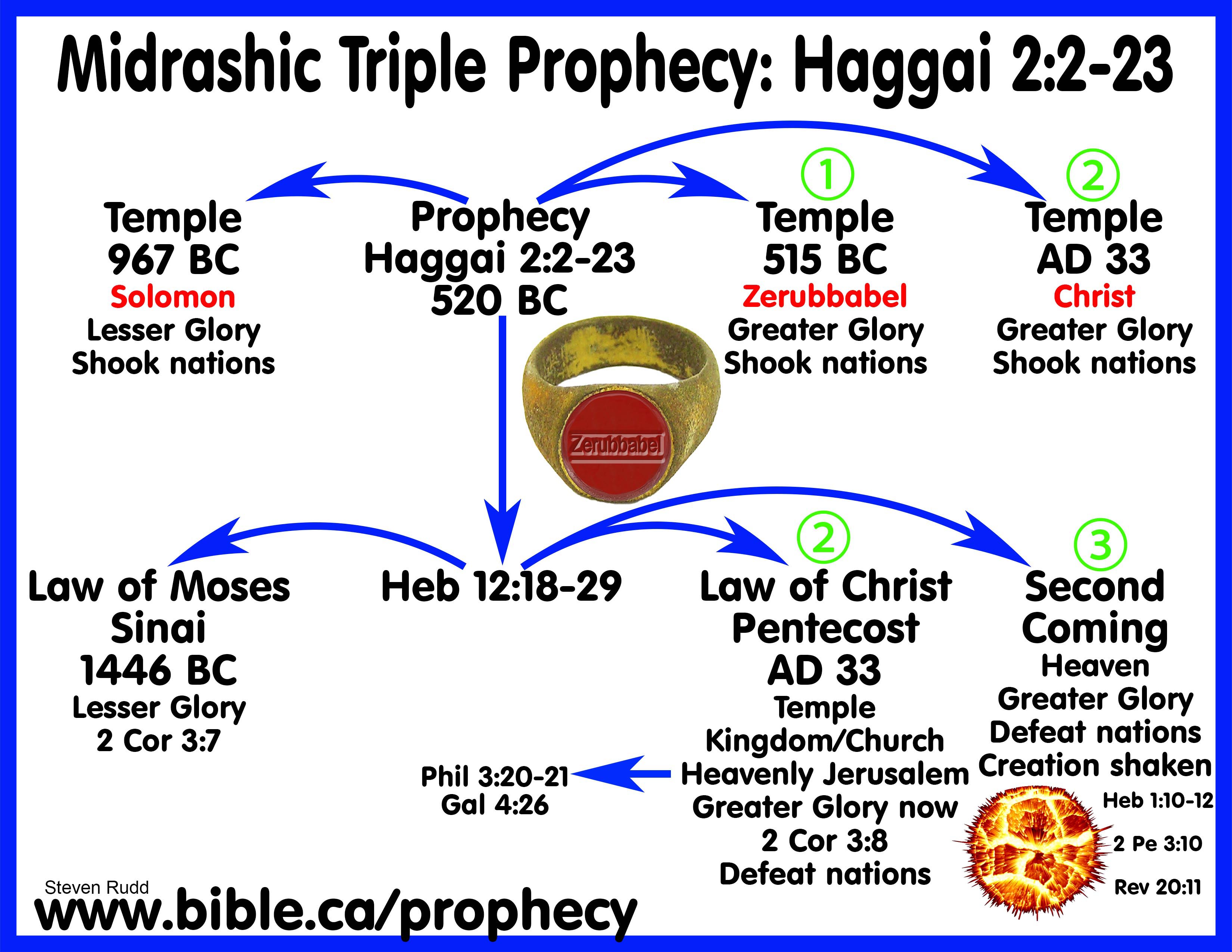
i. When the people were waiting at the foot of Mt. Sinai for God arrive, they look due north and a small cloud appear in the distance in the direction of Mt. Paran and the land of Edom. As God arrives, the cloud gets larger and larger until He hovers over Mt. Sinai.
ii. This infers that Mt. Sinai must be due south of Edom.
iii. Scripture pictures the "throne of God" as being in the north.
iv. Amazingly, God "dawned from the north from where His throne is located upon Mt. Sinai on Pentecost 1446 BC.
v. Jerusalem is 340 km due north of Mt. Lawz.
vi. From the vantage point of the Hebrews at Sinai they are unaware that God’s throne is not in Edom, but Jerusalem.
c. God’s throne is located in the North:
i. “But you said in your heart, ‘I will ascend to heaven; I will raise my throne above the stars of God, And I will sit on the mount of assembly In the recesses of the north. ‘I will ascend above the heights of the clouds; I will make myself like the Most High.’" (Isaiah 14:13–14)
d. Job was an Edomite who prophesied at the time of Abraham (2000 BC), that God would dawn on Mt. Sinai in 1446 BC
i. “Out of the north comes golden splendor; Around God is awesome majesty." (Job 37:22)
e. Bible verses:
i. "He said, “The Lord came on Sinai, and dawned on them from Seir; He shone forth from Mount Paran, And He came from the midst of ten thousand holy ones; At His right hand there was flashing lightning for them." (Deuteronomy 33:2)
ii. "Who is this who comes from Edom, with garments of glowing colors from Bozrah, This One who is majestic in His apparel, Marching in the greatness of His strength? “It is I who speak in righteousness, mighty to save.” Why is Your apparel red, And Your garments like the one who treads in the wine press?" (Isaiah 63:1–2)
iii. "“Lord, when You went out from Seir, When You marched from the field of Edom, The earth quaked, the heavens also dripped, Even the clouds dripped water." (Judges 5:4)
iv. "God comes from Teman, And the Holy One from Mount Paran. Selah. His splendor covers the heavens, And the earth is full of His praise." (Habakkuk 3:3)
f.
There is a direct line north, from Mt. Lawz, through Mt. Paran (Edom) to
Jerusalem. Jerusalem is due north of Mt. Lawz. More details.
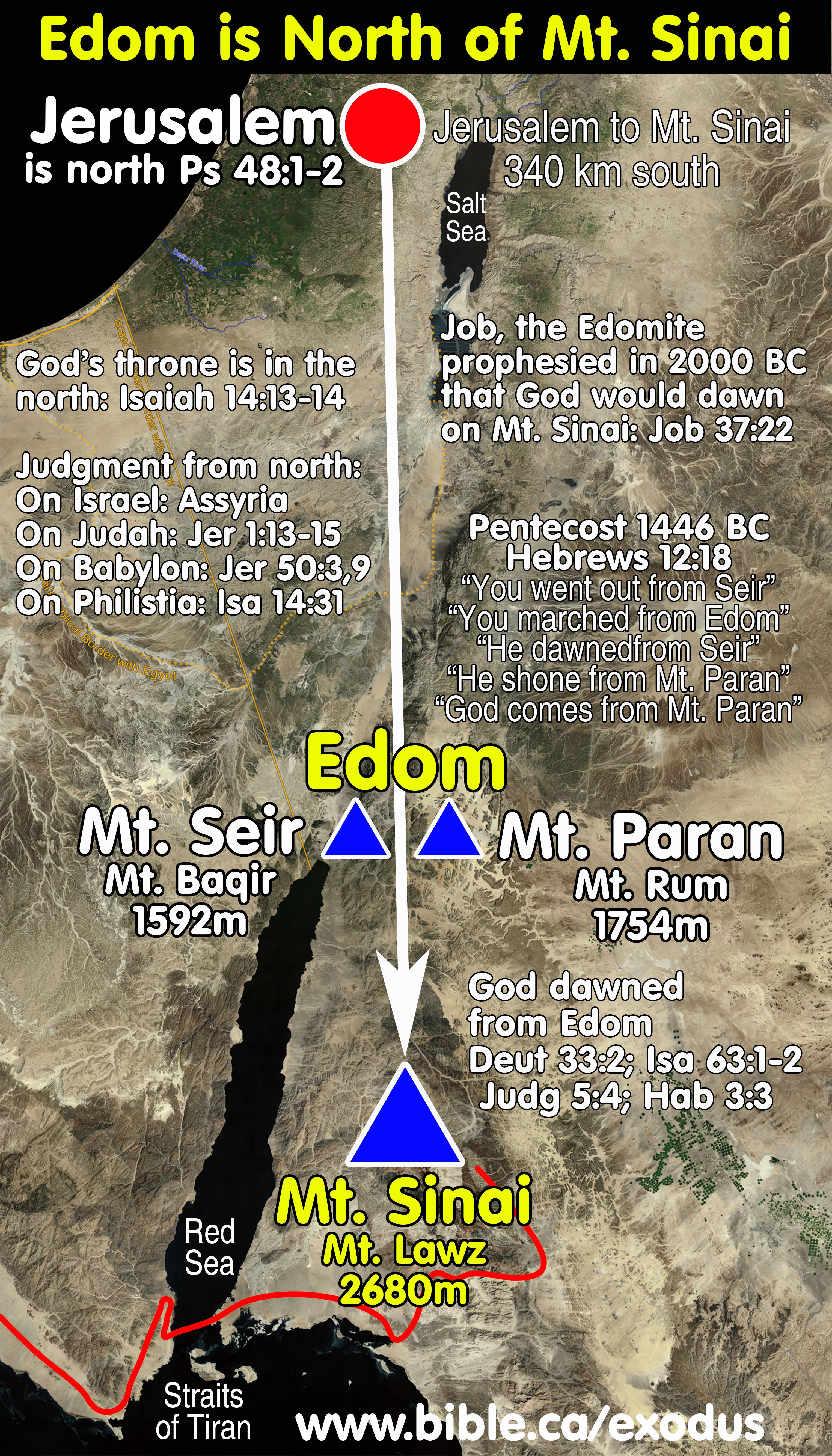
8. The burning bush was near Midian not Egypt:
a. Bible says Mt. Sinai was in Arabia near Midian where Jethro lived:
i. Stephen said in Acts 7:30 that Moses saw the burning bush in the wilderness of Sinai, which was near the base of the mountain.
ii. "When Pharaoh heard of this matter, he tried to kill Moses. But Moses fled from the presence of Pharaoh and settled in the land of Midian, and he sat down by a well. Now the priest of Midian had seven daughters; and they came to draw water and filled the troughs to water their father's flock." Exodus 2:15-16
iii. Burning bush: "Now Moses was pasturing the flock of Jethro his father-in-law, the priest of Midian; and he led the flock to the back side of the wilderness and came to Horeb, the mountain of God. " Exodus 3:1
iv. After leaving Sinai and back home in Midian: "Now the Lord said to Moses in Midian, "Go back to Egypt, for all the men who were seeking your life are dead." Exodus 4:19
v. "Now the Lord said to Aaron, "Go to meet Moses in the wilderness." So he went and met him at the mountain of God and kissed him. " Exodus 4:27
vi. At Mt Sinai: "Now Jethro, the priest of Midian, Moses' father-in-law, heard of all that God had done for Moses and for Israel His people, how the Lord had brought Israel out of Egypt. " Exodus 18:1 "Then Jethro, Moses' father-in-law, came with his sons and his wife to Moses in the wilderness where he was camped, at the mount of God. " Exodus 18:5 "Then Moses bade his father-in-law farewell, and he went his way into his own land." Exodus 18:27
b. There is no reason why the burning bush could not be near Midian in Arabia. The Bible does not say that Moses made a long journey away from Midian.
c. Midian (Al-Bad) is very distant from Mt. Musa. It is not realistic to think Moses pastured his flocks so far from his home. The Bible does not say that Moses went into the Sinai Peninsula. When Moses saw the burning bush, it says that he wandered in the rear wilderness. The fact that no other reference is given means that the only logical conclusion is that it was the rear wilderness of Midian.
d. Josephus indicated that most men avoided this area even though it was lush grazing for crops which does not fit the Sinai Peninsula at any point in history. (Josephus Antiquities 2.265, AD 70). Agatharchides describes the Wilderness of Shur near Midian as lush with vegetation for grazing (Agatharchides quoted by Diodorus 49 BC, 3.43.6-7)
e. The Bible says that Moses went to the "behind side [Hebrew: "achar"] of the wilderness" Literally: achar "the hind or following part" (NASB Hebrew dictionary). The east side of the Lawz would most certainly be described as the "behind wilderness". It is kind of like saying that Moses went to "the back forty".
C. Ancient literary sources that Mt. Sinai was in Saudi Arabia near Midian:
1. 225 BC Demetrius the Chronographer Demetrius believed that Moses dwelt in Madyan, (Midian) which is universally accepted as Al-Bad.
a. Even those who oppose a location of Mt. Sinai in Saudi Arabia agree that Midian was at Al-Bad.
b. Demetrius lived and worked in Alexandria, which meant he had access to the largest library in the world. Demetrius located Moses’ 40 years after fleeing pharaoh in the city of Madyan (al Bad) in northwestern Arabia. Eusebius quoted Demetrius: “And they dwelt in the city Madiam, which was called from one of the sons of Abraham. For it says that Abraham sent his sons towards the East to find a dwelling-place: for this reason also Aaron and Miriam said at Hazeroth that Moses had married an Aethiopian woman.” (Eusebius Preaparatio Evangelica 9:29.1-3, quoting Demetrius the Chronographer)
2. 169 BC: Agatharchides describes the Wilderness of Shur as being lush with vegetation and water. This cannot describe anywhere in the Sinai Peninsula at any time in history.
a. “After these places there is a well-watered plain which, because of the streams that flow through it everywhere, grows dog's tooth grass, Lucerne and also lotus the height of a man. Because of the abundance and excellence of the pasturage it not only supports flocks and herds of all sorts in unspeakably great numbers but also wild camels and, in addition, deer and gazelles. In response to the abundance of animals which breed there, crowds of lions, wolves and leopards gather from the desert. Against these the herdsmen are compelled to fight day and night in defense of their flocks. Thus, the advantage of the country is the cause of misfortune to its inhabitants because Nature generally gives men together with good things those that are harmful. (Agatharchides of Cnidus, On the Erythraean Sea 169 BC, translated by Stanley M. Burstein, 1989, book 5, fragment 91b. Diodorus 49 BC, 3.43.6-7)
3. AD 70: Josephus gives us three clues to the location of Mt. Sinai. He says Mt. Sinai is the highest mountain in the area near the city of Midian (Al Bad) which was near the Red Sea (Aqaba) and that the Sinai Peninsula was not Arabia.
a. Jethro was in Midian near Red Sea: “Moses took his flight through the deserts, and where his enemies could not suspect he would travel; and, though he was destitute of food, he went on, and despised that difficulty courageously; (257) and when he came to the city Midian, which lay upon the Red Sea, and was so denominated from one of Abraham’s sons by Keturah, he sat upon a certain well, and rested himself there after his laborious journey, and the affliction he had been in.” (Jospehus Antiquities 2.256-257)
b. At Burning bush Sinai was tallest mountain in the area: “Now Moses, when he had obtained the favor of Jethro, for that was one of the names of Raguel, staid there, and fed his flock; but some time afterward, taking his station at the mountain called Sinai, he drove his flocks thither to feed them. (265) Now this is the highest of all the mountains thereabout, and the best for pasturage, the herbage being there good; and it had not been before fed upon, because of the opinion men had that God dwelt there, the shepherds not daring to ascend up to it; and here it was that a wonderful prodigy happened to Moses; (266) for a fire fed upon a thorn bush, yet did the green leaves and the flowers continue untouched, and the fire did not at all consume the fruit branches, although the flame was great and fierce.” (Josephus Antiquities 2.264-266)
c. Sinai Peninsula was not Arabia: Josephus said that the tribe of Simeon bordered with both Arabia and Egypt (Ant. 5:82). This provides another line of evidence that the Sinai Peninsula in either 1406 or AD 70 and the time of Paul, was NOT considered to be Arabia.
4. AD 325: Helena vs. Eusebius and the Onomasticon: Eusebius has a dictionary of places called the Onomasticon which he wrote at the same time Helena chose Mt. Musa in a dream.
a. Since 325 AD Mt. Sinai is located at Mt. Musa in the wilderness of Egypt. It is important to know that wilderness of Egypt was never called the "Sinai" or the Sinai Peninsula" before 325 AD. Queen Helena, Constantine's mother, chose Mt. Musa in a dream. This proves that it required a "special revelation from God" to locate Mt. Sinai and that no one of her day agreed with her.
b. It is interesting that Eusebius has no entry in his dictionary of places for Mt. Sinai although he does mention under the "Horeb" entry that Mt. Sinai is beside Horeb. We believe this is because he located Mt. Sinai in Arabia and this conflicted with Helena's choice.
c. A careful reading of Eusebius proves he believed that Mt. Sinai and Mt. Horeb, Wilderness of Shur, Midian, the desert of the Saracens, wilderness of Paran, Arabian Desert were all were all Transjordan.
D. Historic search for Mt. Sinai: 1878 – 1938 AD
1. Discussion:
a. The consensus view among those who place Mt. Sinai in Arabia was northeast of the Gulf of Aqaba at Mt Baghir. One suggested Petra as Mt. Sinai. Only one, Alois Musil proposed a Mt. Sinai southeast of Midian (Al-Bad) in 1926 AD.
b. Without exception, all crossed the Red Sea at on the north shore of the Gulf of Aqaba.
c. While the association of Midian with Saudi Arabia drove them to reject a location for Mt. Sinai anywhere in the Sinai Peninsula and look Transjordan, their research was superficially based on local toponyms.
d. None of these authorities made lasting contributions to the search for Mt. Sinai, except in their identification of Midian at Al-Bad.
2. 1878 AD: Mt. Sinai at Mt Baghir: Sinai in Arabia and of Midian, Beke, Charles T. (London, 1878): Charles Beke located Mt. Sinai at Jabal Baghir (Jebel el Nur: Mountain of Light) in modern Jordan located 15 km NE of the modern city of Aqaba at GPS: 29.6000, 35.1333. His Red Sea crossing was on the north tip of the Gulf of Suez. His superficial approach to locating Mt. Sinai is not to be taken seriously because it was dependent almost entirely on local Muslim toponyms and myths. His choice of Mt. Sinai in Arabia is more a random fluke. Jabal Baghir is located in the heart of Edomite territory at the time of the Exodus.
a. “Jebel Baghir, or Jebel el Nur (Mountain of Light), which I have lately discovered, and which I regard as the true Mount Sinai” (Sinai in Arabia and of Midian, Charles T. Beke, p13, 1878 AD)
b. “My husband left England on his memorable journey in search of the true Mount Sinai on December 8, 1873 ; and, after an absence of three months and eleven days, lie returned home on March 19, 1874, having in the intervening period accomplished his task, and discovered " Mount Sinai in Arabia " (Jebel-el-Nur, the Mountain of Light), precisely in the position where he contended it should be looked for. He was also so fortunate as to discover Moses' " Place of Prayer "”. (ibid. pvii)
c. “The Mountain of Light—my Mount Sinai—as I was told [by local Muslims], derives its appellation from the light, which appeared at night on its summit and served as a guide to Moses and the Israelites in their flight that is to say, the pillar of fire by night and the of cloud by day, of Exodus 13:2” (ibid. p575)
3. 1879 AD: Mt. Sinai at Mt Baghir: The Hebrew Migration from Egypt, John Baker S. Greene, 1879 AD: Green’s Red Sea crossing is at the north tip of the Gulf of Suez and places Elim at Elat on the north shore of the Gulf of Aqaba. He locates He believes the Wilderness of Zin near Kadesh Barea is identical to the Wilderness of Sin near Mt. Sinai. Mt. Sinai north east of the Gulf of Aqaba but never specifies a location. It appears he is pointing to a location of Mt. Sinai at Jabal Baghir, following Charles Beke, who published his view one year earlier.
a. “As, however, the spies “searched the land from the wilderness of Zin unto Rehob," the wilderness of Sin, which was close by, if not identical with that of Zin, and which, we are authoritatively informed, was between Elim and Sinai, could not have been in the Sinaitic peninsula. The same train of reasoning equally leads to the conclusion that it must have been to the north of the head of the Ælanitic Gulf (Aqaba). (The Hebrew Migration from Egypt, John Baker S. Greene, p 191, 1879 AD)
b. “But further, the indications which have hitherto led us to trace the Israelites across the Tih [Sinai Peninsula] to Elim [Elat], and from thence along the Araba towards Mount Sinai, receive overwhelming corroboration by the circumstance that we discover Jethro, who at this point meets the Israelites, precisely in the very locality where following the Scriptural records and the account of Josephus we should expect to find him.” (p199)
c. “If we have followed the correct track of the Israelites thus far, and if we are right in placing Sinai in Seir, nothing can be more consistent with all the evidence hitherto examined than that Jethro, the Midianite or Kenite Sheikh, should come from Petra or its neighbourhood, and meet Moses and the Israelites in the Araba; or, more probably still, in one of the valleys leading from the Araba into the Idunuean mountains.” (p326)
d. “We have seen as the result, not of a balance of evidence, but of an accumulation of all the testimony which possesses any real value, that Mount Sinai stood in what was afterwards known as Idumæ, and we have also seen that it was to Idumæ that the emigrants from Egypt immediately directed their steps. Our road has not been free from difficulties, but by patience, we believe, that they have been successfully surmounted. Absolute exactitude cannot be hoped for even by the most sanguine in such an investigation as that in which we have been engaged.” (p339)
4. 1926 AD: Mt. Sinai at Mt Hrob southeast of Al-Bad: The Northern Hegaz, Alois Musil, 1926, Musil locates Mt. Sinai on the mountain range 17 km north of Ain Ouna (Steven Rudd’s location for Elim) and 31 km SE of Al-Bad (Midian).
a. Musil places Elim at the modern city of Aqaba on the north tip of the Gulf of Aqaba.
b. “We must therefore identify this miraculous obtaining of water at Horeb with that at Kades and regard Refidim only as a halting place on the march from Elim to Mount Horeb. About one hundred kilometers to the south of al-`Akaba (Elim) there is a basin in the mountain range of ar-Rafid, which I take to be Refidim. About twenty kilometers southeast of this is the oasis of al-Bad', or the ancient Madian, to which the Israelites hastened. This tallies with Exodus, 19: 2, according to which they went from Refidim to the wilderness of Sinai, where they encamped opposite the mountain. There, according to another source (Ex., 18: 5), Jethro, the priest of Madian, came to Moses in the wilderness, where he was encamped by the mountain of God and, having conferred with him, returned to his own country (Ex., 18: 27). The main camp of the Israelites was thus not pitched by the settlement in which Jethro dwelt. The latter must be sought, according to the configuration of the ground, to the south of al-Bed', perhaps in the oasis of 'Ajnana (Ain Ouna), at a distance of fifty kilometers, and the main camp of the Israelites (at Mt. Sinai) by the Se`ib of al-Hrob (Mt. Sinai), twenty kilometers to the north of Ajnuna.” (The Northern Hegaz, Alois Musil, p 269, 1926 AD)
5. 1928 AD: Mt. Sinai at Petra: The Site of the Biblical Mount Sinai, Ditlef Nielsen, (Copenhagen, 1928), Nielsen located Mt. Sinai at Petra.
6. 1938 AD: Mt. Sinai at Mt Baghir: The Route of the Exodus of the Israelites from Egypt, Lucas, Alfred (London, 1938). Lucas followed Charles T. Beke in locating Mt. Sinai at Jebel Baghir.
E. Events before and at Mt. Sinai:
1. Moses called at the burning bush at Mt. Horeb:
a. Moses left Egypt at the age of 80 and lived in Arabia, in the land of Midian (Ex 2:15).
b. While tending a flock of sheep that were owned by Jethro (Moses father in law), Moses took the sheep to the "behind side of the wilderness" and encountered God at the Burning bush. This would be just outside of the normal area that Jethro controlled, but beside it in an adjacent area (Ex 3:1).
c. While Moses saw God at the burning bush, God also told Aaron, who was in Egypt, to travel all the way to Midian and meet Moses at Mt. Sinai.
d. Moses went back to Midian where God told Moses that the Pharaoh who tried to kill him was dead and to begin the journey to Egypt (Ex 4:18).
2. Moses returns to Egypt:
a. Moses takes his wife and children with him. Although the Bible does not say, it must have been at this same time that God told Moses to get his son circumcised. While travelling, God was going to kill Moses because he was listening to the protests of his wife over the commandment of God. Big mistake, when God tells you one thing and your wife another... obey God! Hot lip from God is worse than cold shoulder from your wife (Ex 4:24).
b. Although the Bible doesn't say, Moses must have been told to go to Mt. Sinai where he met up with his brother Aaron. They must have taken the route over top of the Gulf of Aqaba.
c. Moses, his wife, children and Aaron depart Mt. Sinai and travel back to Egypt where Aaron reports to the Hebrews that God cares for them. This causes the people to worship God. Ex 4:31.
d. One stop before the wilderness of Sinai Amalekites attack Israel at Rephidim: Exodus 17:8
e. Detailed calendar for events between Goshen and Sinai: click here
3. Major events at Mt. Sinai (and the wilderness of Sinai where the camp was located)
a. The Hebrews will spend 11 months, 5 days at Sinai before moving north to Kadesh Barnea.
b. Moses brought water out of the rock the first day he arrives. The people complained at Rephidim, but Moses struck the rock at the foot of Mt. Horeb. We know this because a few days later, God told the people to wash all their clothes in preparation for Pentecost Sunday three days later. Friday was called “preparation day” in the first century and this tradition probably dates to this very command to wash their clothing on Friday at Sinai in 1446 BC. Detailed outline.
c. Moses received the Ten Commandments.
d. Moses may have built a barrier wall at the foot of the mountain as a line not to be crossed by the people. We do not know if barrier is a stone wall, a line of stones on the ground, human guards or a physical reference point, like "Do not cross the line between this tree and that cliff": "You shall set bounds for the people all around, saying, 'Beware that you do not go up on the mountain or touch the border of it; whoever touches the mountain shall surely be put to death." Exodus 19:12
e. The first of two census' was done at Mt. Sinai: Numbers 1:19. The second was just before crossing the Jordan 40 years later: Numbers 26:2. There were 2.5 million Jews in the Exodus, not 5,000 as some wrongly suggest. The Hebrew word for 1000 is "elep" and cannot mean "clans" in reference to the exodus population numbers.
f. Nadab and Abihu offered strange fire and were killed: Numbers 3:4
F. Calendar of events at Sinai from arrival to departure: Days 47 – 335
Detailed outline on the Eight Ascensions of Moses up Mt. Sinai: click here
|
Sun |
Mon |
Tue |
Wed |
Thurs |
Fri |
Sat |
|
- |
- |
- |
Nisan 14: Passover lambs killed before sunset and eaten on Nisan 15 Wed evening. |
Day 1 Nisan 15: Departed in Daylight Num 33:3 |
2 |
3 Start counting 7 Sabbaths for Pentecost |
|
4 |
5 |
6 |
7 |
8 |
9 Succoth Overnight camp |
10 day 8 of Pentecost Nisan 24 |
|
11 |
12 |
13 |
14 |
15 Migdol |
16 Etham: Nisan 30 |
17 Iyar 1 |
|
18 camped at Red Sea |
19 Iyar 3 at Red Sea |
20 camped at Red Sea |
21 camped at Red Sea |
22 camped at Red Sea |
23 camped at Red Sea |
24 camped at Red Sea |
|
Iyar 9, saved and Shadow of First Fruits Lev 23:10-12 |
Day 1 after crossing |
28 Marah Day 3 after crossing |
29 Elim |
30 Iyar 14 Day 5 from Red Sea Crossing |
31 Iyar 15 Wilderness of Sin. Ex 16:1. Day 6 from Red Sea Crossing |
|
|
32 camped at Sin, 1st Manna |
33 camped at Sin |
34 camped at Sin |
35 camped at Sin |
36 camped at Sin |
37 camped at Sin. Day 12 from Crossing |
38 camped at Sin. 1st Sabbath |
|
39 Iyar23 Day 14 Leave wilderness of Sin for Dophkah |
40 Dophkah, Alush (small stage groups) Day 15 from Red Sea Crossing |
41 Alush, Rephidim (small stage groups) Day 16 from Red Sea Crossing |
Israel grumbles for water: Ex 17:6 Amalek attacks |
Moses hands held up to win war. Moses’ altar: Ex 17:15. Jethro arrives, eats meal Ex 18:12 |
Moses Judges the people all day: Ex 18:13 |
45 Iyar 29 Rephidim 2nd Sabbath. Jethro’s Advice: Ex 18:17 |
|
46 Iyar 30 Moses implements Jethro’s advice and leaves: Ex 18:27. Israel leaves for Wild. of Sinai |
47 Sivan 1 Wilderness of Sinai: Ex 19:1 Split rock for water at Horeb: Ex 17:6. Day 22 from crossing |
Day 48 Sivan 2 1st ascension oath for people |
Day 49 |
Day 50 Sivan 4 2nd ascension be ready on the third day: Ex 19:7-14 |
51 Sivan 5 “preparation day” to wash clothes |
52 Sivan 6 Day 49 of Pentecost, 7th Sabbath. Seder Olam 5.31 |
|
53 Pentecost Sivan 7 Moses hears 10 Comm. and laws |
54 Sivan 8 |
55 4th ascension Moses ascends with Aaron. laws repeated Ex 20-23 |
56 |
57 5th ascension Moses, Aaron, Nadab, Abihu, 70 elders. |
58 |
59 |
|
Sun |
Mon |
Tue |
Wed |
Thurs |
Fri |
Sat |
|
Mon |
Tue |
Wed |
Thurs |
Fri |
Sat |
|
|
46 Iyar 30 Moses implements Jethro’s advice and leaves: Ex 18:27. Israel leaves for Wild. of Sinai |
47 Sivan 1 Wilderness of Sinai: Ex 19:1 Split rock for water at Horeb: Ex 17:6. Day 22 from crossing |
Day 48 Sivan 2 1st ascension oath for people |
Day 49 |
Day 50 Sivan 4 2nd ascension be ready on the third day: Ex 19:7-14 |
51 Sivan 5 “preparation day” to wash clothes |
52 Sivan 6 Day 49 of Pentecost, 7th Sabbath. Seder Olam 5.31 |
|
53 Pentecost Sivan 7 Moses hears 10 Comm. and laws |
54 Sivan 8 |
55 4th ascension Moses ascends with Aaron. laws repeated Ex 20-23 |
56 |
57 5th ascension Moses, Aaron, Nadab, Abihu, 70 elders. |
58 |
59 |
|
60-99 6th Ascension |
40 days Moses was on the Mt. Sinai |
99 Golden calf, breaks tablets |
100 |
101 Sabbath |
||
|
102
- 141 days from Goshen (40 days inclusive) |
||||||
|
Other events at Mt. Sinai:
|
||||||
|
1445 BC: Day 335 from leaving Goshen, Israel departs from Sinai for promised land after spending 11 months, 5 days at Sinai: Numbers 10:11-12 |
||||||
G. The Eight Ascensions of Moses up Mt. Sinai:
- 1st Ascension: Tuesday Sivan 2, Day 48 from Goshen: Ex 19:3-8
- Moses Ascends Mt. Sinai and returns with oath for people to obey the Law soon to be revealed.
- Moses returns to the camp and asks the people if they will keep the law soon to be revealed. The people reply yes.
- 2nd Ascension: Friday Sivan 4, Day 50: Ex 19:7-14
- Moses ascends Mt. Sinai to give God the people's "yes" answer. God says to be ready on the third day (Sunday Sivan 7, day 53 from Goshen) when he will descend on the Mountain in fire: Ex 19:7-14. The people are told to walk to the base of the mountain from their camp and be ready for God's coming. God tells Moses to set up boundaries around the mountain so the people cannot break through, climb the mountain and die.
- The third day= Friday to Sunday: There is a direct triple correspondence between the Sinai, the Triumphal entry and the crucifixion since all were periods of three days between Friday and Sunday: Luke 13:32.
- As the Israelites waited as instructed the third day, for God to descend on Mt. Sinai, they suddenly looked due north 100 km and saw God in the wilderness of Paran. God "dawns from Seir" like a sunrise in its glory, until He is hovering directly over Mt. Sinai. The Israelites watched in wonder and were amazed at the beauty and splendor of God as He came closer and closer to them where they stood. One of the most interesting facts about the Wilderness of Paran, is its connection with God's appearing at Mt. Sinai. When Israel was encamped at the foot of Mt. Sinai (Mt. Al-Lawz), God thundered, in a volcanic level display that terrified the Israelites. But three verses explicitly tell us that God dawned from the north like a sunrise, or like Elijah's small cloud the size of a man's fist in the distance that became a storm (1 Kings 18:44). God dawned from Mt. Seir until he came to Mt. Sinai and made the mountain turn to fire before Israel. They were terrified. The four key verses that describe "dawning from the north" are: Deut 33:2; Isa 63:1-2; Judg 5:4; Hab 3:3-7. 40 years later, when Israel was at Mt. Seir, God gave the "go ahead" to finally start their way to the promised land by the command, "Now turn North". In fact Mount Seir is absolute due south of Jerusalem and absolute due north of Mt. Sinai in modern Saudi Arabia. There are several passages that repeat this pattern of God coming "from the North". Most notably is Ezekiel's vision where God came from a distant storm in the North finally to overshadow him. (Ezekiel 1:4) Job describes God as coming from the North in golden splendor. (Job 37:22-23) Lucifer, the king of Babylon describes God's throne as being in the far north. (Isaiah 14:13-14) Psalm 48:1-2 describes Jerusalem as being located in the "far north". Further detailed study.
- 3rd Ascension: Pentecost Sunday, Sivan 7, Day 53: Ex 20:18-25; 20:1-26
a. God descends on Mt. Sinai in fire and He calls Moses to climb the mountain. Ex 19:20
b. Moses hears the Ten Commandments and other laws including building altars.
c. God tells Moses to go back down and warn the people again to stay away from the mountain so they will not die, then come up again (4th) with Aaron. Ex 19:21
- 4th Ascension: Ex 19:24, Sivan 9, Day 55
a. Moses ascends with Aaron only where Ten Commandments and other laws are repeated for Aaron who hears the Ten Commandments and various other laws found in Exodus chapters 20-23
b. Moses and Aaron. God tells Moses to descend and return with Aaron, Nadab and Abihu, and 70 elders of Israel. Moses goes back down and tells the people what God has said. Deut 24:1-3
c. Moses descends and writes down the words in the Book of the Law, which will eventually be placed on the side of the ark. Ex 24:1-4
d. Moses builds an altar with 12 pillars at the foot of the mountain for the twelve tribes. He then sprinkles the altar with blood. Ex 24:4-6
e. Moses read the book of the law to the people and after they agreed, he sprinkled the people with blood of the covenant. Ex 24:7-8
- 5th Ascension: Ex 24:1; 9-11 Sivan 11, day 57
- Moses now returns to the mountain with Aaron, Nadab and Abihu, and 70 elders of Israel. After seeing God and eating the group descend to the foot of the mountain. Ex 24:9-11
- 6th Ascension: Sunday Sivan 14, day 60-99: Ex 24:12-18
- Moses begins 40 days on the Mountain and receives two tables of stone:
- Day 60-99 inclusive counting equals 40 days ending on day 99 after leaving Egypt
- God calls Moses up with Joshua to the mountain to receive the two tablets of stone with the ten commandments written by the finger of God. Ex 24:12
- Moses spends 40 days on the mountain (6th) where God reveals the plan for the tabernacle. Exodus chapters 25-31
- After 40 days, Aaron makes the golden calf as Moses was on the mountain for 40 days. In one of the most fascinating interaction between a man and God in the Bible, God tells Moses He will kill all the Hebrews who sinned and make Moses into a great nation. Moses pleads for the people. Then God changes his mind and says he won't kill them. Moses physically throws 10 commandments at the people who had made the golden calf, rebukes Aaron. Moses grinds up the golden calf and makes them drink the gold dust. Then Moses commanded the Levites to kill about 3000 of the idol worshippers. Ex 32:7-29
- 7th Ascension: Day 100 from leaving Goshen: Ex 32:30-33:23
- The next day, Moses climbed Mt. Sinai (7th). God tells Moses is to take them into the promised land with God's angel as protection, but God himself will not go with them. Moses goes down the mountain. God strikes down a number of the Hebrews who sinned. Ex 32:30-35
- When the people hear that God's angel will lead them but God himself will not go with them, the people get sad and they remove all their jewelry. Ex 33:2-6
- Moses continues to plead with God for the people and says, "I pray You, show me Your glory!" God says He will show Moses his Glory on the Mountain. Ex 33:18-23
- 8th Ascension: Days 102 - 141 days from Goshen (40 days inclusive): Ex 34:1-9; 2 Cor 3.
- God tells Moses to cut out two replacement tablets and God calls Moses back up to Mt. Sinai (8th), where God passes by while Moses was in the cleft of the rock.
- Again Moses asks God to join them on the journey to the promised land. God changes his mind finally and tells Moses he will lead them to the promised land.
- Moses spends forty more days on the mountain, then returns.
- God said he would perform new miracles and Moses face is shining in view of the people so he puts a veil over his face. Ex 34:1-9; 2 Cor 3.
Introduction:
1. Rule #1: Do not make or repeat false archaeological claims of evidence at Mt. Sinai.
a. There is no known archaeology in Saudi Arabia or anywhere near Mt. Lawz that coincides with the Late Bronze Age period of the exodus.
b. Professional, three-dimensional, gridded excavations by the Saudis in their AD 2002 “Al-Bid” report (1423 H.) proves the “infamous” sites popularized as being built at the time of Moses are in fact Nabatean dating to the time of Christ.
2. Rule #2: Ignore 100% of archaeological claims made by any of these “Unicorn Archaeologists”: Ron Wyatt, Larry Williams, Bob Cornuke, David Fasold, Howard Blum, Larry Williams, Lennart Möller, Jim Caldwell, Penny Caldwell, Ryan Mauro, Andrew Jones, Joel Richardson.
a. Do not ever use or quote the opinions of any of these men in movies, public presentations, blogs, sermons, books or articles, unless it is to demonstrate HOW NOT to do Bible research on the exodus route. Not a single archaeological claim they make is true including chariot wheels (no evidence), columns of Solomon (actually Roman), split rock, Moses’ altar, Aaron’s golden calf altar etc. A strong warning needs to go out to all who are promoting the many "fantastic" claims of the unicorn archeology at Mt. Lawz and Maqla.
b. Don’t be like Ron Wyatt, Larry Williams, Bob Cornuke, David Fasold, Howard Blum, Larry Williams, Lennart Möller, Jim Caldwell, Penny Caldwell, Ryan Mauro, Andrew Jones, Joel Richardson who all favor the Nuweiba Red Sea crossing and fabricate endless fake archaeological proofs that Moses was at Lawz/Maqla. These men have made millions selling videos, DVD’s, books and lead travel tours to Lawz/Maqla in Saudi Arabia. It takes more than a camera and a wild imagination to do professional archaeology. The internet is full of the ridiculous claims of these Unicorn Archaeologists. Newbies like entertainers Ryan Mauro, Andrew Jones and Joel Richardson parrot all these long debunked and shameful lies to promote tourist trips to Saudi Arabia through a multitude of cloned websites which all feature a prominent “donate button”. It is all about money as opposed to truth and serious professional research. Many of these same men have made irresponsible and false claims about the discovery of Noah's Ark, Sodom and Gomorrah, the ark of the covenant etc. They have done damage to real and serious study of Mt. Lawz/Maqla as a candidate for Mt. Sinai. These men have greatly damaged the cause of Christ with irresponsible lies based upon shallow, shoddy research and their speculations are “unicorn archaeology” which contradicts known conclusions of professional archaeological excavation reports. Their scholastic motto seems to be, “I Came, I Saw, I Blogged, because one visit to Lawz/Maqla makes me an expert.” In professional archaeological circles these men are ignored. They walk around the base of Maqla for a few hours, take photos, videos, then break for lunch to upload their latest false archaeological proof that Moses was there in 1446 BC. So is the life of a Unicorn Internet Archaeologist (UIA).
c. Ron Wyatt landed himself in a Saudi jail after he engaged in archaeological terrorism by grabbing a pick and a shovel and illegally digging a 3-meter hole inside one of the three architectural stone silos at the base of Lawz near the guardhouse. The consequences in Israeli and Egypt are far worse for such crimes.
d. Most of these men are also conspiracy theorists, claiming the Muslim Saudi’s have something to hide by fencing off areas to keep the public away from discovering the “proofs the Jewish/Christian Bible is true”. They speak of the Saudis archaeologists and officials with unnecessary suspicion and mistrust, which is the underlying reason they reject the sound science contained in the Ad 2002 Al-Bid excavation report. The Saudis have put up hundreds of fences around known archaeological sites to keep the Unicorn internet Archaeologists from entering and illegally looting the treasures therein. The Koran was written long after AD 325 when Mt. Musa was chosen by Queen Helena but does not specify the location of Mt. Sinai. The Koran has many references to Moses crossing the Red Sea, the golden calf and receiving the Law on “Tur Sinai” (Quran 2:47-67; 20:9-99; 95:2). The Arabic word 'Tur' is where Moses saw the burning bush when he lived in Madyan (Midian). Modern Islamic scholars find no conflict in the Quran by locating Mt. Sinai in the Lawz/Maqla region of Saudi Arabia. Contrary to the “conspiracy theorist” Unicorn Archaeologists, it is in the Saudi’s best interest to have Mt. Sinai located 1000 km north of Mecca.
A. Archeological and geological sites at Mt. Sinai:
1. GSP locations and elevations:
a. Jebel Lawz (Mt. Sinai) 28.654267° 35.304567°, 2510 m
b. Jebel Maqla (Mt. Horeb): 28.595868° 35.334130°, 2366 m
c. Split rock of Moses: 28.726000° 35.236000°, 984 m (Common natural formation)
d. Unexcavated ancient Cemetery of 3000 golden calf worshipping Hebrews (Ex 32:28): 28.640776° 35.369805°, 1437 m (Unicorn archaeologists blindly guess it is a Hebrew cemetery)
e. Modern cemetery: 28.644000° 35.370000°, 1436 m
f. Nabatean (1st century AD) Marble quarry: 28.580483° 35.354756°, 2000 m
g. “L” Shaped sacrificial altar with animal corral chutes: 28.584697° 35.378734° 1557 m (Water weir to protect marble column factory from the flooding wadi. It was also used as housing, sleeping quarters and industrial storage. Unicorn archaeologists ignore the excavation report dated the structure as Nabatean, to the time of Christ.)
h. Aaron’s golden calf altar with cow petroglyphs: 28.581465, 35.396110, 1529 m (Common natural formation, not man-made)
i. Cave of Elijah (1 Ki 19:8-9, 866 BC) 28.588139° 35.373047°, 1860 m
j. Masyoon or Al-Jish fenced site: 28.631767° 35.379587°, 1422 m
k. Mysterious, top secret, unknown, fenced site: 28.621000° 35.395662°, 1460 m (Unicorn archeologists will probably say this must be where the Saudis are hiding the Ark of the Covenant. Why else would the Saudis put a fence up, if they had nothing to hide… or this is just one of hundreds of unknown fenced sites in Saudi Arabia.)
2. Potential Archaeological sites at Mt. Sinai:
a.
Archaeological: The golden calf altar of Aaron: Ex 32:5. Ancient
altars tended to be small. The Bible instructs Israel to make altars from heaps
of dirt or uncut stones. They were forbidden to have stairs, so ramps were used
on the altar of Burnt offering of the Tabernacle which was made of wood and
bronze plating. Based upon countless examples of other cultic zoomorphic
figures that have been excavated, the golden calf was likely less than 30 cm
high. The pagan altar was built by Aaron himself (83 years old) and was
“before” or in front of the platform (rock, dirt) the golden calf was sitting
upon. Temples had a platform for the god and a separate altar for sacrifice. In
the oldest pagan temple on earth built by Nimrod in 3200 BC at Eridu (Babylon),
there was a sacrificial altar for goatfish and an small niched room about 1.3
meters away. “All of Nimrod’s temples featured a niche with a raised
platform and a sacrificial burnt offering table. An idol of Enki would have
been placed upon the raised platform inside the niche at the north end of the
temple for worship.” (Nimrod and the archaeology of the Tower of Babel,
Steven Rudd, p64, 2018 AD) Many examples of sacrificial animal idols have been
excavated which feature a hole in top of the back so blood could be poured
inside the hollow body, then poured out a second hole in the mouth. Aaron’s
golden calf was therefore likely hollow with holes on the top and mouth for
blood sacrifices. Moses destroyed the golden calf by grinding it to powder and
although scripture is silent, almost certainly destroyed the altar too. There
is no chance of finding this man-made altar or identifying individual stones
that were part of the construction. Ron Wyatt’s unicorn archaeology altar is
most certainly wrong because it is a natural stone structure and too large for
Aaron to build himself in a short time. Altars in the Late Bronze age period
were usually small.
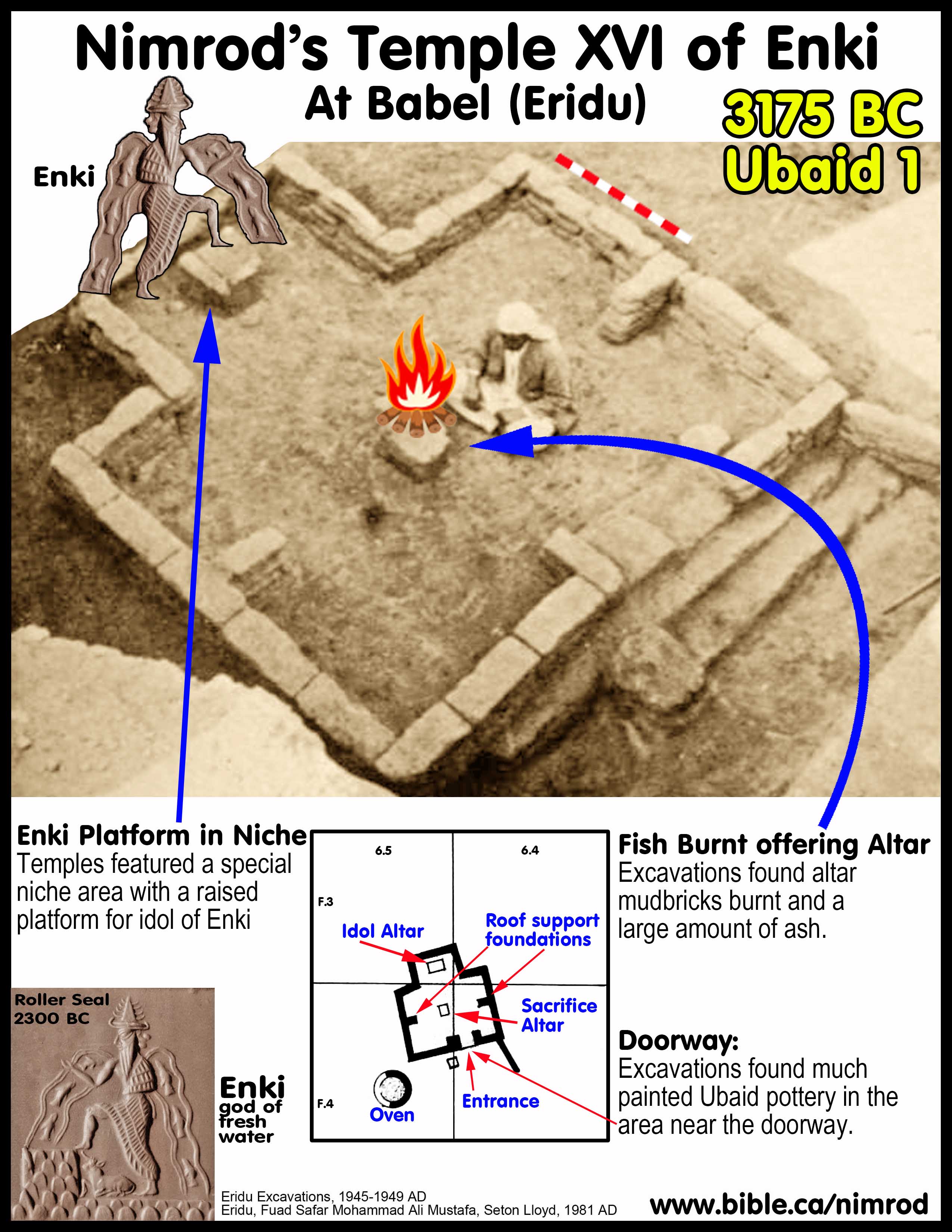
b.
Archaeological: The graves of 3000 Hebrews: Ex 32:28. 3000
Hebrews were killed for worshipping the golden calf at the foot of Mt.
Sinai/Maqla. There are two cemeteries 5 km north at the foot of Mt. Lawz. An
older unexcavated cemetery is located at 28.640776° 35.369805° with an
elevation of 1437 m. A modern cemetery is located at 28.644000° 35.370000° with
an elevation of 1436 m. Professional excavations of these tombs could provide a
datable assemblage. Realistically, there is little chance that any of the tombs
date to the Late Bronze age time of Moses. The Hebrews were ordered to stay
away from the mountain because it was holy. Corpses were considered unclean and
touching one rendered one unclean for 7 days. This alone proves that it is
impossible for this cemetery to be from the time of Moses and conducting
excavations would be fascinating but irrelevant to the exodus narrative. Large
mountains were often venerated as temples for the gods and people over the
millennium chose burials at the foot of mountains. The massive Jewish and
Islamic cemetery east of the Temple Mount in Jerusalem are an example of graves
located near holy places. The author has excavated several ancient graves at
Khirbet el-Maqaitir that date to the first century AD.
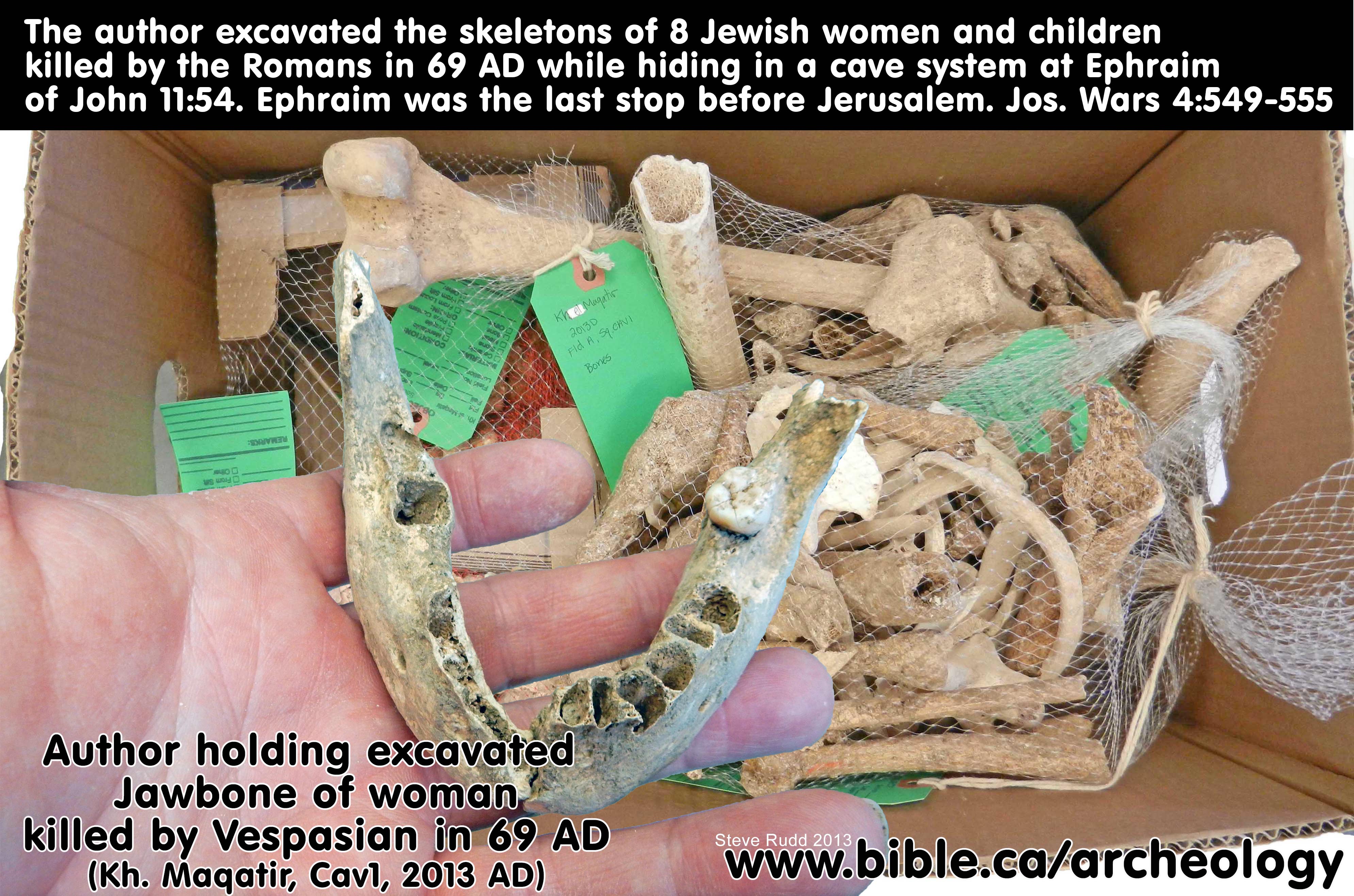
c. Archaeological: Boundary markers separating the mountain from the people: This could be human guards, a wooden pole with a sign, a rope of wool, a single rock, or a physical barricade of some type: Ex 19:12, 21-24. If one for more stones were found with ancient Hebrew inscriptions warning to “keep out”, this would be strong evidence of the Exodus. Scripture does not identify what the barrier was made of or how it functioned.
d. Archaeological: The twelve pillars Moses: Ex 24:4. Moses built this altar in a few hours and was likely small and built out of 12 uncut field stones. The same word for “pillar” is used in Gen 31:45 describing a single standing stone. "Then Jacob took a stone and set it up as a pillar." (Genesis 31:45). Standing stones at pillars are common in the ancient world. The author has been to the summit of Mt. Karkom several times and seen the sanctuary with single standing stone pillars. While the twelve individual stone may still exist at Mt. Sinai, identifying them as the ones Moses used would be impossible unless we found inscriptions of the names of one tribe on it. Scripture does not say that Moses inscribed the names on each of the twelve standing stones.
e. Archaeological: Elijah's Cave: 1 Ki 19:8-9, 866 BC: (28.588139° 35.373047°) Mt. Maqla does have a cave at an elevation of 1860 meters that might be "Elijah's cave" but many mountains have caves. If excavations found Iron II pottery dating to the time of Elijah in 866 BC when he fled to Sinai, that would provide evidence that it might be Elijah’s cave but still maybe not. Caves have wide date ranges of artifacts in them because they are used through the millennia. Earthquakes can collapse caves or create new caves. We cannot say that the cave on Mt. Maqla is the one Elijah visited, but it might be. Without professional excavation, the cave provides no evidence this is might be the location of Elijah’s cave at Mt. Sinai.
3. Potential Geological sites at Mt. Sinai:
a. Geological: The Rock that Moses struck at Mt. Horeb (Maqla) and the resulting riverbed. The split rock was not located in Rephidim but at Mt Horeb. The people complained about water at Rephidim but Moses struck the rock a few days later on Sivan 1 when he arrived at Mt. Horeb (Maqla) on day 47 from Goshen (Ex 17:6). This was the massive water flow that resulted from Moses striking the rock which the 3 million Hebrews used as their main water source for the 11 months they camped at Mt. Sinai. Moses told the Israelites to wash their clothes in the water from the split rock on Sivan 4 in preparation for God descending on Mt. Sinai in fire on Sivan 7. Moses ground up the golden calf and sprinkled it upon the waters of the split rock at the foot of the mountain. After 3400 years, many earthquakes, soil erosion and drift matrix, it is impossible to locate with any certainty at Mt. Lawz or Maqla. The existing wadis are the result of massive mountain water runoff. Wadis are extremely dangerous because they surge much like a tsunami. In 2018 AD, ten students in Israel were killed after the trip to Nahal Tzafit wadi despite storm warnings. The water swept down the wadi at 100 km per hour carrying with it huge boulders in the initial wave crest of water rising 4 meters. It sounded like a freight train and the student were unable to escape. The Wadis at Lawz/Maqla have flash-flooded with great destructive power thousands of times since 1446 BC. There may have been a river feeding a series of natural low areas that formed as lakes within a 5 km radius of the base of the mountain.
b. Geological: The cleft of the rock when God passed by Moses: Ex 33:22. A cleft is a split in the rocks. All mountains have thousands of places with split rocks that a man could stand between. Finding this exact “split rock” on the mountain is impossible, unless Moses created his own rock art (petroglyph) by scribbling “Moses was here” in Hebrew.
c. Geological: Visit of the 70 Elders: Exodus 24:1,9: The Bible does not say anything about a plateau or where they stood. There are hundreds of places on Mt. Maqla and Mt. Sinai where 70 men could have stood. They might have been standing on the 45-degree vertical trail path that leads to the summit, each one higher than the man below him. Although there is a plateau halfway up the Mt. Maqla at 1860 meters near the cave described above where the 70 elders could have stood, every mountain has plateaus. We have no idea where the 70 elders stood, and we probably never will.
d. Geological: A blackened summit by the fire of God: Ex 19:18-19. Geologist Dr. John Morris told the author, that the Jabal Maqla rock he examined is normal metamorphic rock typical for the volcanic area it came from, there was nothing strange about it nor any sign of plants melted into the rock. Fire does not change the colour of granite. We know for certain that the black rock on the summit Mt. Maqla is natural and not the result of heat or fire. While scripture says that God brought fire down onto Mt. Sinai, finding evidence of this even is highly speculative. Some have suggested Mt. Sinai was a volcano but Mt. Lawz and Maqla are not volcanos even though they, like all the area mountains, have volcanic rock called basalt. Volcanos are extremely dangerous with rock, heat and toxic gases being thrown for many kilometers. Glen Fritz agrees that Lawz and Maqla are not volcanos and confirms through scientific testing that the “blackened rock” is natural: “Regardless of the heat intensity, the basic chemical and elemental composition of granite rock is not affected. It might melt, flow, and recrystallize. It could theoretically vaporize at extremely high temperatures. But it would not transform into the dark rock found on Jabal al-Maqla. … Basic principles of geology rule out the proposition that the ambient granite was metamorphosed into black rock from intense heating. Furthermore, the idea that the granite color was altered by a generalized heating process or by desert varnish formation is contradicted by the delineated margins of the dark rock and the presence of light-colored aplite dikes within it. … The geological history and data fully explain the presence and character of the dark rock on the heights of Jabal al-Maqla, which precludes the need to attribute it to a supernatural heating event during the Exodus.” (Exodus Mysteries, Glen Fritz, p295, 298, 323, 2019 AD)
B. Map of Unicorn Archaeological sites at Mt. Sinai:
1. Arial map of Unicorn Archaeological sites:
2. 3D map of Unicorn Archaeological sites:
C. Unicorn Archaeology
of the “split rock”:
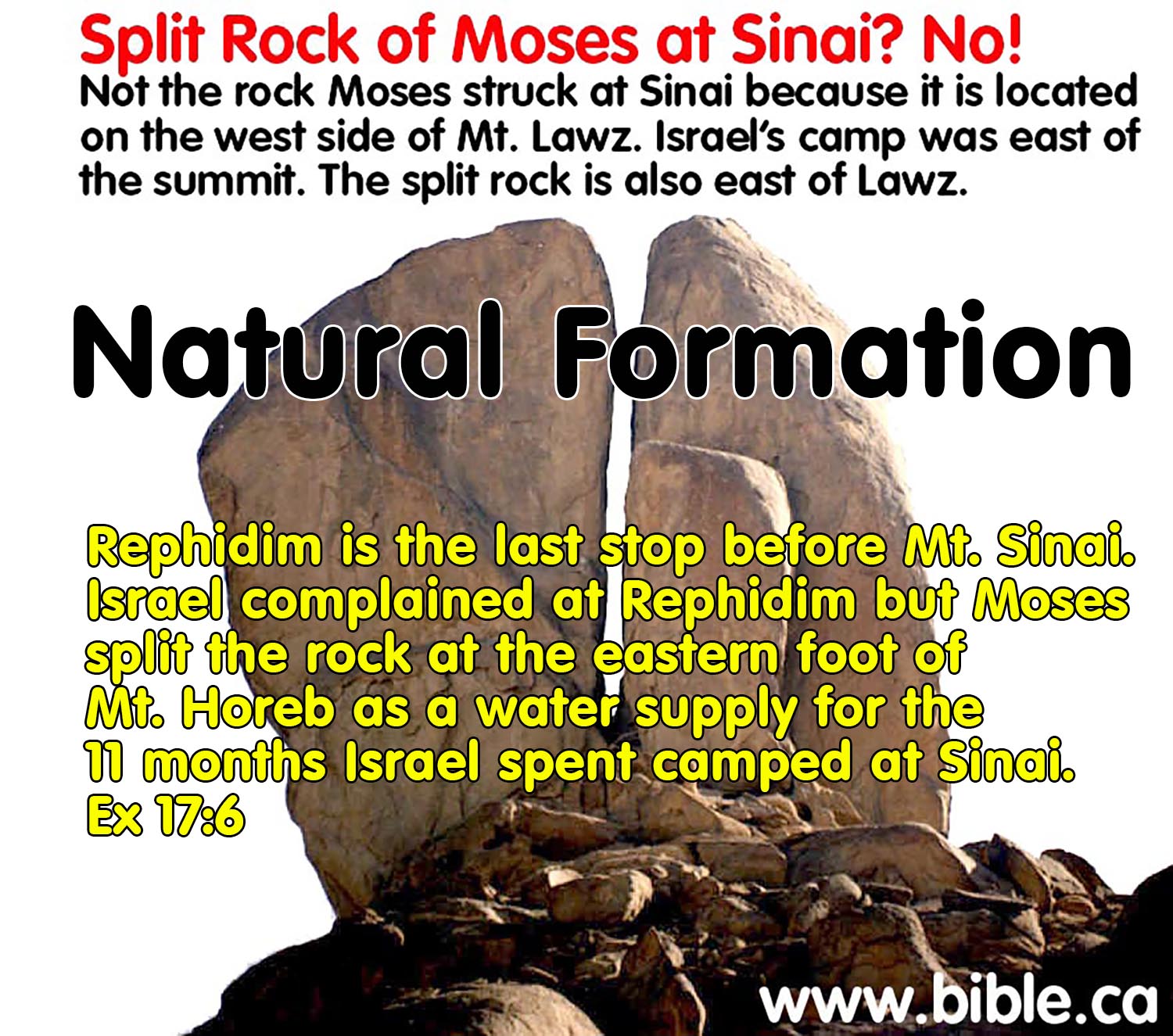
1. Split rock of Moses: 28.726000° 35.236000°, 984 m (Common natural formation)
a. This is a classic example of “cell phone camera archaeology”. All you need to be an expert is a cell phone, a wild imagination and Facebook. “I came, I saw, I blogged”!
b. This is a common natural formation that looked nothing like this at the time of Moses. Every first-year geology student knows that it is 100% certain that the way this natural formation looks today is nothing like what it looked like 500 years ago. At the time of Moses, this rock was probably below surface level. Wind and natural acid rain erosion slowly removed the dirt and the rocks gradually became visible. The crack is most likely less than 500 years old and occurred during one of the many earthquakes (January 18, AD 749) or just natural erosion. The rock can be seen today is shedding an inch of outside rock like a dead tree sheds it bark.
c.
This natural formation is on the wrong side of Mt. Sinai to serve as the
main water supply 3 million Hebrew for 11 months. If the camp is on the east
side, and the water supply was on the west side, this would mean the Hebrews
would have to haul water about 100 km around the mountain.
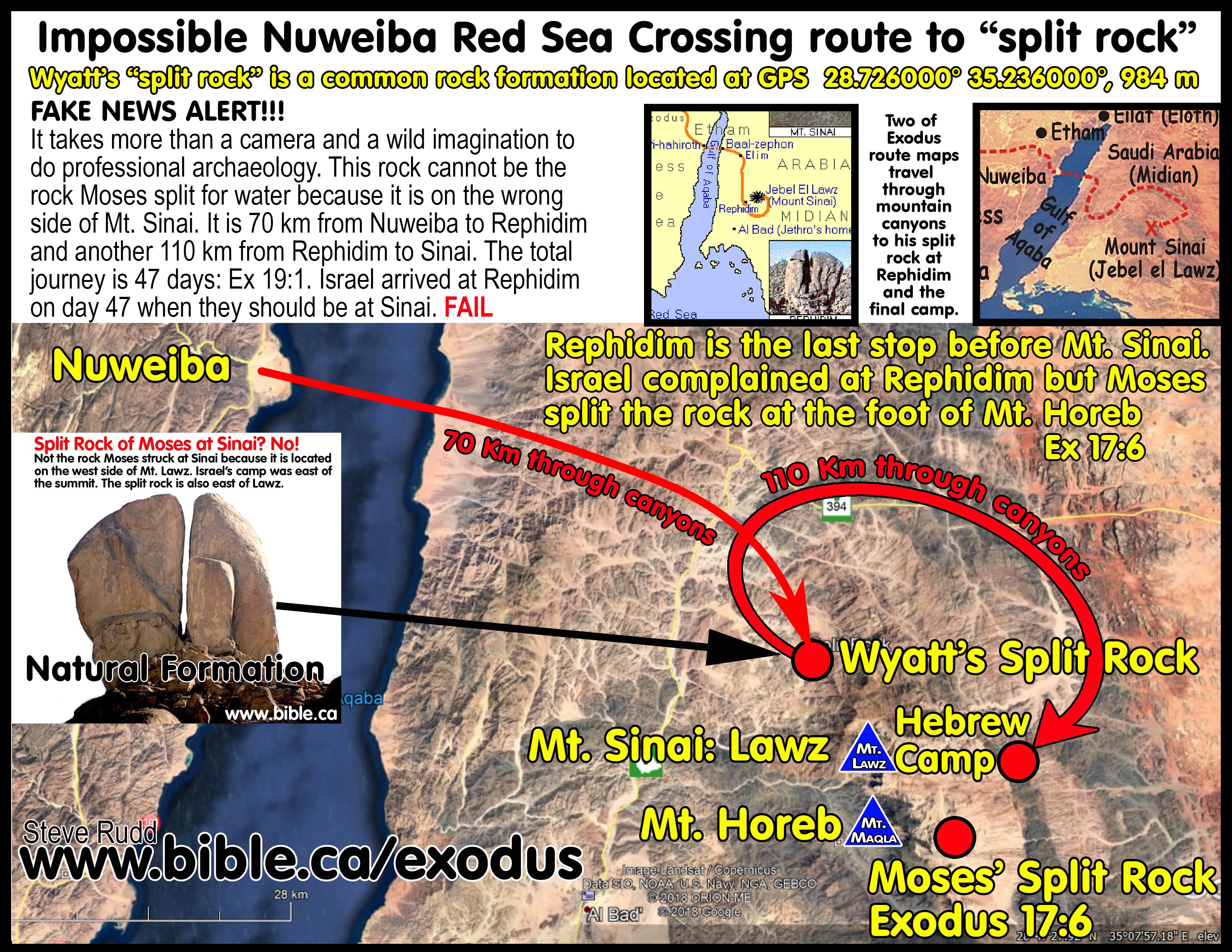
d.
The Wyatt exodus route map ignores the second Red Sea camp after Elim.
Rephidim is the last of 9 camps between the Nuweiba and Mt. Sinai. It is 8
stops and 65 km from Nuweiba the split rock at Rephidim but the distance
between Rephidim to Mt. Sinai 80 km. Something is seriously wrong when the
first 8 stops travel 65 km but the last stop travels 80 km. Even worse, one of
the exodus route maps tracks south from Rephidim directly over the top of the
mountain range. The Nuweiba exodus route maps are topographically and
chronologically impossible with and almost no detail. This illustrates the
shallow research undergirding the Nuweiba Red Sea crossing today.
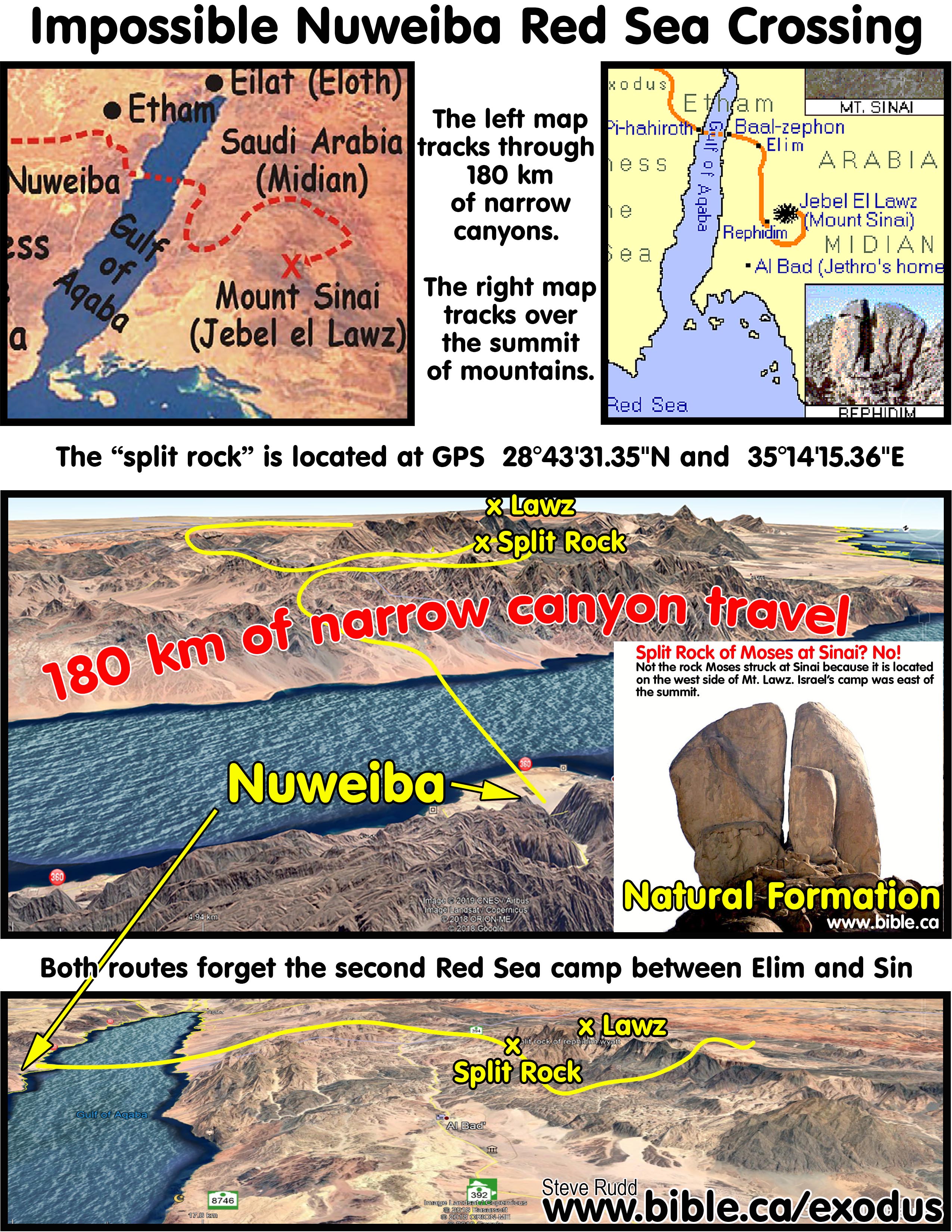
D. Unicorn Archeology of the “L-shaped altar of Moses” at Mt. Maqla
1. The odd “L-shape” has spawned many theories. The professional archaeological report, AD 2002 “Al-Bid”, concluded this was housing for the Nabatean marble quarry near the summit. “All available evidence suggests that this building was most likely the residence of the workers of the quarry and for keeping animals used for the transportation of stones along the paved track, part of which is still well preserved at some places.” (Al-Bid, Ansary, p66, 2002 AD).
2. There are three archaeological elements that are all connected as a Nabatean marble quarry and workshop. The AD 2002 “Al-Bid” excavation report demonstrated that the assemblage from all three sites was Nabatean (1st century AD) and for a single occupational unit.
a. The Nabatean marble quarry located at 28.580483° 35.354756°, with an elevation of 2000 m 2.5 km up the wadi from the “L” shaped structure.
b. The Nabatean “L-shaped” structure located at 28.584697° 35.378734° with and elevation of 1557 m.
c. The unfinished Nabatean marble column sections lay abandoned 2-5 meters from the “L-shaped” structure.
3.
The Nabatean marble quarry near the summit of Mt Maqla:
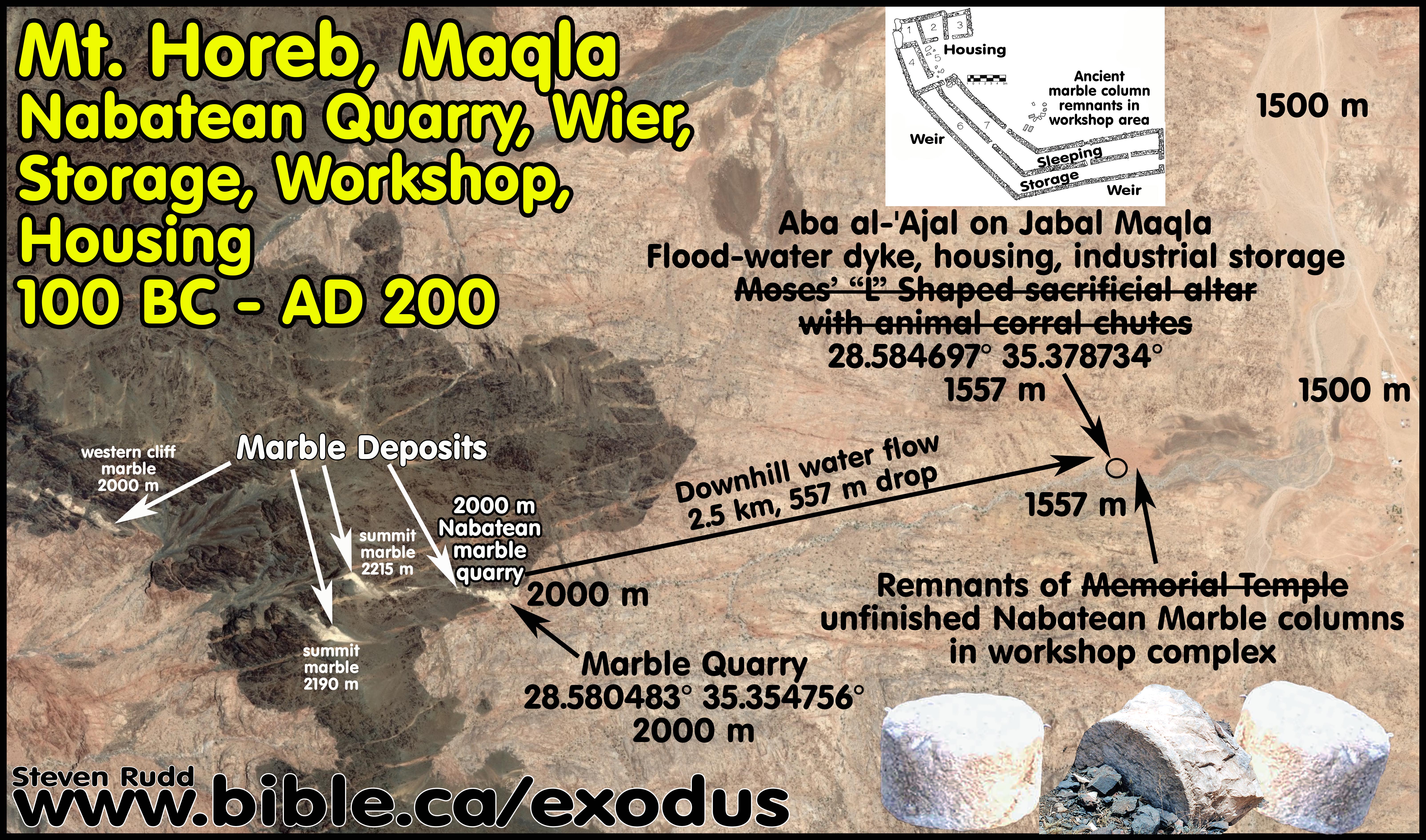
a. There are four clear marble deposits on Mt. Maqla seen in the photos.
b. Starting at the “L-shaped structure, you walk uphill for 557 meters for 2.5 km to reach the Nabatean marble quarry.
c. The elevation of the marble deposit is 2000 meters and the summit 2215 meters.
d. Clear evidence of first century Roman and Nabatean quarrying techniques are visible today.
e. The wadi ravine connects the quarry directly to the Nabatean quarry workshop. The Nabateans would mine the raw marble, transport it downhill to the workshop, then manufacture the marble columns. The Saudi excavation report found evidence of a manmade “paved path” to transport the raw marble 2.5 km down the wadi ravine to the marble column workshop.
4. The UIA (Unicorn Internet Archaeologists) commonly describe the first century Nabatean “L-shaped” structure as an “altar of Moses with cattle chutes and corrals for rapid sacrifice. Another good example of “I came, I saw, I am now an expert”. It is embarrassing to see Christians make these ridiculous claims and broadcast them all over the internet in contradiction to professional archaeological excavation reports and common sense. Nobody builds a sacrificial altar beside a major mountain wadi which is destructive, unpredictable and unusable when cut off by flooding.
5. In 169 BC, Agatharchides of Cnidus documented how well watered and lush the Wilderness of Shur was. This shows that rainfall levels during the Nabatean period were much higher than today. The Wilderness of Shur is Agatharchides’ “large plain” located is directly west of the Straits of Tiran SE or Al Bad: “After what is called the Laeanites Gulf [of Aqaba], around which Arabs live, is the land of the Bythemaneans. It is a large plain, all of which is well watered and lush with vegetation, albeit only dog's tooth grass, lucerne and lotus as tall as a man. All crops are restricted to this, and people cultivate nothing else. For this reason there are many wild camels in the plain and numerous herds of antelope and gazelles, many flocks of sheep and untold numbers of onagers and cattle. Joined to these advantages, however, is a countervailing evil since the region abounds with lions, wolves and leopards so that the natural bounty of the land is the cause of misfortune for its inhabitants. (Agatharchides of Cnidus, On the Erythraean Sea 169 BC, translated by Stanley M. Burstein, 1989, book 5, fragment 91a. Photius 897 AD, Cod. 250.89, 457b)
6. Unicorn Internet Archaeologists (UIA) reject the existence of the “paved track” which was noted in the AD 2002 Al-bid report because they were unable to find it and blog about it as they climbed the 2.5 km up to the marble quarry. They probably stood right upon this paved track while falsely accusing the Saudis of fabricating the whole thing. While the Saudi report provides no photos or other details, evidence for it was documented somewhere along the 2.5 km wadi ravine or they would not have said so in the final report. Quibbling over whether the paved track existed or not is irrelevant because we know for certain the quarried marble was transported in some way to the workshop below were the unfinished Nabatean marble columns lay abandoned. The Saudi report makes a reasonable assumption that animals were used to transport the marble down the wadi ravine.
F. The “L-Shaped” structure was a Nabatean water weir to protect the marble column workshop from flash floods:
1. Based upon the AD 2002 “Al-bid” excavation report, the Nabatean “L-shaped” site is primarily a water weir to protect marble column factory from the flooding wadi. The “L-shape” precisely follows the contour of the wadi water flow as a deflection device. The water flow of the wadi determined the “L-shape” design of the weir. The original design of the architectural installation as a weir was expanded to include housing for the managers, sleeping quarters for the workers and industrial storage. The weir was so well designed with its 75 cm thick walls, that the wadi floodwaters continue to be diverted effectively for the last 2000 years. Further excavations may find that the foundation below the walls was man-made fill to change the course of the wadi in the dry season to help create the flat workshop area. Flash foods are common, and the wadis carry large volumes of highly destructive water. The wadi determined the unusual shape of the “L-shaped” weir to protect the workshop area from being destroyed by one of the many flash floods each year.
2. The two megaliths on the NW corner of the weir structure were not an altar but important design elements that provided strength in diverting the flash flood water. If these two megaliths were not located exactly where they were in the first century, the entire area would likely have been swept away for floodwaters.
3. Men working at the summit marble quarry would roll or drag the raw rock 2.5 km downhill to the “L-shaped” marble workshop. The outside work area is the first level ground downhill from the quarry. The area is perfect as a marble workshop because it is large, flat and near the bottom. There are no other suitable workshop areas above the “L-shaped” structure.
4. Bone and ash found inside the two long buildings date to the Nabatean era because of the pottery mixed in these same loci. We would not expect to find bone and ash in this area of the “altar” if this is where the sacrificial animals were corralled. Most first century homes housed animals on the first floor while sleeping quarters were on the second floor. When there was no room on the “second floor” for Mary, she was placed on the main floor of the family house where she gave birth beside the animals and lay baby Jesus in the animal manger. Perhaps the structure burned, collapsing the wooden roof and killing the animals. Perhaps the area was used as food preparation area by the quarry workers. We just do not know. The author has excavated hundreds of squares, and almost without exception, animal bones are found in every one of them. Ash layers (loci) are common and sometimes provide evidence of dated destructions. Ash and bone are always dated by the pottery and other objects found inside the loci. Additional dating comes from the assemblages found in the loci above and below the ashes and bones.
G. Three times Glen Fritz distorts Saudi official top plan:
Glen Fritz misrepresented the “AD 2003 Al-Bid” excavation top plan three times in his own version of the same top plan. Fritz’s top plan erases 5 doors seen on the official top plan, adds two doors where the official top plan has walls and then he removes a megalith to create a second door in room 1. These errors and omissions hinder the quest for truth and add confusion and distortion to the real set of facts established by the Saudi excavation report. Fritz adds to the huge volume of misinformation surrounding this archaeological site.
1. First Error: Fritz removed five 50 cm doors which are clearly visible in the Al-Bid excavation top plan: two exterior doors and three interior doors. He says, “The two 33 m (110’) long corridors or chutes only have an interior width of 2.1-2.4 m (7-8’), which is an awkward dimension for habitation or storage. Plus, there are no signs of portals or windows.” (Exodus Mysteries, Glen Fritz, p254, 2019 AD). And again, “here are no structural signs of windows or portals” (ibid. p253) A portal is another name for a door or passageway. (ibid. p247). Fritz’s two statements about there being “no doors” is confirmed in what is drawn on his own top plan. Fritz removed these five doors because they contradicted his fiction of what this architectural installation would look like if it was used as animal chutes for rapid sacrifice. He never indicates that his top plan deviates from the original Al-Bid top plan by erasing these 5 doors. These exact position of these five AWOL doors are easy to locate on site today. It is entirely possible that some Unicorn Internet Archeologist (UIA) visited the site and engaged in archaeological terrorism by adding stones into the 5 door opening to create one continuous wall because it better fit his preconceived delusion that these were animal chutes. The author excavated one of the largest first century cities (Ephraim of John 11) in Israel at Khirbet el-Maqatir until the site closed in AD 2016. The site today is barely recognizable compared to what was documented on top plans in high detail. There is no excuse for altering an official excavation top plan based upon your site “walk-through” unless you provide some very good reasons. In this case, Fritz just removed them leaving others to falsely assume that what he drew was faithful to the original AD 2000 Al-Bid report.
2. Second Error: After removing 5 doors which were on the official excavation top plan, he then adds two more doors which are not on the official excavation top plan with his red dotted circles. In this way he completes his own fictional image of what this structure should look like instead of what it really looked like based upon professional 3-dimentional archaeological excavation. He adds four dotted circles at each end of the long corridor Rooms 6, 7 to indicate where doors were located at the time of Moses. By completely knocking out the four walls (two of which already had 30-50 cm doors) the L-shaped installation looks exactly the way he needs it to look as animal chutes. Because the scientific evidence on the official top plan contradicts his image of what the structure should look like, he feels justified in drawing it the way he thinks it should look. In a convoluted way, he admits this: “One would expect that [at the time of Moses] the chute areas 6 and 7 could have served as animal pens, which would require closing up their ends [i.e. the open ends that existed at the time of Moses were bricked as we see them now on the top plan, up by those who used the structure hundreds or thousands of years later for a different secondary use]. Hence, the stonework in these areas, circled in Figure 13.16, may reflect later modifications. (ibid p252, comments in [square brackets] by Steven Rudd). In simple words, the official top plan found walls, not doors because the doors were bricked in centuries later during secondary use long after Israel left Mt. Sinai. At Khirbet el-Maqatir, the author has excavated walls where a door was later added and doors that were later bricked up a few decades later. In every case, these “renovations” were very easy to identify which is why Fritz should just stick with the official excavation top plan and stop playing Unicorn Archaeologist.
3.
Third Error: Fritz says, “The
northwest end of these “walls” is terminated by a large round boulder
(megalith) measuring 2.5 m” (ibid. p248). This is misleading because the NW
wall is terminated by two megaliths, but he only draws one. Fritz deviates from
the official excavation report by removing the smaller megalith located exactly
on the NW corner of the entire structure that. He focuses on the larger
2.5-meter megalith (bolder he calls it) as part of his possible “altar” which
included brass fire grates on top of the walls of Rooms 1, 2, 3 which are each
about 3 x 3 meters in size. Although Fritz suggests that each of Rooms 1,2,3
individually (3 x 3 meter) about the same size of the Altar of Burnt incense
for the Mosaic tabernacle (2.7 meters), he envisions one large altar composited
of all three rooms, covered with brass grating that is a rectangle of 3 x 9
meters. A single 3 x 6 meters altar created from rooms 2,3. The problem is that
the tabernacle altar was square not rectangular. Fabricating a second door in
Room 1, opens the opportunity to new unicorn speculations about how the one
special megalith was the actual sacrificial stone in a room with two doors
allowing access directly to the outside for a variety of maintenance reasons
like discarding bones and ashes! Both megaliths that were used as the NW corner
of Room 1 can be seen in situ today, exactly as the Saudi Al-Bid report
shows on the official excavation top plan. These two megaliths are located at
the exact location of where a flash flood from the mountain wadi would exert
the most force and serve as massive deflectors to redirect the water around the
Nabatean workshop. The two megaliths have sat in their current location before
construction of the water weir began or they may have been rolled into place.
In either case, the north and west walls of Room 1 were build contiguous to
where the megaliths rest today and it is misleading to remove the smaller
megalith from the top plan to create a door, when no door or opening exists
even today.
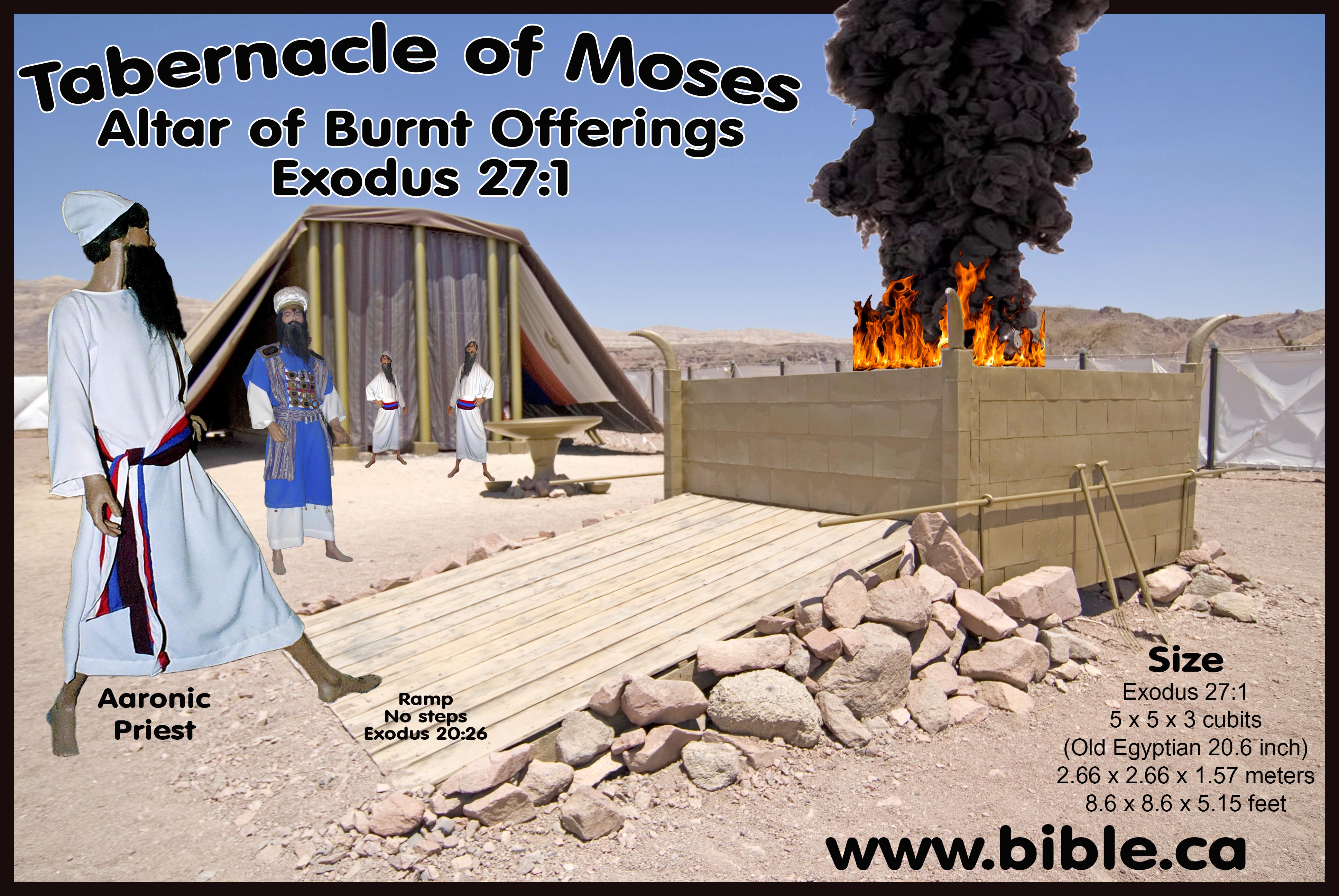
4.
Nabatean housing for the marble factor workers: Glen Fritz opens
his discussion of the Altar with the “odd hockey-stick bend” (as he calls it),
with this incredible false statement by quoting journalist Larry R. Williams, “We
have absolutely no idea what this formation is or what it is doing at the base
of Jabal al-Lawz. But some things we do know. It is not the foundation for a
house because it does not allow enough space for any type of living quarters”
(ibid. p246). Evidently, Glen Fritz, with his PhD of Philosophy in
Environmental Geography, was unaware that a journalist may not be the best
source of archaeological information about ancient Hebrew and Nabatean housing.
A clue not to use this quote was the fact that Unicorn Archaeologist Williams
got the location wrong because the installation is NOT at the base of Lawz, but
Maqla. The size of Rooms 1,2,3 are about 3 x 3 meters and Room 4 is about 3 x 6
meters. The typical bedroom today is about 3 x 3 meters. Iron age four room
Israeli houses typically have the same size rooms. Since the L-shaped installation
was Nabatean, Mampsis a Nabatean city, provides an excellent comparative for
contemporary room sizes. Mampsis or Mamshit, is located 35 km SE of Beersheba,
30 km SW of Arad, 27 km west of the Salt Sea and 25 km NE of Glen Fritz’s
location for Kadesh Barnea, (which he puzzlingly locates deep inside the tribal
territory of Judah of the promised land). Mampsis was the last city build by
the Nabateans around 150 BC. It had continuous occupation through the early and
late Roman periods, through the Byzantine until it was destroyed by the great
earthquake of AD 749. Many of the living quarter rooms in the houses in Mampsis
are smaller than Rooms 1,2,3 in the Nabatean marble workshop at the foot of Mt.
Maqla in Saudi Arabia. Mampsis, like many ancient cities, were built following
the surrounding topography. The SE wall of Mampsis features an L-shaped
structure which is 25 meters long. This compares to the Nabatean L-shaped
structure at 36 meters. Both structures abut a wadi. While the Mampsis L-shaped
structure is a Byzantine monastery called the “Church of the Martyrs” these
rooms that flanked the outside wall of the city were marked in the excavation
report as housing! This is quite common. Rahab the Harlot’s house was on the
outside wall of Jericho. Iron age fortresses were oval because they were built
to follow the contour of hill tops and usually featured small casemate rooms
around the perimeter. These can be seen today at Kh. Qeiyafa (Iron I age). The
author has excavated many rooms on the inner-city wall at Khirbet el-Maqatir
(Iron) and Shiloh (Late Bronze, Iron) that were smaller than 3 x 3 meters. The
conclusion is that the four rooms at the Nabatean marble workshop at the base
of Maqla were the prefect size for housing. Since it was an industrial workshop,
Rooms 1,2,3,4 were probably the manager’s quarters and the two long Rooms 6,7
were where the workmen slept. There was a total of 7 doors into Rooms 6,7. A
man only needs 6 feet to sleep and Room 6 was 8 feet and Room 7 was 7 feet.
This permitted men to sleep in rows with an easy walking path to exit one of
the 7 doors to the outside. The shape and size of Rooms 6,7 were also typical
of storage rooms. The idea that this was an altar of Moses with cattle chutes
for rapid sacrifice which became a secondary use Nabatean marble workshop is
pure fiction without any archaeological support. The entire architectural
installation is Nabatean and no earlier.
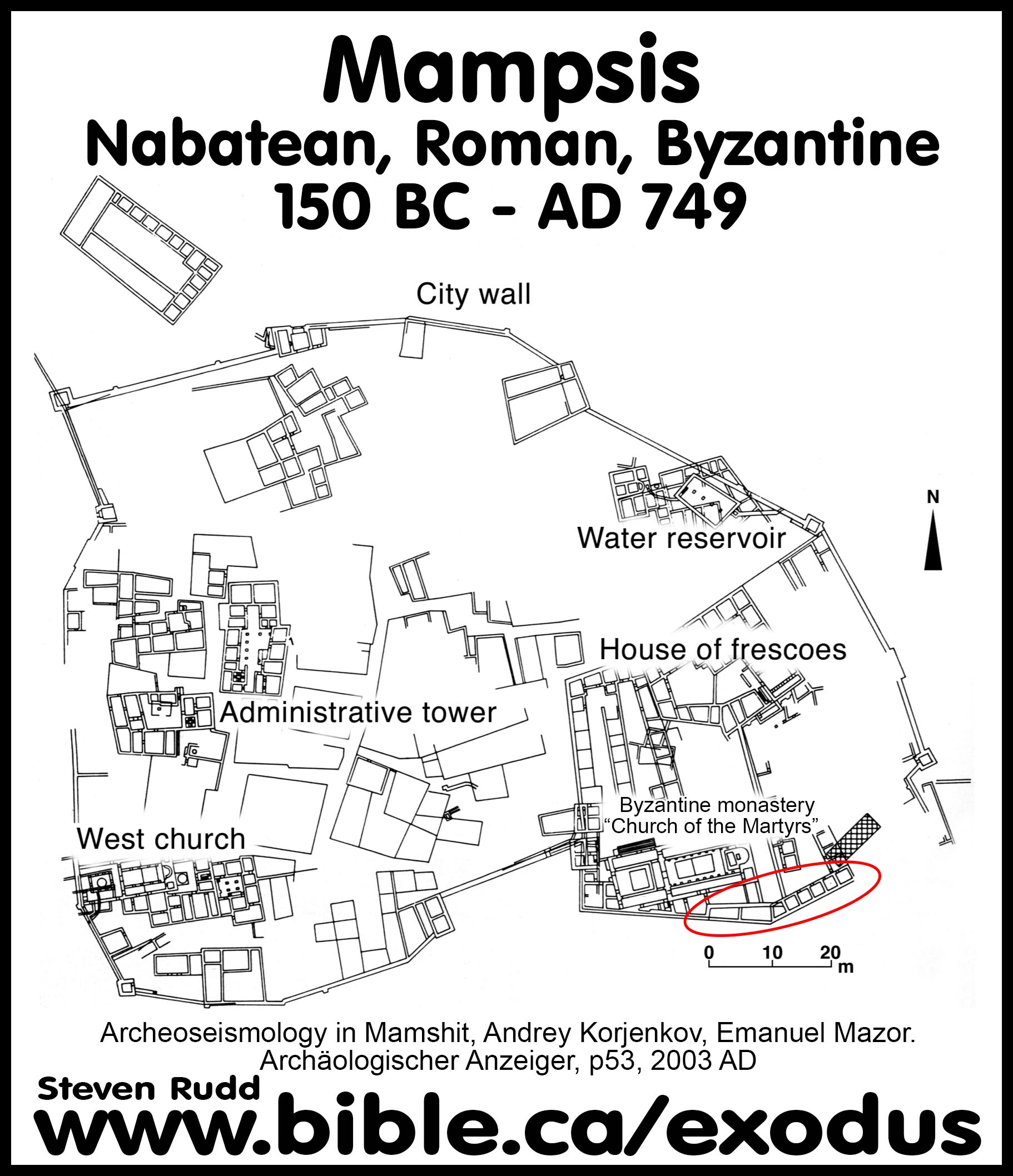
5. By making all these critical changes to the official top plan without informing his readers, Glen Fritz greatly compounds all the confusion and misinformation surrounding this architectural installation on the internet today. People are already using his bogus top plan as a “archaeological proof” this was an altar of Moses in 1446 BC.
H. Unfinished and discarded Nabatean marble column sections:
1. The marble columns can be dated to the time of Christ (Roman/Nabatean) by the photo above. The chisel marks, size and manufacturing procedure are immediately recognizable as Nabatean. The same are found in many first century Nabatean sites including Petra. White marble is rare and valuable, but we have no idea what the Nabateans were building or the final destination of the marble columns. It is certain they were transported off site. Several column sections would be stacked upon each other as structural supports for second floors or roofs. They would then be plastered white to a smooth finish and painted bright colours like red, yellow, green and blue.
2. Unicorn archaeologists embarrassed and humiliate themselves once again by selling books and videos that say these were the 12 columns Moses erected for the twelve tribes in Ex 24:4-6. Not to be outdone in the world of raw fantasy, others affirm it was a memorial temple built by Solomon then made into a mosque by Suleiman [Arabic = Solomon] the Magnificent in AD 1550.
3. Without a single scrap of archaeological evidence, Glen Fritz concludes that both the quarry and the unfinished marble columns were the work of diaspora Jews who began to build a memorial synagogue or temple to commemorate Moses sacrificial altar (L-shaped building) and his receiving the Law at Mt. Sinai but never finished it. Although unfinished, Fritz suggests the structure had “marble floors”. The unfinished Jewish structure was later “desecrated” and totally robbed by the Muslims leaving nothing archaeological behind except for the unfinished marble columns. The notion that Muslims would be motivated to desecrate and totally disassemble the Jewish synagogue/shrine is contradicted by the historic fact that churches, synagogues and pagan temples were converted into mosques. Repurposing non-Islamic places of worship into mosques was a way to show the superiority of Islam through the conquering providence of Allah’s will. The local report of Muslims robbing the marble columns for the Haql mosque in the 1930’s is contradicted by the fact that several nearly complete column sections were left behind in situ on the surface. A memorial temple with a marble floor cannot be robbed so thoroughly that no archaeological evidence remains. The remoteness of the site guarantees that only the best building materials would be transported to the location of their secondary use, but most would be left behind. In the author’s book on the Origin of Jewish Synagogues, there was a well-established architectural pattern for columns, foundation, niche, floor, walls and full immersion mikveh. The “L-shaped” structure survived 2000 years nearly complete beside a Jewish memorial synagogue/temple where all the evidence has vanished. If there was a Jewish synagogue or memorial temple here, evidence would be obvious by conducting a simple site walk but there is nothing. A robbed marble floor would leave hundreds of broken fragments visible on the surface. In AD 2016 the author excavated a single marble fragment of ornamental chancel screen from a Byzantine church at Khirbet el-Maqatir, but this one piece proved a chancel screen was in use. Why do we have almost all the remains of the “L-Shaped” structure but none of the remains of the temple? In a spectacular display of circular reasoning, Fritz solves the problem of lacking evidence by suggesting the Jewish memorial temple was never finished, which means the only actual archaeological evidence is the in situ unfinished marble columns. Despite all this Fritz says:
a. “Considering the role of synagogues in early Jewish history, the structure at the base of Jabal al-Maqla may have been designed as a small, open air synagogue, with a paved marble floor and marble benches, with decorative pillars spaced on the periphery. If this structure originated as a Jewish shrine, that circumstance alone would predict its eventual desecration in the Islamic period.” (Exodus Mysteries, Glen Fritz, p288, 2019 AD)
b. “The hypothesis that the marble pillars were used in an edifice at the mountain is favored by the local Bedouin testimony that some of the marble was moved to a mosque in Haql about 1930. The existence of white marble in a Haql mosque could seemingly be investigated by the Saudi archaeologists with a few phone calls, but the Saudi reports are silent on this detail.” (Exodus Mysteries, Glen Fritz, p289, 2019 AD)
c. “The mere presence of an extravagant edifice in this isolated location suggests some type of important religious and/or political commemoration. However, the lack of any known military or political motive favors a religious purpose. The why and the who of the edifice might be explained by the historical presence of a prosperous diasporic Jewish population in Arabia that associated this part of the Jabal al-Lawz range with Mount Sinai and decided to construct a memorial synagogue at the supposed site. In my opinion, the disarray of the remaining pillars at the base of the mountain, and the lack of any discernable foundation, suggest that the “memorial” was never finished. The multiple unfinished stone cuts in the quarry would also support this idea.” (Exodus Mysteries, Glen Fritz, p289, 2019 AD)
4. Perhaps we should just accept the evidence documented in the AD 2002 Al-Bid excavation report that this was a Nabatean marble quarry and workshop where the finished columns were transported to an unknown distant site.
I. Unicorn Archeology of the “Aaron’s golden calf altar”:
1. Aaron’s golden calf altar with Hebrew cow petroglyphs: 28.581465, 35.396110, 1529 m (Common natural formation, not man-made)
2. Its amazing how much time and energy has been spent on this natural pile of rocks. Immediately after the Noahic flood in 3298 BC, this looked like a typical hill and the rocks may not have been visible. Over time, the soils and sediments of these natural formations are eroded and washed away leaving what we see today. Geologically, many of these megaliths were unquestionably one slab that has broken into several smaller sections.
3. There are two important proofs that this is a natural stone pile and not manmade:
a. First, the large megalith has broken into two pieces. The larger megalith is oriented flat on the horizonal plane while the smaller megalith that broke off is laying at a 45-degree angle to horizontal. The desert patina at the break is indistinguishable from the desert patina on all other surfaces. This proves the break happened a long time ago.
b. Second, the infamous cow petroglyphs are drawn onto the smaller broken petroglyph that fell oriented exactly upright. If they had been drawn on the “altar” megaliths at the same time the altar was built by 83-year-old Aaron in a few hours, these drawings would now be on the same angle as the broken off megalith. If the zoologic petroglyphs were drawn on the altar at the time it was constructed, they would now be oriented on a slant. This proves this is a natural stone structure where large sections of the megaliths had broken off in antiquity after which the cow artists arrived to draw the animals on the broken-off megalithic chunks in the normal up position, even though the “rock canvas” was slanted 45 degrees.
4. There are many other examples of similar looking piles of rocks within a 5 km radius of this natural rock pile.
5. The idea that this was Aaron’s Golden Altar is so utterly stupid it is humiliating for professional archaeologists to have to talk about it.
a. In Ex 32:1-6, Aaron saw the golden calf (possible on a stone platform) and build his altar in front of the golden calf. The golden calf never sat on Aaron’s Altar. 83-year-old Aaron built the altar himself in one morning.
b. Zoomorphic objects that were worshipped in the Late Bronze Age were less than 30 cm in height.
c. Altars
at this time tended to be small as witnessed in many ancient pagan temples. For
example, Nimrod’s temple 16 at Eridu (Babel) dates to 3175 BC (Ubaid 1) and the
idol of the god Enki (freshwater god) was placed on a low small platform
(30x30x30 cm) in a niche at the one end of the room. A few meters away in the
center of the room was a low small altar (30x30x30 cm) upon which burnt
sacrifices of goatfish were made to the god Enki.

6. The fiction that this natural rock formation was Aarons’ golden calf altar in 1446 BC is one of the best examples of UIA (Unicorn Internet Archaeology) where all you need is your cell phone to take a photo and a hit of magic mushroom to dream up the fantacy.
J. Unicorn Archeology of the “Hebrew Bovine Petroglyphs”:
1. The petroglyphs found on this natural formation are unremarkable since there are likely millions of examples of similar rock art in Israel, Jordan, Egypt and Saudi Arabia.
2. The cow rock art in the Mt. Lawz and Mt. Maqla region are not Egyptian and look very different from Egyptian depictions of the sacrificial Apis bulls or that of Hathor the cow goddess with her cute little cow ears adorned with the sun and crescent moon on her head.
3. The official AD 2002 Al-bid report slams the Unicorn Internet Archaeologists (UIA) for making false and factually wrong statements:
a. “The calf-worship spread in the north and southern Arabia. There is no doubt that the animal representations at the foot of Jabal al-Lawz and its surroundings were part of the overall cultural tradition. However, there is no correlation between the cattle figures located on and near Jabal al-Lawz and those worshipped in Egypt during Prophet Moses's time that is to say during the 13th century B.C. The figures of cattle located on Jabal al-Lawz and in the Tabuk area have absolutely no similarity to the Apis and Hathor bulls which were worshipped in Egypt during the Pharaonic period.” (Al-Bid, Ansary, p78, 2002 AD)
b. Thousands of petroglyphs of human and animal figures as well as a variety of Thamudic, Lihyanite, Nabataean and early Islamic Kufic inscriptions were registered during this survey. Hundreds of cattle figures from various cultural periods are located in different styles and compositions. The wild cattle attributed to the Neolithic period, wild camel of the Chalcolithic period and domesticated animals (dogs, cattle, camel etc) of the Bronze Age shed light on the environment and fauna that existed in northern Arabia in the past. It is also evident that the cattle figures located in northwestern Arabia including Jabal al-Lawz and al-Bide area have no similarity with the Egyptain Apis or Hathor which were worshipped during the Pharaonic period. It is also misleading to say that there were no cattle in Arabia before the Exodus. (Al-Bid, Ansary, p80, 2002 AD)
c. “Recent survey and excavations carried out by the team of the Deputy Ministry of Antiquities and Museums in 1415 AH/ 1995 AD, on Jabal al-Lawz and its environs discovered some new sites, particularly the painted cattle figures under a rock shelter. The rock art at al-Bid and Jabal al- Lawz areas represent various cultural periods from the Neolithic (c.6,500-5,500 BC) to the Nabataean (c. 100BC/100AD). The dating is tentative and relative based on stylistic similarities to other dated sites in the Tabuk area and in relation to cultural objects located on or near these sites (Khan, 19913 ,pp115-117). The painted long horned ox figures and other human and animal representations located near Jabal al-Lawz show striking similarities to those located in Tabuk, Hanakiya, Madinah and elsewhere in the Kingdom. Cattle figures on large scale are also located almost everywhere in the Kingdom such as Wadi Damm, Wadi Abgar, Wadi `Asafir in the northwestern region (Livingstone etal 1985,127-130) and Najran, Khamasin and Wadi Tathleeth in the southern region (Anati 1965). The cattle figures located on Jabal al-Lawz with geometric patterns on their bodies, and in one case a person worshipping an ox, are contemporary to the Nabataean period during which the marble quarry was active. Also, the typical Nabataean thin redwares were found on the settlement site at the base of the mountain. On the contrary, no other artifacts of earlier period could be located on or at the base of Jabal al-Lawz, which strongly suggests that the marble quarry, rock art and settlement site are all part of the same cultural period.” (Al-Bid, Ansary, p82, 2002 AD)
d. “The two authors [Larry Williams, Howard Blume] did not even attempted to see the pictures of Pharonic Apis and Hathor, which are absolutely different from those, carved on Jabal al-Lawz.” (Al-Bid, Ansary, p85, 2002 AD)
K. Solomon’s columns at Nuweiba: They are Roman, first century, end of Story: Fake news
L. Wooden Chariots and their wheels float, and contained no metal:

1. Movies often depict chariot wheels slowly singing to the bottom immediately after the waters drowned the Egyptian army. This is a cinematic fiction. Since chariots were made of wood they would simply float away. Chariots in the 18th Egyptian dynasty were not overlaid with metals except for ceremonial constructions never taken into war. In the exodus Egyptian army, the only possible chariot that contained any gold overlay, would have been of Thutmoses III, but he never entered the Red Sea with his chariot.
2. War chariots were made from 100% hardwood Tamarisk wood and chariot wheels contained no metal. Even the axle pins were wooden as witnessed in the chariot of King Tut.
3. Tamarisk is a dense wood that takes months to become waterlogged and sing to the bottom. This means that chariot wheels would immediately float to the surface and drift hundreds of kilometers before washing to shore or sinking to the bottom far far away from the Red Sea crossing site.
4. 18th dynasty chariots were made of Tamarisk wood and floated quite well. Tamarisk is also called, salt-cedar, and tamarix. The chariots from King Tut’s tombs seen in museums are made entirely of wood and rawhide and contained no metal. Later period chariots used a few small metal pins to hold wooden parts together but even these chariots floated on top of the water and did not sink.
5. When 250-meter-high walls of water at the Red Sea at Tiran “backtracked” upon the Egyptian army on dry ground, the forces were likely sufficient to splinter the chariots into toothpicks and all the wheels would float to the surface. The leather harnesses that tethered the chariot to the horses would likely break and the entire chariot would float to the surface. If the chariot remained connected to the horse after drowning, the buoyancy of the chariot might keep the dead horse at the surface. If both chariot and horse sank to the bottom, the body of the dead horse would float to the surface through bacterial decay in about two weeks. Looking for remnants of pharaoh’s chariot wheels anywhere, including the shallow waters at Nuweiba, is absurd given they would float hundreds of kilometers.
6. The dense grain of hardwood slows down water logging. If they had any pitch coating (buoyancy neutral) that would slow down waterlogging even more. The waterlogged chariot wheel eventually sank far from the original location after months of drifting. Looking in the shallow waters of Nuweiba for chariot wheels is misguided.
7. Wood in water decays rapidly unless it is in a deep-water, cold, oxygen-depleted environment. While the Gulf of Aqaba has several deep zones up to 1450 meters beside the Straits of Tiran, it is still very unlikely that floating chariot wheels would become water-logged and sink in that location. Even if chariot wheels did sink in one of these “deeps” it would be buried under several meters of sediment after 3400 years. It is also absurd to suggest that shallow water coral formations photographed today, which vaguely look like a chariot wheel, had originally formed around the wooden chariot wheel which has long since decayed leaving a coral outline. Coral is a living animal that constantly changes shape over time with growth rates of 2-10 cm per year. Coral formations today will look quite different even 10 years in the future.
8. Both wheels and the connecting axle of a chariot were 100% made of wood and contained no metal parts at the time of the exodus. Unicorn Internet Archaeologists (UIA) who show pictures of coral formations in shallow water as proof of the Nuweiba Red Sea crossing must be ignored as fake news. None of these coral formations were ever brought to the surface. In the few short years since these coral formations were photographed, they have changed and are now broken up by natural processes so that they no longer look the way they originally did. The underwater photos of random coral formations used by these UIA’s are no more scientific than photographing random clouds in the shape chariot wheels. Using this fake evidence of chariot wheel shaped coral formations at the Nuweiba beach brings well deserved ridicule and scorn from the professional world upon Christians in general and are a disservice to the cause of Jesus Christ.
9. Sources:
a. “The Egyptian chariots were of light and simple construction, the material employed being wood, as is proved by sculptures representing the manufacture of chariots. The axle was set far back, and the bottom of the car, which rested on this and on the pole, was sometimes formed of a frame interlaced with a network of thongs or ropes.” (Dictionary of the Bible, James Hastings, Chariot)
b. “Pictorial evidence from numerous reliefs plus several actual chariots from Egyptian tombs present a reasonably clear picture of how these war machines were made. In contrast to wheeled wagons used earlier and heavier chariots used later in parts of the ancient Near East, most chariots during this period were light vehicles built to carry two men. They were made mostly of bent hardwood and leather, with a few metal parts and wrappings of birch bark to repel moisture. … The Egyptians made their chariots from elm and tamarisk wood.” (Warfare in the Old Testament, Boyd Seevers, p129, 2013 AD)
c. “Professor Yigael Yadin maintains that during the earlier part of the 18th Dynasty, the Egyptian chariot was "exactly like the Canaanite chariot" both were constructed of light flexible wood, with leather straps wrapped around the wood to strengthen it, and both utilized wheels with four spokes. In Yadin's eyes the four-spoked wheel is diagnostic for dating purposes; it is restricted to the early period of the 18th Dynasty. It remained in vogue, he says, until the reign of Thutmose IV, when "the Egyptian chariot begins to shake off its Canaanite influence and undergo considerable change." Yadin believes that the eight-spoked wheel, which is seen on the body of Thutmose IV's chariot,8 was an experiment by the Egyptian wheelwrights, who, when it proved unsuccessful, settled thereafter for the six-spoked wheel. In short, "So widespread and meticulous is the delineation of the number of wheel spokes on chariots depicted on Egyptian monuments that they can be used as a criterion for determining whether the monument is earlier or later than 1400 B.C. … A chariot scene from the tomb of Ken-Amun (dated to the reign of Amenhotep II) shows a partially obliterated chariot. Four-spoked wheels are invariably depicted with the spokes in a 12, 6, 3, and 9 o'clock position, but in this scene the two visible spokes point toward 12 and 4 o'clock; this indicates a six-spoked wheel." (Observations on the Evolving Chariot Wheel in the 18th Dynasty, James K. Hoffmeier, Journal of the American Research Center in Egypt, Vol. 13, p43, 1976 AD)
d. “According to the evidence presented here, the six-spoked wheel is regularly portrayed in the chariots used by monarchs after Thutmose IV, the sole exception being the talatat scene from the Amarna period mentioned above. However, contrary to Yadin's position, the six-spoked wheel is found before 1400 B.C. But he is basically correct in stating that the six-spoked wheel is consistently shown on chariots after 1400 B.C. Yadin's explanation for the shift in the number of wheel spokes is hardly convincing. The Egyptians were certainly jingoistic, but it is stretching the point to believe that they would alter the number of wheel spokes merely to "shake off Canaanite influences," and thereby assert their nationalistic identity. They were eminently practical, and we must seek a practical reason for the change. The six-spoked wheel from the reign of Amenhotep II suggests that the shift must have begun even earlier. Thutmose III, Amenhotep IFs predecessor, launched at least military campaigns into Syria-Palestine; one might surmise that in these circumstances the Egyptian chariot would undergo certain changes in order to achieve maximum performance. Unfortunately we have no battle scenes with chariots in action until the time of Tutankhamun. Before this, chariots are limited to hunting, domestic, and procession scene.” (Observations on the Evolving Chariot Wheel in the 18th Dynasty, James K. Hoffmeier, Journal of the American Research Center in Egypt, Vol. 13, p44, 1976 AD)
e. "chariots also contained a few metal parts, usually bronze pins to fasten various assemblies. Metal was kept to a minimum to reduce weight" Seevers, p. 64.
10. See also:
f. Chariots and Related Equipment from the Tomb of Tutankhamun, M. A Littauer, p92-94,102, 1985 AD
g. Wheeled Vehicles and Ridden Animals in the Ancient Near East, M. A. Littauer, J. H. Crouwel, p81, 1979 AD
Conclusion: Unicorn Internet Archaeology (UIA):
1. Ignore 100% of archaeological claims made by any of these “Unicorn Archaeologists”: Ron Wyatt, Larry Williams, Bob Cornuke, David Fasold, Howard Blum, Larry Williams, Lennart Möller, Jim Caldwell, Penny Caldwell, Ryan Mauro, Andrew Jones, Joel Richardson.
2. It only fitting to let the Saudi professional archaeological team tell the story of these type of men from the AD 2002 in their own words:
The Saudi excavation report says: (Al-Bid,
Ansary, Appendix, p83-85, 2002 AD)
“Although the location of the Mountain of Moses has always been debated in
biblical and other theologian literatures, but generally it is accepted that it
is located in Sinai, Egypt. Human curiosity never ends, and some people,
particularly adventurers, always bring new ideas and theories to contradict the
existing facts. If such curiosity and thirst of knowledge explores new facts
based on scientific and logical research and investigations, then it is a
positive approach and should be taken into consideration. Unfortunately, some
people manipulate, distort facts, and create new ideas not for the sake of
knowledge but for their personal fame and popularity. It is this personal
ambition that two books on the location of the Mountain of Moses have recently
been published. One by Larry Williams (The Mountain of Moses- The Mount Sinai
Myth); and the other by Howard Blum (The Gold of Exodus: Discovery of the True
Mount Sinai). In fact, Howard re-wrote the book of Larry, and with his power of
writing created excitement, fiction and suspense in the history.”
“Larry Williams is a commodity trader who entered (Tabuk in the north of Saudi Arabia) illegally accompanied by Robert Cornuke, a former police officer. Their purpose was to locate the site to which Prophet Moses arrived after he fled Egypt. Larry assumes that it could be Jabal al-Lawz where Moses camped with his followers after the exodus. He became with preoccupied thoughts and determination to find the evidence mentioned in the Bible about the mountain of Moses. Larry and his friend found some petroglyphs of oxen on a rock in addition to stone circles that they noted at the foot of the mountain. In fact, what Larry Williams and his friend Robert Cornuke saw is nothing new and plenty of cattle figures, stone circles and cairns were located in the entire Tabuk area (northwestern Arabia) by various American, European and Saudi archaeologist. Thus, Larry and his friend's efforts are baseless and fruitless.”
“Larry is commodity trader and adventurer and not an expert in archeology or theology. Moreover, he did not adhere to moral or research ethics. What he achieved and claims is a fictitious story base on falsified, distorted and manipulated evidence. Blum's book The Gold of Exodus, the rewritten text of Larry's book, contains additional irrelevant stories and interviews with Ron Wyatt, an anesthetic nurse, and David Fasold, a marine expert. Wyatt also penetrated illegally into the Kingdom in 1984/ 1404 AH. The following year he came back to the Kingdom in quest of the gold of Moses and he planned to share it with their host, a native from Tabuk, Mr. Samran al-Mitairi. Blum is a journalist who has nothing to do with archeology, moreover he never visited Saudi Arabia nor does he knows much about the history of the Kingdom or its culture and civilization.”
“The Saudi police arrested Ron Wyatt and David Fasold in 1985, after their daring attempt to discover the gold at the foot of Jabal al-Lawz. They were interviewed on Monday the 8th of April 1985, by Professor Dr. Sa ad al-Rashid, the present Deputy Minister of the Antiquities and Museums in the Kingdom of Saudi Arabia and fainter Professor of archaeology at King Saud University. Both of them pretend of being unaware of Saudi laws and told him that they were digging to look for some archaeological evidence. Dr. al-Rashid explained to them that their approach is not legal and scientific. and it is not the appropriate way to obtain scientific data without systematic and methodical approach and fieldwork. They were informed that the Kingdom is rich in cultural heritage and archaeological sites and a number of famous American, European and local archaeologists have conducted surveys, excavations and reasearches in the same area. Dr. al-Rashid advised them to go through previous studies that deal with the archaeology of the Moses time, including the sites of Jabal Moses in Egypt and Jabal al-Lawz in Saudi Arabia. They were also told about the Comprehensive Archaeological, Epigraphic and Rock Art surveys conducted by the Directorate General of Antiquities and Museums with the participation of a number of archaeologists from European and American universities and research centers and that their reports have already been published in atlal, the Journal of Saudi Arabian Archaeology, published annually in English and Arabic.”
“It was surprising to see the two books by Larry and Blum which contain self created, distorted and manipulated evidence which are against all moral values and ethics of archaeology or history. The quest for truth and reality is the goal of archaeologists and historians. There are many scientific publications, essays and reports of field studies that dealt with the story of Exodus, wandering of his followers in the wilderness and life of Moses, as well as the location of Mount Moses in Sinai, Egypt. The two authors did not even attempt to see the pictures of Pharonic Apis and Hathor, which are absolutely different from those, carved on Jabal al-Lawz. They did not tried to read previous reports published by American, European and Arab archaeologist on al-Bid and Magha it Sho aib area where Jabal al-Lawz is located. Although, long before the publication of these books Dr. Sa ad al-Rashid during an interview with him advised Larry to refer to these publications.”
“Of course, there is some ambiguity in the mind of several historians about the exact location of Mount Moses or the exact path of Exodus, and several books are published on this debatable topic such as that of Joseph J. Hobbs (1 995) whose work is based on field studies, and scientific and logical evidence; and the recent article of an American Biblical researcher Gordon Franz "Is Mount Sinai in Saudi Arabia" published in Bible and spade (vol.13, no.4, fall 2000). It is a journal specialized in Biblical Archaeology. Franz rejected Larry's assumption about the location of the Mountain of Moses. He described Larry and his companions as treasure hunters and adventurers. Franz paper based on archaeological and scientific studies and the findings of the archaeological surveys conducted in the Kingdom by American, European and Saudi archaeologists. It is hoped that the scientific data presented here on al-Bid and Jabal al-Lawz will provide a guideline to the real researchers of archaeology and theology. However, future investigations and research may reveal some new aspect of the archaelogy and history of the region.” (Al-Bid, Ansary, Appendix, p83-85, 2002 AD)
By Steve Rudd: Contact the author for comments, input or corrections.
